AND
GAME FISHES
OF THE
PACIFIC COAST

Live and Carefully Mounted
Birds and Fishes.
With Ready Reference Diagrams of Each Family,
Giving the Scientific and Common Names
of Each Genus and Species, Their
Relationship, Breeding Grounds
and General Range.
NEWS PUBLISHING CO., Los Angeles.
By H. T. Payne
Laws recently enacted by most of the states for the better protection of the game, imposing a nominal license for the privilege of hunting it, have enabled us to take a census, as it were, of that vast number of the American people who enjoy the health-giving sports of the field. This census reveals the fact, that, of the whole population of the Pacific Coast, nearly twenty per cent of all those over fifteen years of age are licensed sportsmen. Add to these the large number of anglers, not counted in this enumeration, and the rapidly increasing number of young ladies who are learning to enjoy the exhilarating sports of the field and stream, and this percentage will be appreciably increased. It is, therefore, obvious that a study of the game birds and game fishes must be one of interest to a very large portion of our people, and especially to the younger generation whose knowledge of the game they bring to bag is still in the formative state.
Unlike all other works treating of the birds and fishes, this one is written from the standpoint of the practical sportsman and angler, rather than for the student of ornithology or ichthyology. I have, therefore avoided the use of technical names as much as possible, and employed in the description of the various species the plainest language consistent with a clear understanding of their distinguishing features. I have, however, for the benefit of those who wish to learn their scientific names and genetic relationship, added after the description of the members of each family, a tabulated form, giving the Order, Family, Subfamily and Genus to which the several species belong; together with their common names, general range and breeding grounds. A new and convenient feature of ready reference.
The numerous illustrations, which are from photographs of the actual birds, is a new feature of great importance to the student, as they give the perfect markings of every feather, and the true gradation of color as appearing in nature.
That, by placing within the reach of the younger generation of sportsmen, such knowledge of the game birds and game fishes as I have gained through more than half a century spent in their pursuit, may, in a measure, liquidate the deep debt I owe for the many happy hours and excellent health drawn from the exhilarating sports of the field and stream, is the earnest wish of
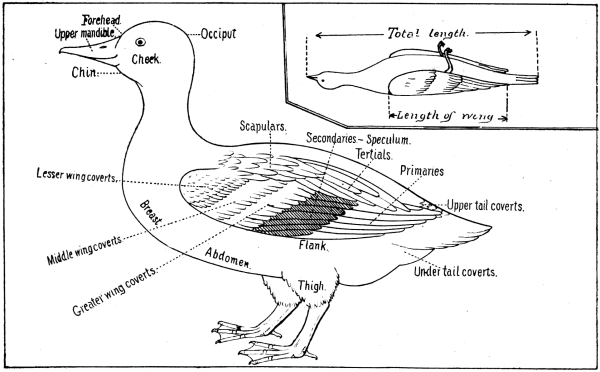
In describing the game birds of the Pacific Coast, I have included all those found in any considerable numbers from the British Columbia line, south to and including the state of Arizona, the Mexican states of Sonora and Chihuahua and the peninsula of Lower California, for in some of these less frequented places, game birds are found in great numbers and great variety. This is especially true in these southern sections with the quail, for here its voice is heard in all the notes of the gamut, from the soft, turkey-like call of the mountain species, the soul-stirring whistle of the bobwhite, or the sharp, decisive "can't see me" of the valley quail, through all the varied changes of the blue quail family, to the low plaintive note of the massena quail of Mexico.
While it is not the purpose of this work to give a scientific classification of the game birds of which it treats, a brief statement of the manner in which they are grouped and classified by the ornithologist will materially assist the reader in the study of those species herein mentioned.
The ornithologist groups all the birds of North America into seventeen "Orders"; each of these including all birds of a similar nature. Some of these orders are divided into two or more suborders, where, while clearly belonging to the order, there is yet a sufficient difference in certain groups of families to justify this further separation. The next division is the "family," which is again divided into "genera," and each "genus" into "species."
Of the seventeen orders of American birds, the scope of this work includes only six; for all of the birds, commonly called game birds, belong to one or the other of the following orders:
The Gallinæ—All gallinaceous, or chicken-like birds. Of this order we only have to consider two families: The Tetraonidæ, composed of the quail and grouse, and the Phasianidæ, composed of the turkeys and pheasants.
The Anseres—Lamellirostral, or soft-billed swimmers, such as the ducks, geese, swans and mergansers, comprising the one family, Anatidæ, which is divided into five subfamilies, with four of which we are concerned, viz.: The Anatinæ, the fresh-water ducks; the Fuligulinæ, the salt-water ducks; the Anserinæ, the geese and brant; and the Cygninæ, the swans.
The Columbæ—This order has but one family, the Columbidæ, composed of the pigeons and doves.
The Limicolæ—This order has seven families, only three of which I have mentioned as being of sufficient interest to the sportsmen of the Pacific Coast to justify a description of them. These are the Recurvirostridæ, composed of the stilts and avocets; the Scolopacidæ, the snipes, curlews, yellow-legs, willits, marlins, sandpipers, etc.; and the Charadridæ, the plovers.
The other two orders, the Herodiones and the Paludicolæ, the first composed largely of the herons, storks, ibises, and egrets, and the latter of the cranes, rails gallinules and coots, afford more pleasure to the sportsman through their stately appearance on his hunting grounds than as game birds. The coots, however, are not considered game by our sportsmen.
It is well to state here also, that ornithologists do not always agree in the classification and nomenclature of birds. One claiming that a certain species or genus should be separated, while others insist that there is no reason for such separation. With the one exception of the California valley quail, I have followed the plan of the American Ornithologists' Union. In this exception I have followed such good authorities as Bonapart, Elliott, Ridgeway and Gambel, and given the California valley quail the generic name of Lophortyx, instead of classing them with the Callipepla, to which belong the scaled quail, a species with no distinction between the sexes.
While the eastern half of the continent has but one genus of quail, the Pacific Coast, including Mexico, is well supplied with five genera and eighteen species, to which may be added four subspecies. Nine species of the genus, Colinus, however, and two of the genus, Callipepla, do not come into the United States.
Properly speaking we have no quail in America, all of our so-called quail being partridges, but the use of the word "quail" has become so common that these birds will, in all probability, be known as quail for all time. But whatever the name, they are resourceful beyond comparison, and gamy to the fullest degree; affording with dog and gun the most enjoyable of all out-door sport.
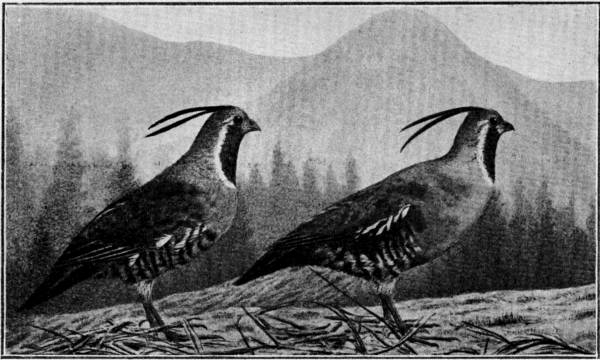 |
|
| MOUNTAIN QUAIL (Oreortyx pictus) |
PLUMED QUAIL (Oreortyx pictus plumiferus) |
The mountain quails are the largest and most beautiful of all the American quails, though the least hunted and the least gamy. There is but one genus, with one species and two subspecies. Two of these inhabit the mountains of California and Oregon, and the third, the high ranges of the peninsula of Lower California. While most of the sportsmen of the Pacific Coast are conversant with the general character and coloration of the mountain quail, I believe but few of them have ever seen the more beautiful species that inhabit the San Pedro Martir mountains of Lower California.
The present species, given the English name of mountain partridge, by the ornithologists, and which he has taken for his type, is a small race found only on the Coast Range from the Bay of San Francisco north into Oregon, and, therefore, never reaches the high altitudes reached by its near relatives, the Oreortyx pictus plumiferus, to which the English name, plumed partridge, has been given. In fact, both of these varieties are plumed, though that of the latter is a trifle the longer. The fact that the plumed quail ascends the mountains each spring to heights of from five to eight thousand feet for nesting purposes, gives it a better claim to the name, mountain, than has the other variety.
The present species, the mountain quail, is generally found in the canyons and on the damp hill-sides where ferns are abundant. They have very little of the migratory habits of the other species, except when driven down in the winter by the snows. Their habits and general plan of coloration are so much like those of the other two species that I shall describe them all together, with the proper mention of wherein they differ.
The range of the plumed partridge is throughout the entire length of the Sierra Nevadas and of the coast range south of San Francisco bay into Lower California, where it intergrades with the San Pedro partridge, but it does not cross the Colorado river and enter Arizona or the mainland of Mexico. This species begins its migrations early in the spring, keeping close to the snow line until they reach altitudes as high as 7000 to 8000 feet, where they nest and rear their young. In [Pg 13] the fall, just before the winter rains begin, they commence their migrations down again to the foothills, where they remain until the following spring. Unless driven by unusually heavy snows, they rarely descend lower than 2000 to 3000 feet above sea level.
The San Pedro partridge, so named by the ornithologist, is a resident of the San Pedro Martir mountains of Lower California, and ascends to a height of ten thousand feet, and is rarely seen lower than five thousand feet above the sea.
I want to say here that no work on ornithology that I have seen, describes the San Pedro partridge properly. Most likely this is the result of an examination of the intergrades only, for they do intergrade with the California species to the northward. The two species first mentioned have the plume from one and a half to two and a half inches long and nearly round in form. The plume of the San Pedro partridge is flat, about three-sixteenths of an inch wide and from three and a half to four and a half inches long. The plume of the other varieties is erectile, but that of the San Pedro denizen is soft and falls down the side. In all species both sexes are alike, with the exception that the plume of the female is generally a trifle the shorter; but this can not always be relied upon to distinguish the sex.
Generally speaking there is not much sport in hunting the mountain quail, but I have at times had a bevy scattered in ferns, and in such cases had very good sport with them with a dog, and found them to lie very well. They are about a half larger than the valley quail, and as a table bird much more succulent.
Color—Top of head, back of neck and breast, an ashy blue, darker on the back of the neck than the breast; back and wings, inclining to olive brown, in the Coast species with a slight reddish tinge; abdomen and flanks, rich chestnut barred with black and white; under tail feathers, black; entire throat, reaching well down onto the breast, rich chestnut, bordered with white; chin, white; bill, black. The two California species have two round, black plumes falling gracefully over the back of the neck, but erectile when excited. These plumes will vary from one and a half to two and a half inches in length. The Lower California species have two flat, black plumes about three-sixteenths of an inch in width and from three and a half to five inches long. Both sexes are alike in all species.
[Pg 15] Nest and Eggs—The nest, like that of all gallinaceous birds, is a depression on the ground, hidden among a bunch of bushes or under a log, surrounded by a few dry leaves. The number of eggs will average about a dozen, rather oval in shape and of a light ochreous color.
Measurements—Length (see diagram), will average about 10 inches; wing 5 1/2, bill about 5/8 of an inch.
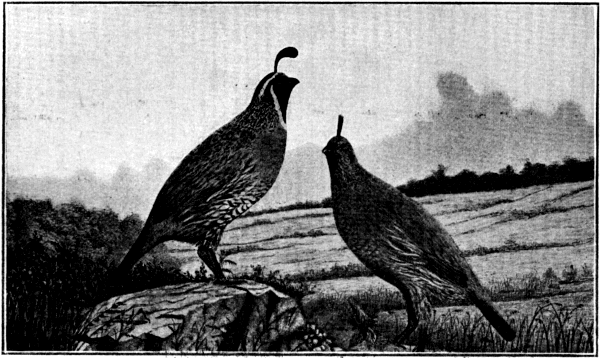 |
| CALIFORNIA VALLEY QUAIL (Lophortyx californicus vallicola) |
There are two varieties of the California valley quail. They are distinguished not so much by the slight difference in color as in the very marked difference in their habits.
As with the mountain quail the ornithologist has taken the wrong bird for the type, making the larger race the subspecies. To the species (Lophortyx californicus) inhabiting the foothills of the Coast range north of the bay of San Francisco and into western Oregon, the ornithologist has given the English name California partridge. This species is a lover of damp places and rank growths of underbrush and ferns. The subspecies (Lophortyx californicus vallicola), to which has been given the name valley partridge, ranges from central Oregon throughout the great valleys of California, the foothills of the western slope of the Sierras, both sides of the Coast range south from San Francisco bay and throughout the peninsula of Lower California. Like the mountain quail it does not cross the Colorado desert into Arizona or the mainland of Mexico. Nevertheless it has a wider range than any other one species of game bird.
Of all the game birds of America the California valley quail is the most resourceful and characterized by the greatest cunning. Having hunted these birds for upward of fifty years and practically throughout their entire range, I freely give them credit for knowing more tricks and being able to concoct more schemes of deception than all the rest of the tetraonidæ combined, and this resourcefulness has led to most of the false statements regarding their behavior and gameness. It has been said by writers, who should know better, that a dog is no use in hunting them because of their disposition to run. Any bird with more game than a fool-hen [Pg 16] will either flush or run where there is no undercover in which to hide, and the valley quail being so often found in dry, open places or chaparral devoid of undercover, will either flush or run until it finds suitable hiding grounds.
But give the valley quail cover in which to hide and it can and will out-hide any game bird except the Montezuma quail of Mexico. In fact it is this remarkable faculty of hugging the ground until it is almost stepped upon that has led, more than anything else, to its false reputation as a runner. The man who hunts the valley quail without a dog—and most of its detractors do—can walk through a patch of good cover with a hundred birds scattered in it for an hour or more and not get up a half dozen. Unlike the bobwhite or the Montezuma quail of Mexico, the valley quail bunches in the fall. These bunches will contain anywhere from two or three broods to two or three hundred individuals, and sometimes even thousands, and they seem to understand that the larger the bunch the greater the necessity for avoiding pursuit. They are fond of the open places and the bare hill-tops and when driven from these, being a brush bird, they very naturally seek the brush. If there is no grass or suitable undercover in which to hide they will continue to work their way through it or double back on their pursuers until hiding places are found, when they will hug the ground so closely that even a good dog must pass reasonably near to them before he will detect their scent. The man who hunts without a dog generally passes through the cover into which his bevy has settled, continues his walk for a mile or more, then sits down, filling the air with a sulphurous streak of strong sounding words as he curses the game little birds for running, while the resourceful little fellows, closely hid, laugh over the security a false reputation has given them.
There has been a great deal written about the ability of quail to withhold their scent, and many theories have been advanced. That all game birds do lose their scent temporarily while passing rapidly through the air I believe to be true, and the valley quail has this faculty strongly added to its other resources. This too often deceives the inexperienced man even when hunting with a dog. Where birds have been flushed into good cover and can not be raised, sit down and take a smoke, if you like, for twenty minutes or half an hour, then cast in your dog and you will be rewarded with point after point, where before your dog failed to detect the slightest [Pg 17] scent. After years of experience with all of the upland birds of the United States and half of Mexico, I do not hesitate to pronounce the California quail the chief of them all in gameness, in resourcefulness, and in its general adaptability to furnish the highest form of upland shooting. But California quail can not be hunted successfully without a good dog.
The food of the adult California quail, according to an investigation made by the United States Agricultural Department, through the examination of the stomachs of 619 birds, taken during every month of the year, except May, consists of 97 per cent vegetable and 3 per cent animal matter, the vegetable varying according to the seasons. During the rainy season, when green vegetation is abundant, grasses and foliage of various kinds form fully 80 per cent of the entire food, while in the dry season it forms barely one per cent. In the dry season weed seeds form as high as 85 per cent of the food; one stomach examined containing 2144 seeds of various kinds. During the harvesting season when there is a good deal of grain on the ground, and during the sowing season, grains form about 6 per cent of the diet. During the season when wild blackberries, elder and other wild berries are ripe, these, with a few grapes and a little of some other fruits, form 23 per cent of the food.
During the first week of the life of the young birds, insects of various kinds make up 75 per cent of their food, but by the time they are a month old their animal food is no greater than that of the old birds.
Color—Male—Forehead, gray; top and back of head, sooty black, bordered with white running around from one eye to the other, and this again has a faint edging of black; throat, black, margined with white; plume, narrow at the base and wide at the top, consisting of six black, V-shaped feathers, each folded within the other and curved forward; back and sides of the neck to the shoulders, deep ashy blue with the feathers margined with black. Back and wings, bluish brown; primaries, or longest wing feathers, dark brown; breast, deep ashy blue, shading into a dirty buff at the lower part of the abdomen; flanks, dirty brown with white markings.
The northern coast species are darker with more of an olive tinge. But all the markings are the same.
Female—The female resembles the male in general color, but without the black head and throat. The lume is dirty brown, about half the length of the male's and nearly straight.
[Pg 19] Nest and Eggs—The nest consists of a depression in the ground carefully hid away in some bunch of grass or brush, and usually contains from fifteen to twenty very light buff or white eggs, often faintly speckled.
Measurements—Length, eight to nine inches; wing, 4 1/2; tail, 4; bill, 1/2.
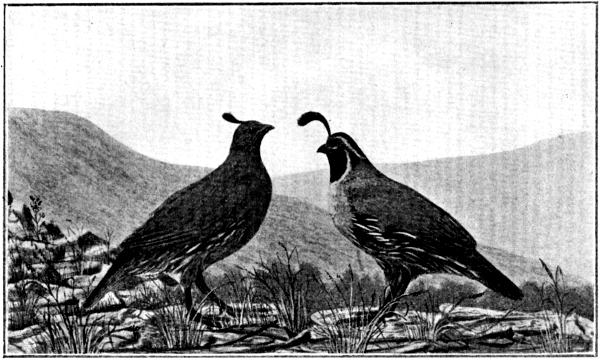 |
| GAMBEL QUAIL OR ARIZONA QUAIL (Lophortyx gambeli) |
The gambel partridge occupies a unique position in its common nomenclature. In California it is known as the Arizona quail, while the sportsmen of Arizona refer to it as the California quail. In this, too, they both have good reasons for the names used, for these birds are found on both sides of the Colorado river, that is in both Arizona and California. Commencing in the Mexican state of Sonora, where they are found from the western slope of the Sierra Madre mountains to the Gulf of California, the range of the species extends northward and eastward through western Arizona, and, crossing the Colorado river onto the desert of the same name, passes through southeastern California into southern and central Nevada and Utah. The gambel quail belongs to the same genus as the two species of the California valley quail and in general appearance resembles them.
The gambel quail is emphatically a desert bird, able to live through the long, dry seasons without water. If there are any trees in its neighborhood it will seek them for roosting purposes, but it is found distributed over vast sections where even the smallest brush is very scattering and under cover nearly quite if not entirely absent, yet in such places this member of the resourceful blue quail family protects itself from hawks and predatory animals with an astonishing success. The gambel quail is a true runner and can develop an astonishing speed for so small a bird. A very large part of the unwarranted reputation of the California valley quail as a runner is derived from confounding it with the gambel and the habit of the Arizona sportsmen of calling the gambel the California quail, but even as great runners as the gambel quail are, I have found them to lie well to the dog in the heavy bunch-grass sections of southeastern California and southern Nevada. I have also had fine sport with them along the bottoms of the Colorado river, where they are to be found in abundance.
[Pg 21] The food is practically the same as the California valley quail.
Color—The general color of the upper parts and the breast is lighter and more of an ashy blue than the valley quail, but in its markings the gambel is the more conspicuous and more brilliant. The black throat, bordered with white, the gray forehead and the forward turned plume are common to both, but the top of the head of the gambel is a bright cinnamon red, while that of the valley quail is a sooty brown. The flanks of the gambel are conspicuously marked with bright chestnut brown with each feather with a narrow central stripe of white.
Nest and Eggs—Are the same in this species as in the valley quail.
Measurements—Same as the valley quail.
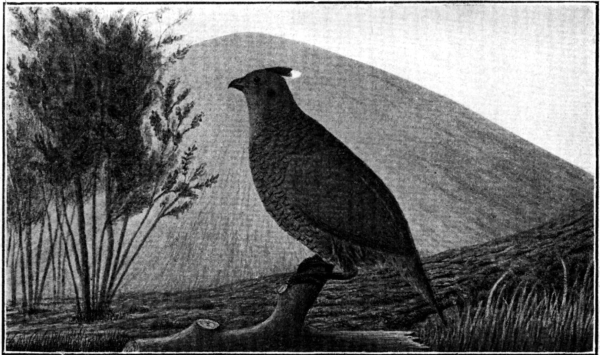 |
| SCALED QUAIL (Callipepla squamata) |
Next in geographical order is the scaled quail of Arizona and northern Mexico generally. This, too, is a desert bird which I have seen in great numbers at least twenty-five miles from the nearest water. It is the only member of the quail family where there is no difference in the markings of the sexes, except the mountain quail. In the open country it, too, is a runner, though it can not begin to develop the speed of the gambel nor will it continue to run for such long distances.
During a residence of a year in the state of Chihuahua, Mexico, where I was developing some mining property, I found the scaled quail in great numbers all around me. Very few of the Mexican people are wing shots and few hunt except for the resulting meat. Little attention, therefore, is paid to the quail, and in the section where I was located I do not believe that even the "oldest inhabitant" of the quail settlement had ever heard the report of a shotgun. I had with me a brace of English setters, and these birds, though found among chino grama grass and low maguey plant, which offered splendid opportunities for hiding, not only tried my patience to the limit, but that of my dogs as well, by deliberately walking about twenty-five to thirty paces in front of me without the least thought of either hiding or taking to wing. By firing a couple of shots over them each morning I soon educated them to flush at the sight of me. In a couple of weeks they behaved very well and furnished me with good sport, hiding readily and lying good for the dogs.
Most of the game birds need more or less educating before they fully meet the requirements of the sportsmen. Most, too, of the complaints that sportsmen make regarding the bad behavior of certain species of game or birds of certain sections should be charged to the lack on the part of the hunter of a knowledge of their habits rather than to the ill manners of the birds. One will often hear it said that certain men are lucky hunters and can not help staggering onto their game. Such men are lucky because they make a close study of the ways of the birds of each separate character of country. Knowing the places in which they will most likely be found feeding, they approach them from such directions as will have a tendency to drive them into the desired cover. A great deal of the annoyance of running birds, I have found, can be avoided by a careful study of their habits and proper management in handling them, and this is especially true of the scaled quail.
Color—The back, the wings and tail coverts are a light, ashy blue, but the feathers of the shoulders, breast and abdomen are margined with dark brown, with a yellowish arrow-shaped central spot which gives them the appearance of scales. Its throat is a very faint buff, and instead of the plume of the genus Lophortyx it has a broad erectile crest with the feathers tipped with white. Both sexes are alike.
Nest and Eggs—The nesting habits are the same as those of the other species of the blue quail family, but the eggs are more of a buff and generally more speckled with brown.
Measurements—About the same as the valley quail.
The chestnut-bellied scaled quail is a subspecies of the scaled quail just described. They are not numerous and hardly enter the territory covered by this work. Intergrades of the two species are occasionally found in northern Mexico and possibly in southeastern Arizona. In general appearance they resemble the former species, being, however, a little darker and with a strong chestnut blotch on the belly.
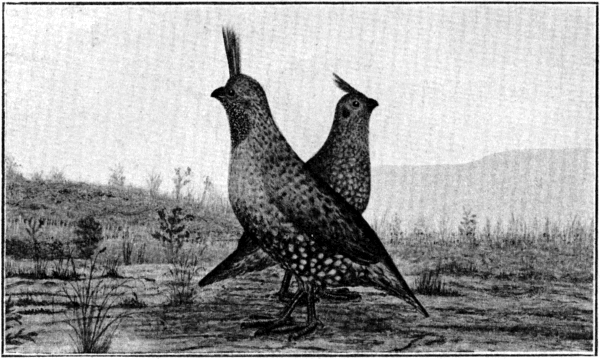 |
| ELEGANT QUAIL (Callipepla elegans) |
Along the western slope of the Sierra Madre range in the state of Sonora, Mexico, is to be found another member of the blue quail family whose habits appeal strongly to the sportsman. This species, known as the elegant quail, is one of the most handsomely marked of the group. From the blending of the white throat of the bobwhite with the black one of the gambel, and the brown of the back of the one with the blue of the other, together with a marked resemblance in its call to that of the bobwhite, suggests the possibility of its origin having resulted from a cross of the two genera. I may add that both the gambel and a species of the Collinus, bobwhite, are found in this same section.
The elegant quail is generally found in and around the cultivated fields which they seem to prefer to the open country. While the elegant quail will walk leisurely in front of their pursuer until too closely approached, they can in no sense be termed runners. When flushed they take to cover and lie closely. Like all the quail of Mexico they have been hunted but little and need to be well scared before they become properly educated to the gun. After a few days' hunting I found them a very satisfactory game bird. Being found around the fields, the grounds and cover were all that could be desired for excellent sport.
Color—Male—Plume straight, upright feathers about an inch and a quarter to an inch and a half in length, varying in color—possibly on account of age—from a light lemon to a dark reddish orange. The throat is finely mottled with small black and white dots, giving it a dark gray appearance. The general color of the back and the wing and tail coverts is a dark blue with about half of the exposed portion of each feather tipped with a bright, rich brown. The breast and abdomen is a light, ashy blue, profusely flecked with large, circular white spots.
Female—The plume is about two-thirds the length of that of the male, brown in color and barred with black. The breast and abdomen are spotted like the male but the back is much the color of the English snipe.
Nest and Eggs—The same as the other species of the blue quail.
Measurements—Same as the valley quail.
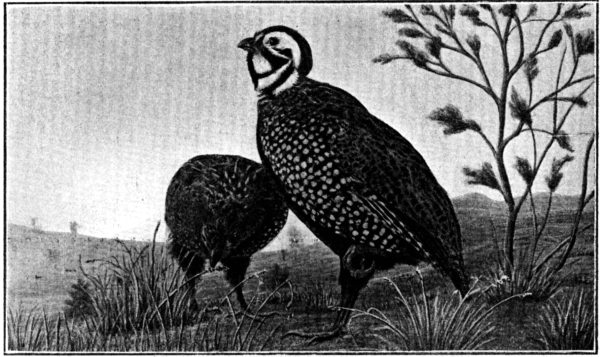 |
| MASSENA QUAIL (Cyrtonyx montezuma) |
The Massena, or Montezuma quail, is a distinct genus from the blue quail family. In many respects it resembles the bobwhite in color, though far more fancifully marked. It is also nearly one-half larger, though in some parts of Arizona and in New Mexico there is a smaller species of the same genus known as fool quail. The Mexican bird is far from a fool, and although it roosts on the ground like the bobwhite, it is resourceful enough to take care of itself in a country where vermin of all kinds are very plentiful. Its range is from near the northern boundary south through the larger portion of Mexico.
The Montezuma quail is emphatically a grass bird and inhabits the grassy foothills and the cultivated fields, where it affords fine sport with a dog. It is very cosmopolitan as to climate, for it is found at altitudes of from five to six thousand feet, where considerable snow falls, as well as in the foothills of the hot, tropical valleys of the lowlands, and thrives equally well in all sections. It is a bird of peculiar habits. When startled by the approach of an enemy the bevy at once huddles together, where the birds remain motionless until they are approached to within from one to four feet, according to the cover they are in. If they think that they have not been seen or that the object of their alarm is going to pass by, there is not the slightest motion made by any one of them, but when they decide to take wing for safety every bird in perfect unison springs into the air to a height of about six feet and darts rapidly away. They are quick on the wing and seem able to carry away a good deal of shot. The flight generally is not more than one hundred yards, and when they alight they scatter well and will then out-hide any bird that lives. I have both ridden and walked, without a dog, for hours through a country where they were plentiful without seeing a bird, except where I chanced to nearly step upon them, yet with a dog I have found on the same grounds probably an average of fifteen bevies to the square mile. For work with a dog I prefer them to any bird I have ever hunted. They give out a strong scent, for points on bevies of from six to fifteen birds, made thirty to forty yards away are no uncommon occurrence. Then when you walk in front of your dog they never flush until you have almost stepped upon them. A scattered bevy will lie securely hid until each individual is flushed.
Unlike the blue quail they never gather in large flocks, but always remain in single broods until broken up in the spring for nesting purposes.
Color—Male—The head of these birds have a very bizarre appearance whose strange black and white markings seem to have no more purpose or design than the black and white chalk marks on a clown's face. The head of the male is crested with semi-erectile feathers in the shape of a broad hood of dark yellowish brown color, falling about half way down the neck; groundwork of the back and of the wing and tail coverts is a dark ocher barred with a deep rich brown; breast and flanks are nearly black, dotted with large white spots, and from the throat to the vent is a stripe about five-eighths of an inch wide of a dark rich chestnut.
Female—The female, with the exception of the white dots on the breast and flanks is much the color of the female bobwhite.
Nest and Eggs—The nest is like that of the quail generally, simply a depression in the ground, carefully hidden away in some thick matted grass or bunch of brush, and generally higher up the hill-sides than they are found at other times. Eggs, white, and of a china appearance, and from ten to fifteen in number.
Measurements—While these birds are fully one-half larger than the blue quail, the very short tail makes their total length not over 8 to 9 inches; wing, 5 inches, and bill, 5/8.
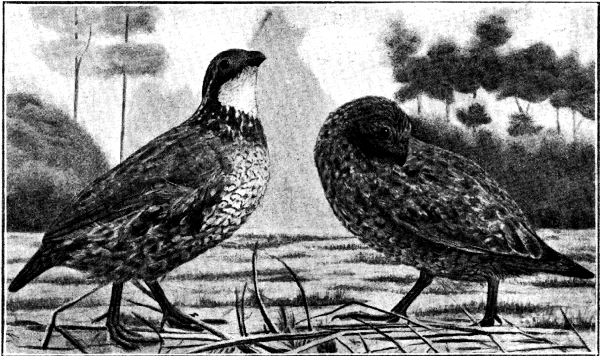 |
| BOBWHITE (Colinus virginianus) |
I have said that the voice of the bobwhite is heard in the land. This is true, for the clear notes of his little throat awaken the morning echoes from eastern Oregon to the islands of Puget Sound. This great little game bird, whose praise has been recounted in volumes of prose and sung in the rhythmic measures of countless lines of verse, is not a native of the coast, but he knew a good thing when he saw it. When he was turned loose in the Pacific Northwest he cast his bright little eyes about him and remarked to himself:
"This looks good to me. Bobwhite, get busy at once in raising big families and settle up your new domain."
And he has done it, for now the sportsmen of the Pacific Northwest have better bobwhite shooting than is to be found in any part of the eastern states.
The bobwhite roosts on the ground and always remains in single broods. When startled they huddle together and flush in a bunch. They are good hiders and lie well to the dog. They are seldom found far from water and rarely in heavy brush. They are fond of stubble or corn fields and the grassy nooks along the fences. Many efforts have been made to acclimatize this species farther south in California but they have all proved failures on account of the dryer climate and the lack of insects during the rearing season of their young. They must have a damp climate where the vegetation remains green, thus furnishing an abundance of insects during the early summer on which to feed their young. For until a bobwhite is nearly grown it lives almost entirely upon insects.
Color—Male—General color of the upper parts, light buff, marked with triangular blotches of brown; head and back of the neck, dark chestnut; forehead, gray; light stripe from above the eye passing down the side of the neck; throat, white or very light buff, faintly bordered with dark brown or black; breast, light buff with the feathers tipped with brown; flanks chestnut mixed with black and white.
Female—Generally lighter, and without the white throat and light breast.
Nest and Eggs—The nests are rude depressions on the ground beneath a fence rail or fallen limb, or in a bunch of thick grass or brush. The eggs number anywhere from fifteen to twenty and of a pure white color.
Measurements—Total length about nine inches; wing, 4 1/2 inches; bill, 5/8.
A smaller species of the bobwhite, known as the masked bobwhite, were reasonably plentiful along the border of southern Arizona and south through the state of Sonora, Mexico. Like the typical bobwhite they were strictly a field and grass bird. But through the heavy pasturing of that section, together with a series of dry seasons denuding the whole country of such cover as would be necessary for their protection from hawks and vermin, they have become nearly if not quite extinct. They differed from the eastern bobwhite in that the male had a black throat instead of a white one and a bright cinnamon breast. The female differed also in having a light buff throat, and generally of a lighter color.
Family, TETRAONIDAE
Subfamily, PERDICINAE
Family, TETRAONIDAE
Subfamily, PERDICINAE
| Genus | Species | Common Names | Range and Breeding Grounds | |||
| Oreortyx | pictus | Mountain quail | Coast Range of California from Monterey Bay north into Western Oregon. | |||
| pictus plumiferus | Mountain quail | Both sides of the Sierra Nevadas from Central Oregon south. Coast range valleys south from San Francisco Bay into Lower California. | ||||
| pictus confinis | Lower California mountain quail |
Peninsula of Lower California, inter-grading in the northern part with the pictus plumiferus. | ||||
| Lophortyx | californicus | Valley quail | Coast Range valleys of California from San Francisco Bay north into Oregon. | |||
| californicus vallicola |
Valley quail | Both sides of the Sierra Nevadas from Central Oregon south. Coast range valleys south from San Francisco Bay into Lower California. | ||||
| gambeli | Gambel quail Arizona quail |
Southern Nevada, Southeastern California, Western Arizona and Northern Mexico. | ||||
| Callipepla | squamata | Scaled quail | Southern Arizona and Northern Mexico. | |||
| elegans | Elegant quail | Southern Sonora, Mexico. | ||||
| Cyrtonyx | montezuma | Montezuma quail Messena quail |
Southwestern Arizona and south into Mexico. | |||
| Colinus | ridgewayi | Masked Bobwhite | Northwestern Sonora, Mexico. | |||
| virginianus | Bobwhite | Introduced and acclimated in Washington and Oregon and the islands of Puget Sound. |
If there is any member of the feathered tribe entitled to the designation of royal game bird, it is the wild turkey. This magnificent bird, whose size and cunning challenges at once the admiration and the skill of the sportsman, is a native of North and Central America, and found in its wild state in no other part of the globe. The ocellated turkey, the Central American species, is even more gaudy in plumage than the peacock, but as it is not found within the territorial scope of these articles, I shall leave its resplendent colors to scintillate in its own tropic sun, undescribed.
Of the North American turkeys the scientist recognizes four varieties. The Meleagris sylvestris of the eastern states, except Florida, the Meleagris sylvestris osceola of Florida, the Meleagris sylvestris elliotti of the Rio Grande district of southern Texas and northeastern Mexico, and the Meleagris gallopavo of Arizona, New Mexico, part of Colorado, and west and south through the larger portion of old Mexico. It is of this last species that I shall write.
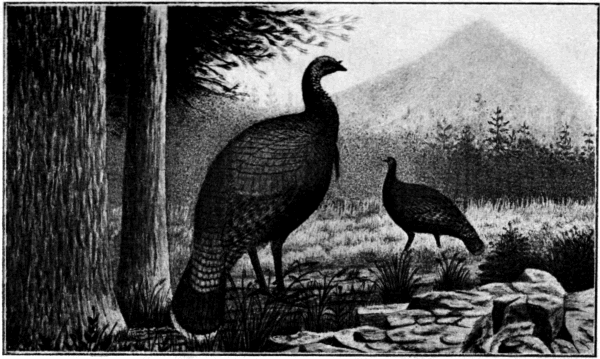 |
| WILD TURKEY (Meleagris gallopavo) |
Outside of the progenitors of our common barnyard fowl, there is no wild bird that mankind has domesticated whose distribution in its domestic state has become so wide as that of the wild turkey, and none have been so highly prized as an article of food. It is from the Mexican wild turkey, Meleagris gallopavo, that all of our domestic turkeys have descended. First captured in Mexico by the early settlers of that country, they were taken to the West Indies and there domesticated as early as 1527, for Oviedo, in his "Natural History of the Indias," speaks of the wild turkey having been taken from Mexico to the islands and there being bred in a domestic state. From the West Indies they were taken to Spain, France and England, and again brought back to America as domestic fowls. In 1541 they must have been scarce yet in England, for in an edict promulgated by Cranmer in that year, the "turkey cocke" was named as one of "the greater fowles," and which "an ecclesiastic was to have but one in a dishe." By 1573, however, they must have become quite plentiful, for in that year Tusser mentions them as the most approved "Christmas husbandlie fare."
Inasmuch as there were no settlements of either English, French or Spanish in America north of Mexico until 1584, or in that section of the country inhabited by the eastern species of wild turkey until sixty years after the turkey is known to have been introduced into England, the common belief that the eastern species (Meleagris sylvestris) was the foundation of the domestic turkey is clearly an error; but the ornithologist does not find it necessary to consult history to determine the origin of the domestic turkey. That distinguishing feature of the Mexican wild turkey (Meleagris gallopavo), the broad, light sub-terminal of the rump feathers, is so strong that even after three and a half centuries of domestication, changes in color through selection in breeding, and possibly crossing to some extent with the eastern and Florida species, those markings, peculiar to it alone, are unmistakably present even in the lightest-colored varieties.
As a game bird the turkey has but few equals. Like most of game birds they are comparatively tame and unsuspicious until after they have been hunted, and learned that of all animals man is their greatest foe and most to be dreaded, for whenever he is within sight he is within the range of his instruments of destruction. I have seen the Mexican wild turkey constantly running or flushing in front of us from morning till night as we traveled through their country for days. They showed but little fear, for while we killed all we could eat, we were constantly traveling, so that those that had been introduced to the white man's methods of destroying were left behind us, and those in front of us had yet the lesson to learn; but when the wild turkey has been hunted a little it becomes about as wary, cunning and resourceful as any bird that flies.
The Mexican wild turkey is the largest of the race, and has been, and is yet, the most plentiful. They are strictly mountain dwellers, not often found in altitudes of less than twenty-five hundred to three thousand feet, and more frequently from four to six thousand, and even up to eight thousand feet or more. They are strictly timber dwellers, usually, if not always, living in the pine forests, for I can not call to mind a single instance where I have found them except where pines of some variety were the principal trees. In size, individuals vary a good deal. So, also, will the general average be found to vary as much as ten pounds in different localities. Generally the higher their habitat the larger the birds, some of the old gobblers reaching forty pounds if not more. I remember killing one in [Pg 34] the Sierra Madres of northern Mexico that I carried about three miles into camp over a very rough country. By the time I got him there I was willing to bet my last "silver 'dobe" that he weighed a ton. I have also killed some very large ones in the San Francisco mountains of Arizona.
The wild turkey, like the mountain quail, has an up and down mountain migration. In the early spring the hens begin to work up the mountains and seek the densest jungles, and of course the gobblers follow them. The gobblers are polygamous, and have but little respect for their families. They will not only destroy the nests, but even the young birds. For this reason the hens are very secretive in nesting, taking as much care in hiding them away from the gobblers as from their other enemies. As soon as the hens begin setting the gobblers gather in flocks and remain by themselves until joined in the early fall by the hens and their half-grown broods. After this the flocks soon begin their migration to the lower hills and mountain openings, and congregate into immense roosts. Places were once to be seen where they had filled the trees for acres in such numbers as to break the limbs in many instances. In those times and localities they were too tame and too plentiful to afford much amusement to the man who hunted them for sport, but with the exception of some places in Mexico that day has passed, and the sportsman who hunts these grand game birds now will find a quarry worthy of his skill and affording him sufficient exertion to whet his appetite for the delicious feast they furnish him.
Both the habits and the habitat of the wild turkey make the sport of hunting them especially enjoyable. As soon as the gobblers are deserted by the hens they become more wary, and the crack of a twig or the sight of a man, be he ever so far away, and they at once seek cover. Then the keen eye and the noiseless tread of the still hunter is called upon for his best and most careful efforts, for the eyes of these gobblers are quick to catch the slightest move and their ears acute to the faintest sound. The curiosity of a deer often makes him hesitate long enough for the opportunity of a shot, but the gobbler, after the hens have left him, is no longer lured by curiosity. His business is to keep out of sight, and he can do it, after he has once learned the destructiveness of man, just a little more successfully than any other bird or animal that I have ever hunted.
There are no wild turkeys west of the Colorado river, [Pg 35] nor on the peninsula of Lower California; but there can be no reason to doubt that, had the mountains of Arizona connected with the pines of the Coast range in San Bernardino county or with the Sierras of Inyo or Kern, the mountains of California would have been as well supplied with turkey as are its valleys with quail.
Color—The color of the wild turkey varies very much except in those that are found in the higher mountains and far away from civilization. Domestication of over three hundred and fifty years has not yet robbed the turkey of its love for the wild and they are often seen long distances away from the farms feeding contentedly. In countries where the wild turkey still existed these tame varieties of various colors have mixed with them, often to such an extent as to change the color very materially. I have seen flocks in Mexico ranging close to ranch houses with turkeys among them so light-colored that they were no doubt tame birds that had wandered away with their wild progenitors.
The wild turkey of Mexico, Arizona, New Mexico and Colorado is a dark bronze bird with a light-colored rump, caused by the upper tail coverts being tipped with a broad sub-terminal band of white, narrowly tipped with black. The tail feathers are dark brown, spotted with black and tipped with white.
Nest and Eggs—The nest of the wild turkey is generally in a depression in the ground, high up on the mountains, and carefully hidden away in some dense thicket. I cannot call to mind ever seeing but two nests. One of these had but seven eggs while the other had seventeen. The markings are the same as those of the tame turkey.
Measurements—The total length varies from three to four and a half feet; wing 18 to 24 inches.
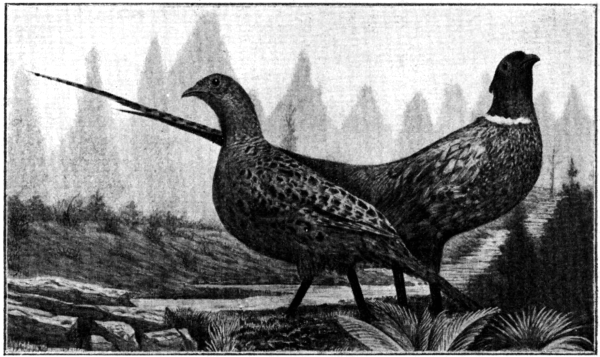 |
| MONGOLIAN PHEASANT (Phasianus torquatus) |
While the wild turkey is the only representative of the Phasianidæ found native to the American continent, the Mongolian pheasant has been so successfully acclimatized in Oregon and Washington that it must now be recognized as an established resident species.
After it became an established fact that these pheasants were proving a success in Oregon, there became a demand for their introduction into California, and thousands of dollars were spent for a number of years in an unsuccessful effort to acclimatize them.
The pheasant, like the grouse, is a cold country bird, and the mild and dry climate of California does not appeal to their peculiar tastes or the requirements of their physical being. Oregon, however, possesses the climatic, floral and entomic conditions for which nature has fitted them. Green vegetation lasts during the whole season in which they rear their young, thus furnishing them with that abundance of insects necessary to the health and nourishment of the young chicks. They are endowed with certain physical attributes for which the cold of winter is necessary to preserve a continued healthful condition, and this, too, they find in Oregon. In fact this constitutional demand for the cold of winter has been by nature so strongly implanted within them that the rearing of thirty generations in the comparatively mild climate of Oregon has not effaced it, and obeying this primal instinct they have migrated through Washington and into the better-loved and colder winters of British Columbia.
Therefore, while California undoubtedly may have an abundance of wild turkeys, quail in unlimited numbers and of two or three more species than we have at present, the timber and the plain tinamus of South America, and possibly the sand grouse of southern Europe, she will never have pheasants unless they be of the extreme southern varieties, and never have more than a limited supply of grouse.
North of the mountains of southern Oregon and through Washington into British Columbia pheasants are plentiful and furnish the principal sport of the lovers of upland shooting of that section of the Pacific Coast. The Mongolian pheasant as a game bird has his merits and demerits. As a large, beautiful plumaged bird to grace the game bag the pheasant stands without a rival. As a table bird the pheasant is only surpassed in delicacy of flavor by the wild turkey. As an aggravating runner from the dog the pheasant is in a class by itself, and as an evader of all pursuit when wounded, "the Chinaman," as they are generally called in Oregon, can give odds to the gambel quail. Though the pheasant is a large bird and able to carry off a good deal of shot, it starts so slow to one accustomed to the rapid flight of the California quail that a reasonably fair shot will find no difficulty in getting the limit with a sixteen gauge.
They are slow starters, caused by their habit of rising at an angle of forty-five to fifty degrees until they reach a height of about ten feet before their rapid flight begins, [Pg 38] but when once on the wing they are quite swift flyers.
While I have said that the pheasants are aggravating runners, this is principally so in the latter part of the season. In the earlier parts they are commonly found in the stubble fields, potato and other vegetable patches, and usually in single broods. At such times I have found them to lie quite well to the dog, not flushing until closely approached, and running but little except when winged. They are then easy shooting, but the fine size of the bird and the beautiful plumage of the cocks give a zest to the sport and a pleasant distinctiveness which every sportsman will be pleased to add to the list of upland shooting he has engaged in.
To those who wish to spend a season on these handsome birds, Oregon, especially, offers an attraction which goes far beyond its good supply of pheasants. During the open pheasant season the climate of Oregon is as near perfect as one can ask. That season of the eastern states that has been idealized in verse, and is known as Indian summer, finds its superlative in the early fall of Oregon. The sun shines brightly, but with its rays softened by its sub-equinoctial position; the air is mild, clear and invigorating, and the golden hues of the stubble field, the yet bright green of the grassy pastures, the rich tints of the dying autumn leaves, all framed in the blue-green fringe of the near-by pines and firs, produce a picture strikingly beautiful and always enjoyed. It is in this delightful season with such a picture on every side, heightened by an occasional glimpse of some towering mountain peak with its crown of eternal snows, that the sportsman of Oregon lays aside the cares of life and lives in an elysium during his pheasant-shooting days. The setting of the stage is as much to the play as the acting. So with our days after game. The invigorating air we breathe, the beauty of the landscape, the stateliness of the forest, the rugged grandeur of the mountains, the soul-inspiring picture of our dogs on point and back, lends more to the real enjoyment of the day than does the size of the bag we carry home.
Color—Male—The male of the Mongolian pheasant can not be confounded with any other game bird in America. Its very long tail feathers—from fifteen to twenty inches—will always prove a distinguishing mark. Its rich metallic colors of black, cinnamon, chestnut and ocher give it a combination of hues surpassing that of any other of our game birds.
Female—Nor should the female ever be mistaken for any other bird. It partakes much of the general colors of the male, but much subdued and more of a general ochreous hue, the plumage being buff mottled with brown. The tail, however, is not more than one-fourth the length of that of the male.
Nest and Eggs—The nest is generally a depression on the ground, but often in the hollow of some log. The eggs number from 12 to 18 and are of a dark ochre in color.
Measurements—The measurements of a Mongolian pheasant are practically useless on account of the larger portion of it being the tail, which greatly varies in length.
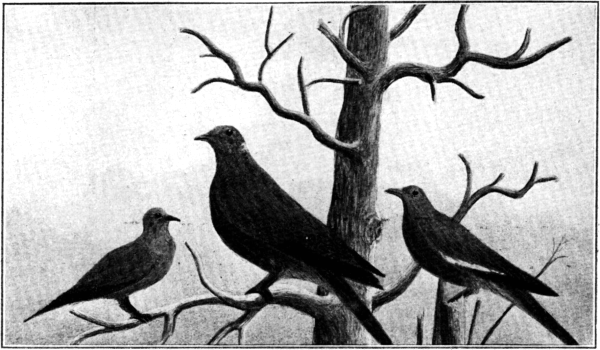 |
|||
|
The family Columbidæ is represented on the Pacific Coast by three genera which are considered, to more or less extent, legitimate game, though they can not be termed game birds in the generally accepted use of the term. Still as they are hunted to a very considerable extent by the sportsmen of the Coast, they rightfully belong in a work of this kind. I shall, therefore, give them a place, and briefly treat each species that is pursued as game within the territory under consideration.
The wild, or banded pigeon, is a mountain dweller, found principally in the southern half of the territory covered by this work. They visit the valleys in the fall and winter months to feed on the oak mast, and at such times they are seen in large flocks in the Sacramento, San Joaquin and coast valleys of California. They are found in good numbers in parts of Arizona, and are common along both sides of the Sierra Madres of Mexico. When visiting the valleys they afford good sport, as they are swift flyers and capable of carrying off a good deal of shot. They have no migrations like the passenger pigeon once so plentiful in the eastern states, nor do they congregate in such immense flocks.
[Pg 41] Color—About the same as the darker colored tame pigeon; the tail is a trifle longer than the tame bird and a little lighter than the rest of the plumage with a dark band across the middle of it; a small patch of white feathers at the back of the head. Both sexes are alike.
Nest and Eggs—The nest is built in the trees of small twigs and grass. Two eggs are layed at a time, and a pair of young birds are produced about every six weeks from April to August.
Measurements—A trifle more than the tame pigeon.
The mourning dove is a cosmopolitan species found in greater or less numbers in all sections. They have a slight migratory movement from the higher to the lower altitudes, but they cannot be called a migratory bird. A large number of these birds begin their nesting season in the mountains at altitudes of from 2000 to 4000 feet, raising one brood at that height, then moving down and nesting again, and moving again until they reach the lower valleys, where they remain all winter, congregating in certain places in flocks of hundreds. Many, however, remain in the valleys all the year and nest around the fields and along the streams.
The mourning dove is so well known in every country that a description of it is unnecessary.
Nest and Eggs—The nest is generally built in the small trees and lined with any soft article that they can find. The eggs number two and a pair of the young birds are hatched about every six weeks from May to September.
The white-winged dove is nearly one-half larger than the common mourning dove. They range from Mexico through southern Arizona to the Colorado desert in southeastern California. In some parts of Arizona and in Mexico they are found in large numbers, and afford good shooting. Their habits are the same as the common dove, both as to food and nesting, though in parts of Mexico it nests in the pitahaya plants—a species of cactus—of whose fruit it is very fond.
This species can easily be distinguished from any other member of the dove family by the broad patch of white on the wings.
Family, TETRAONIDAE
Subfamily, TETRAONINAE. (Grouse)
| Genus | Species | Common Names | Range and Breeding Grounds | ||
| Bonasa | umbellus sabini | Oregon ruffed grouse | Western Oregon and Washington and Northwestern California. | ||
| umbellus togata | Canada ruffed grouse | Eastern sides of Cascade Mountains in Oregon and Washington, thence East. | |||
| Centrocercus | urophasianus | Sage hen | Northeastern California, Nevada and the sage lands of Oregon and Washington. | ||
| Dendragapus | franklini | Spruce grouse | Western slope of the Cascade Mountains. | ||
| obscurus | Dusky grouse | Northeastern Arizona and Eastern Nevada. | |||
| obscurus fuliginosus | Sooty grouse | Coast Range and Sierras from Southern California to British Columbia. | |||
| Pediocaetes | phasianellus columbianus | Sharp-tail hen | Eastern Oregon and Washington and a few in Northeastern California. |
Within the territorial scope of this work there are seven species of the grouse family, though only four of these are in any way common. As the wild turkey is confined to the southern extremity of the Pacific Coast hunting grounds, so are the grouse principally found in the northern sections. I have met with a few dusky grouse (Dendragapus obscurus) in the mountains of Arizona, but they are by no means plentiful. There were a few and possibly is yet an occasional sooty grouse (Dendragapus obscurus fuliginosus) in the mountains of southern California, but grouse in sufficient numbers to furnish any kind of sport are not found much south of Yosemite valley in the Sierras, or south of Humboldt county in the Coast range. An occasional pair or small flock, however, may be met with considerable south of the points named.
The grouse is a northern bird, extending into far colder regions than any other subfamily of the gallinaceous group. The ptarmigan, of course, are grouse.
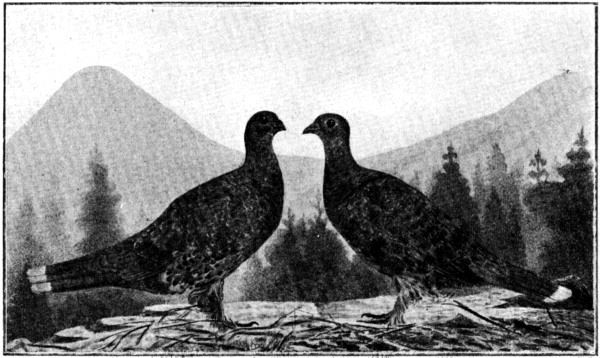 |
| SOOTY GROUSE (Dendragapus obscurus fuliginosus) |
The sooty grouse, commonly called blue grouse by the sportsmen of California, are reasonably plentiful in the Sierras from the Yosemite north into Oregon, where they are quite plentiful, and from there through Washington into Alaska. It is a mountain dweller, being found at altitudes fully 9000 feet above the sea. In the winter it descends to lower latitudes, but seldom below 3000 feet. It is naturally a confiding bird where it has not been hunted much, and for this reason has been given the name, "fool hen," in many localities. But like most of the feathered tribe, it soon learns the destructiveness of man, and after gaining this knowledge it is quite able to take care of itself. When flushed it flies with a cackling sound, generally taking refuge in the tall pines, where it is an expert hider. In the nesting season it produces a drumming sound and struts like a turkey. This drumming is produced by inflating an air sack on each side of the neck. Later in the season these sacks dry up and nearly disappear. It's only migrations are ascending and descending the mountains with the seasons.
According to a published statement of the Section of Biological Survey of the United States Department of Agriculture, the food of the sooty grouse consists of [Pg 45] buds, seeds, leaves and insects, of which 68 per cent is leaves, buds and the tender ends of young twigs; 6.73 per cent insects and the balance seeds, berries and the like. The flesh is generally of a fine flavor, though at times it will be found to be tainted a little strongly with the flavor of the pine.
Color—Male—Back of head, back of neck and all upper parts, a sooty brown; light streak over the eye and a light throat; breast, a dead or sooty black; the rest of the under parts a slaty gray; tail tipped with gray.
Female—Generally lighter in color but otherwise resembling the male.
Nest and Eggs—The nest is usually nothing more than a depression in the ground among dried leaves or grass, well concealed from view. The eggs, which average about a dozen, are of a cream color, spotted with brown.
Measurements—Total length, from 18 to 22 inches; wing, 9 to 9 1/2. The weight will vary from 2 1/2 to 4 pounds.
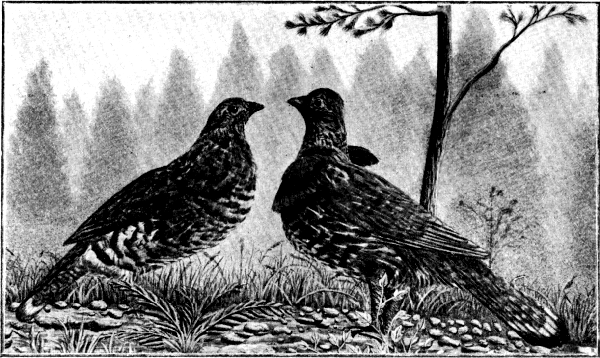 |
| OREGON RUFFED GROUSE (Bonasa umbellus sabini) |
The Oregon ruffed grouse is the handsomest species of the ruffed grouse genus, and is truly a beautiful bird with its deep, rich browns, orange and black. The eastern species of this genus is wrongly known in the north Atlantic states by the name of partridge, and as wrongly called pheasant in Virginia and some other of the southern states. The Pacific Coast species ranges from northern California along the Coast range through Oregon, Washington and far into British Columbia. It is a wary bird, full of cunning and gamy qualities. The male of this genus is, I believe, the only member of the grouse family that drums all the year; all others confining their drumming to the nesting season. This drumming is made with the wings and not by the inflation of an air sack as with other species. The sound, also, is much different, having more of a rolling reverberation. In the spring they will take their position on some rock or dead log and strut back and forth with their heads thrown back and their tails spread out to show the beautiful hues of the feathers and drum for hours to attract the hens or challenge the other males to an almost life and death combat, in which they fight in the same manner as the game cock. They live among the pines, usually near some little opening where they are fond of feeding. When startled they take at once to the timber and are quickly lost to view. For this reason dogs are almost useless in hunting them. They are never found in numbers greater than a single brood, even though the brood may be decimated by the gun of the sportsman or the cunning of the vermin to no more than two or three.
The flesh of the ruffed grouse is white and generally tender and of fine flavor, although in the late fall or winter when its food consists almost wholly of fir buds it tastes quite strong of turpentine. Its food generally is about the same as the sooty grouse and in about the same percentages.
Color—Head, light chestnut, the feathers on the top being long and capable of erection when excited; a tuft of long, rich brown feathers will be found on each side of the neck; back, reddish chestnut mottled with black; rump and tail-coverts, more of a cinnamon color blotched with dark brown; flanks, lighter and barred with black; tail, rusty brown barred with deep brown and tipped with two bands of gray, separated by a streak of black; under tail-coverts, orange, barred with black and tipped with white; wing feathers, brown with a central stripe of light yellow.
The female is marked the same but somewhat lighter in coloring.
Nest and Eggs—The nest, like that of all the gallinaceous birds, is made on the ground and hidden away in some thick cluster of brush or beneath some log. The eggs are of a buff color spotted with dark brown, and number from ten to fifteen.
Measurements—Total length from 16 to 19 inches; wing about 7 or 8 inches. Weight about 2 pounds.
The Canadian ruffed grouse ranges through the eastern side of the Cascade mountains of Oregon and Washington, but does not pass over to the Pacific side. It resembles the Oregon ruffed grouse very closely except that it is much lighter in color, and the female either lacks the tufts of feathers on the neck entirely, or where present, they are very small. Like the Oregon species it is a dweller in the heavy timber, and follow the same habits in most all respects. It is of a more confiding nature, however, often sitting unconcerned upon a tree while several of its companions are being shot, making no effort to get away or save itself from the same fate.
Color—The color of this species is more of a grayish brown than the Oregon species, and lacking that rich chestnut that adds so much to the beauty of the latter. The brown markings, however, are possibly a little more conspicuous. The upper tail feathers are more of a blue, mottled and barred with a blackish brown. A large tuft of feathers on each side of the neck of a smoky brown, edged with metallic green. Unlike the Oregon species these feathers are entirely absent or very small on the female.
Nest and Eggs—The nest and eggs are the same as the Oregon grouse.
Measurements—In size the two species do not vary to any considerable extent.
The spruce or Franklin grouse of Oregon and Washington is a species of the Canadian spruce grouse, and ranges diagonally through the mountains of eastern Oregon and Washington, and thence to the coast of British Columbia. It confines its habitat to the higher mountains, being seldom found below an elevation of four to five thousand feet. This is another of the grouse family that has been given the name of "fool hen," on account of its naturally tame nature. When sitting on the limb of a tree, but a few feet above the ground, it considers itself safe from all harm and makes little effort to escape, and may often be killed with a stick. There is little sport in shooting this variety. The food of this species, like all other mountain dwelling grouse, is buds, tender shoots and seeds, berries and insects when obtainable.
Color—Male—Upper parts gray, the central back and the wings having a brownish hue; the tail-coverts, which are tipped with broad splashes of white is a distinguishing feature of this species; feathers, on the flanks tipped broadly with white, throat, black, imperfectly edged with white; tail, nearly square at the end and of a brownish color.
Female—Considerably more of an ochreous cast. It has the same characteristic broad white tips on the feathers of the flanks; tail, dirty ochre, mottled with black and narrowly tipped with white.
Nest and Eggs—The nest is a depression in the ground in some secluded place and lined with leaves or grass. The eggs, averaging about a dozen, are of a reddish buff mottled with brown.
Measurements—Total length about 15 inches; wing about 7 inches. Weight from one and a half to two pounds.
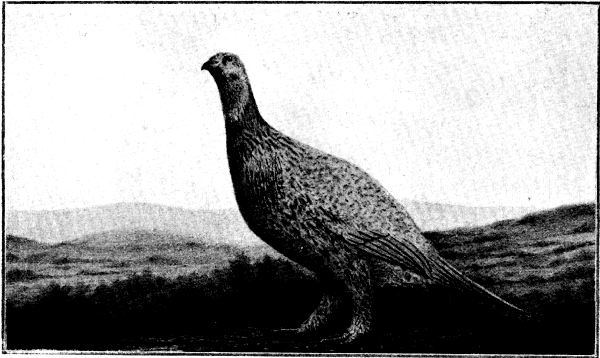 |
| SAGE COCK (Centrocercus urophasianus) |
The sage grouse, or sage hen is the largest of the grouse of America, some of the males weighing as much as seven pounds. Its range, so far as the geographical scope of this work is concerned, is northeastern California, Nevada, and eastern Oregon and Washington, but it extends much farther east. It is only found in the sage brush districts of the high altitudes. They usually remain in single broods, though they are sometimes found in much larger flocks. They often travel for considerable distances, "following the leader" in single file. They strut in the nesting season, but in a peculiar way, pushing their breasts on the ground until the feathers are worn off and even the skin abraded.
A peculiarity of the sage grouse is that it has no gizzard, but instead it has a stomach more like that of an animal. The young birds lie quite well to a dog and furnish very good sport, and until they are about half grown the flesh is quite good, but the older birds are very unsavory and in fact almost unpalatable. This is caused by their feeding almost entirely upon the leaves of the sage.
Color—Male—Upper parts, gray, barred with brown; tail, very long, the longer feathers being quite narrow and stiff and barred also with brown; a dark line over the eye and a light one from the eye down the side of the neck; throat and cheeks, nearly white, mottled with black; a few long hairy like feathers grow from the side of the neck of the male birds.
Female—The female is colored and marked like the male but considerably darker, is much smaller, with shorter tail and without the hairy feathers on the side of the neck.
Nest and Eggs—The nest is nothing more than a hollow in the midst of some bunch of brush, possibly lined with a few leaves. The eggs are from twelve to eighteen in number and of a greenish shade, mottled with bright brown, but these spots are easily rubbed off.
Measurements—Male—Total length from 24 to 28 [Pg 52] inches; wing, 12 to 14. Weight, from four to seven pounds.
Female—Total length, from 20 to 22 inches; wing, 10 to 12. Weight, from three to five pounds.
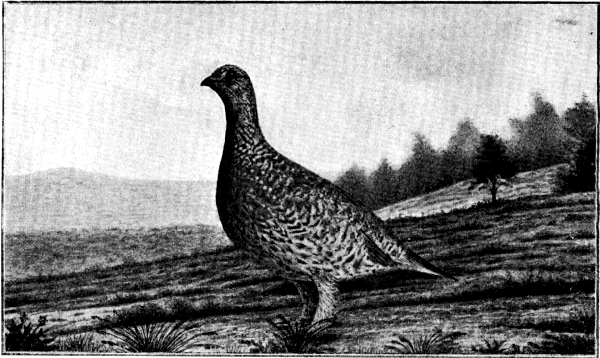 |
| SHARP-TAIL GROUSE (Pediocætes phasianellus columbianus) |
The Columbian sharp-tailed grouse is the "prairie chicken" of eastern Washington. It is far different from the pinated grouse (Tympanuchus) of the middle states, commonly called prairie chicken. Its habitat is much the same, however, being the open plains and untimbered foothills east of the Cascade mountains in Washington and through eastern Oregon into northern Nevada, and the extreme northeastern corner of California. The sharp-tail grouse has the same habit of strutting in large groups like the prairie chicken at the beginning of the nesting season. They do not drum, however, like the eastern bird, but make a noise more like an attempt to crow. They also take refuge in the timber for protection from the storms of winter.
During the hunting season they lie well to a dog and afford fine shooting. The food of the sharp-tailed grouse consists of about ten per cent insects, the balance being made up of seeds, grains and berries, with a good percentage of "brouse" in the winter.
Color—Male—Side of head and throat, pale buff with mottlings of brown on the cheeks; back and wings, gray, mottled with black; breast, light buff. Under parts, white with lines of dark brown; central tail feathers long and pointed; no long feathers on the neck.
Female—Resembles the male with the exception that the tail feathers are not so long.
Nest and Eggs—The nest is a rude affair on the ground, lined with a little dead grass and generally contains from ten to fifteen eggs of a greenish buff speckled with fine dots of brown.
Measurements—Total length from 14 to 16 inches, with the wing about eight; the central tail feathers are about five inches in length. The average bird will weigh about two pounds.
| Genus | Species | Common Names | Range. (All breed far north.) | |||
| Chen | hyperborea | White goose (large) | From Southern California north. | |||
| rossi | Ross' goose Small white goose |
From Mexico north. | ||||
| Anser | albifrons gambeli | White-fronted goose Gray goose |
From Mexico north. | |||
| Dendrocygna | fulva | Fulvous tree duck Mexican tree duck Cavalier |
From Central California south through Mexico. Breeds from Central California to Central Mexico. | |||
| Branta | canadensis | Canada goose Honker |
From central Mexico north. | |||
| canadensis hutchinsii |
Hutchins' goose | From Southern California north. | ||||
| canadensis occidentalis |
White-cheeked goose | Inland plains from Central California north. | ||||
| canadensis minima |
Black brant Cackling goose |
From Southern California north. | ||||
| nigricans | Black sea brant | On certain bays from Magdalena, Lower California north. | ||||
| Philacte | canagica | Emperor goose | A rare visitor south of Humboldt Bay, California. | |||
| Genus | Species | Common Names | Range. (All breed far north.) | |||
| Olor | columbianus | Whistling swan | From Oregon north. Rarely as far south as Central California. | |||
| buccinator | Trumpeter swan | From Southern California north. | ||||
The great variety of the waterfowl of the Pacific Coast, the wonderful numbers in which they are found and the excellent shooting they afford, forms a subject, which, to do it justice, would require the space of an ordinary volume.
With the exception of the Gulf tier of the Southern states, waterfowl on the Atlantic Coast are but birds of passage, tarrying for a time on their way to milder winter quarters; tourists loitering for a day or two at attractive by-stations as they wing their way south in the fall and again on their return north in the spring. They are leaving the isolation of the far north or the mountain lakes and marshes where they spent the summer rearing their young and they are seeking more favorable feeding grounds in the milder climate of the South, where animal and vegetable life is not in the state of hibernation which prevents it from furnishing them with an abundance of food during their southern sojourn.
Over the larger portion of our hunting grounds what is the beginning of the calendar year is in fact the beginning of our spring. When the frost king lays his hand upon all vegetable and insect life in the East, spreading his white shroud over field and pasture and breaking with his icy sleet from the vine and the brush their clinging leaves; when from the trees have fallen the last vestige of their autumnal crowns of gold and crimson; when the last flower has shed its petals; when the last hum of insect is heard and the last song of bird has died away on the southern horizon—'tis then the early rains of the Coast start the new sown grain in the fields, give life again to the grasses of the plains, carpet the foothills and the valleys with the gold and purple and crimson of innumerable flowers, and our veritable spring commences.
With us, therefore, waterfowl are not passing pilgrims, tarrying for a few days only as they rest and feed on their way to the open waters and green pastures in which they intend to pass those months marked winter on the calendar of the year. They are not mere hurrying flocks alighting now and again as they wing their way back to their breeding grounds in the spring But ours is the Mecca to which they journey; ours the feeding grounds on which they assemble from the lakes and marshes of the Arctic; from the whole chain of the Aleutian Islands; from the inland seas of British Columbia and from the mountain lakes of our own Sierras from Washington to Mexico. Here on the bays, estuaries and marshes of the coast and the lakes and ponds of the valleys, throughout the whole length of these hunting grounds, countless millions of these birds have found their winter feeding grounds for unnumbered ages. No cold, no ice, no snow, no howling blizzards to stop them in their search for food or disturb their midday rest upon our quiet waters. In warmth they feed upon the tender shoots of the young grasses that fringe their watery haunts or bask in sunshine on the sandy shores.
It is the popular impression that all ducks breed in the far north and migrate from there south. One has only to shoot on the lakes of Mexico to learn how erroneous this impression is, for one will meet varieties quite common there that rarely if ever reach the southern boundaries of the United States.
The masked duck (Nomonyx dominicus) is a purely southern species reaching Mexico only in its breeding season. The three species of the Mexican tree duck, quite common in that country, come but little into the United States. One of these, the black-bellied tree duck (Dendrosygna autumnalis) migrates to some little extent into Texas and to less extent into New Mexico and Arizona. The fulvous tree duck (Dendrosygna fulva) extends its migrations still farther north, breeding to considerable extent in Arizona and southern California, but rarely seen as far north as the center of the state. The other species of the genus (Dendrosygna elegans), for which I know no English name, is even rare as far south as southern Jalisco. The cinnamon teal is a southern duck, breeding in Arizona, Texas and southern California but so rarely seen north of San Francisco that a gentleman who had killed a straggler near Marysville, when showing it to me, said that he couldn't find a man in the town who could tell him what it was. Yet the cinnamon teal is very common in Mexico and Arizona and quite plentiful in southern California in the spring, before the flocks break up and the birds seek their nesting places.
Northern bred ducks and purely northern species visit us in great numbers during the winter months, and to these must be added the vast number of these birds that breed in the mountains throughout our hunting grounds.
The ornithologist divides the ducks into two subfamilies; the fresh-water ducks forming the subfamily, Anatinæ, and the salt-water ducks the subfamily, Fullgilinæ. These two families can easily be distinguished by their feet. If a salt-water duck, the hind toe will be found to have a small web or flap on the under side, but if the bird belongs to the fresh-water group, the toe will be as clean as any land bird.
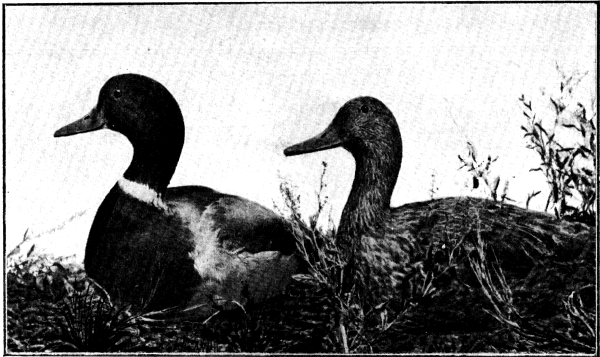 |
| MALLARD (Anas boschas) |
The mallard is possibly the best known duck in America, it being found in greater or less numbers everywhere from the Arctic to Central America. It is a resident species throughout the Pacific Coast, breeding on the mountain lakes and streams from Mexico to Alaska, and even to a considerable extent on the lower marshes of California, Oregon and Washington. On the fresh water ponds and overflows they congregate in great numbers during the winter months and a bag limit of twenty is no uncommon thing. Like all of the fres-hwater ducks of this Coast, they, too, are often found in considerable numbers on the tide lands and salt marshes.
The mallard of the Pacific Coast can hardly be said to be a migratory duck, for it breeds from Mexico north. Its migrations consisting more of altitudinal movements than of longitudinal. While it breeds on the mountain lakes of Mexico, it is rarely seen in the higher altitudes during the winter months.
Hybrids between the mallard and the pin-tail and the mallard and the widgeon have been occasionally met with on the marshes of the Coast. This is most likely caused by the mating of cripples that had not the strength to make the flight to their usual breeding grounds.
Color—Male—Head and neck, dark green with a metallic luster; white ring around the neck at the bottom of the green; back, gray; breast, chestnut brown; under parts dirty white; tail, black with two feathers curled upwards; speculum, (see diagram) purple, bordered with black and white.
Female—Head, dark buff; breast, lighter buff with brown mottlings; legs, orange colored; speculum same as the male; bill, yellow, blotched with brown.
Nest and Eggs—The nest is placed on the ground and lined with grass, feathers and down. The eggs number eight to a dozen and are of a greenish tinge.
Measurements—Male—Total length, from 20 to 25 inches; wing, 10 to 12 inches; bill, 2 1/2 inches.
Female—Total length, from 18 to 20 inches; wing, 9 to 10 inches; bill, 2 to 2 1/4 inches.
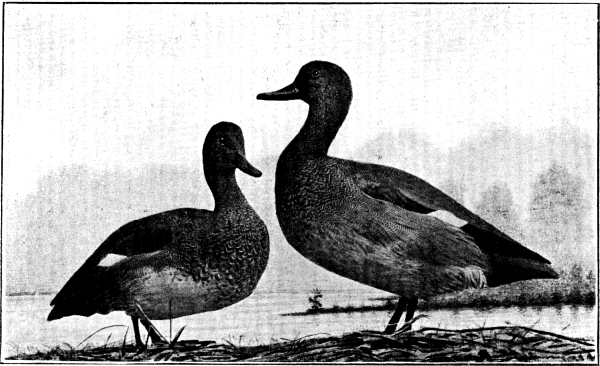 |
| GADWALL (Anas strepera) |
The gadwall was at one time quite plentiful on the shooting grounds of California, south of San Francisco; but, on account of our season opening later and closing earlier than in years past, few are killed now. The gadwall is really a southern duck, coming into the United States to breed. When the California season opened on the first of September and closed the first of April, there were plenty of gadwall found on its ponds in the early fall and late in the spring. Now, but few are killed except in the southern part of the state. Such as are killed are generally found on the mountain lakes and ponds of the higher valleys. On the waters of Mexico and Lower California, however, they are met with in good numbers.
The gadwall, however, migrates as far north as British Columbia for breeding purposes as well as breeding on the mountain lakes of all the territory through which it ranges.
Color—Male—Head, light brown, finely mottled with dark brown and black; neck and breast, finely streaked with wavy black and white; under parts, grayish white; rump and tail, black; speculum, black and white, with the lesser wing-coverts chestnut; feet, orange, and bill nearly white.
Female—Closely resembling the male but with very little chestnut on the wings.
Nest and Eggs—The nest which is usually made a little way back from the water is lined with dead grass, and contains from ten to twelve eggs of a light buff color.
Measurements—Total length, about 19 inches; wing, 10, and bill, 1.60.
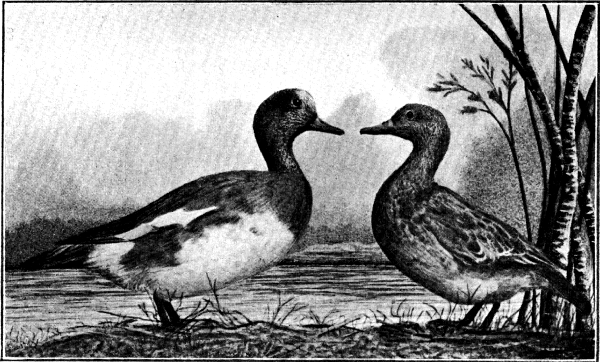 |
| WIDGEON (Anas americana) |
The widgeon is one of the most common ducks of the Coast, both north and south. As well as being one of the most plentiful of the interior lakes and ponds, they are found in great numbers on the salt marshes and tide overflows, and even form great dark patches on the ocean as they take their midday rest on its bosom a mile or so beyond the surf. They breed on the mountain lakes and streams all along the Coast from Mexico north.
The widgeon begins its migrations early in the fall and great numbers find their way as far south as the Coast marshes and lower lakes of Mexico. They feed largely on the plains and frequent the fields in search of grain. In migrating or flying from pond to pond they usually go in quite large flocks.
Color—Male—Head, pinkish white on top, with a greenish streak from the eye back to the ociput; below this the head and neck are speckled with black and white; back and wing-coverts, gray with fine markings of black; breast, a light brick red with a purplish cast; speculum, black and green. Axillars, white with dark shafts.
Female—The female resembles the male in all but the green on the head and the reddish color of the breast.
Nest and Eggs—The nest is generally built in some tuft of grass or thick weeds near some water's edge. The eggs average about a dozen and are of very light brownish white.
Measurements—Total length, 18 inches; wing 9 1/2, and bill, 1 1/2.
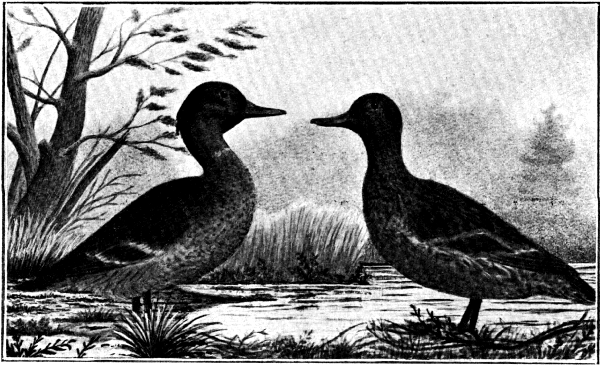 |
| GREEN-WINGED TEAL (Anas carolinensis) |
The green-winged teal is another variety that is very plentiful on the Coast, breeding in great numbers on our mountain lakes and along the streams from Mexico to Alaska, and even to considerable extent on the lower marshes, especially from central California north. While many of these are killed on the salt marshes and tide lands, they are more generally frequenters of the inland ponds and overflows. Nesting late and maturing early, they are both a late and early duck on our shooting grounds, and remain constantly with us during the whole winter. Shooting on a pass over which the teal are flying from one pond to another furnishes about the finest sport of the duck shooter's life. In such cases they come in small flocks, and single birds must be selected; being a small mark and very rapid flyers they require a good lead and quick work. In fact, a brace of green-winged teal with a pressing engagement at the next pond makes about as pretty a target as the sportsman often fires at.
The green-winged teal, like the widgeon, feeds a great deal on the plains and in the fields.
Color—Male—Top of head and neck, brown of a chestnut tinge, the feathers forming almost a crest; a broad stripe of green runs back from the eye to the neck; back and sides, mottled gray; breast, buff, shaded to white on the abdomen and spotted with black; speculum, green.
Female—The top of the head of the female is a rusty brown, and with a very faint stripe on the sides; upper parts, gray, spotted with black; speculum, green.
Nest and Eggs—The nest of the green-winged teal is generally a little more carefully made than most of the ground nesting ducks. The eggs average about ten and are of a light brownish buff.
Measurements—The green-winged teal is the smallest of the fresh-water ducks. Total length, about 14 inches; wing, 7 1/4; bill, 1 1/4 inches.
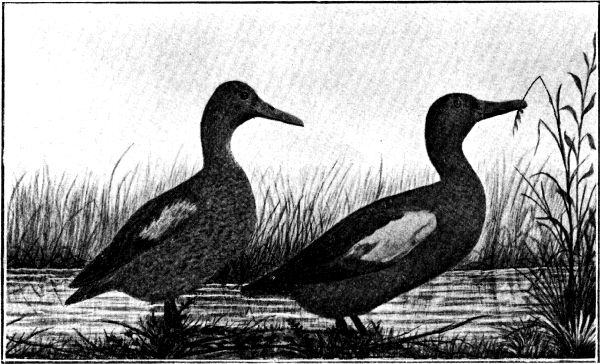 |
| CINNAMON TEAL (Anas cyanoptera) |
The cinnamon teal, very commonly called the blue-winged teal by the sportsmen of the Coast, is only a late fall and early spring bird on our shooting grounds north of Lower California and Mexico. While the cinnamon teal has a blue wing there is no resemblance between the male cinnamon and the male blue-winged. The females of the two species, however, have a marked resemblance in color but a wide difference in shape of body. The female cinnamon teal is much darker on the throat than the blue-winged female, and generally shows a considerable of the cinnamon color of the male. The male of the blue-winged teal partakes more of the grayish color of the green-winged variety and has a white crescent in front of the eye. The northern limit of the cinnamon teal is about the latitude of San Francisco so far as their appearance on our shooting grounds is concerned. A few, however, go farther north for breeding purposes. They are quite common in the southern part of California, where they come to breed. They winter in Mexico, Lower California and Arizona in great numbers. They nest on the mountain lakes and along the mountain streams of California and even as far north as Oregon. In southern California they nest along the salt-water marshes, especially those of Los Angeles, Orange and San Diego counties.
Color—Male—The male bird cannot well be mistaken for that of any other species. The general color being a dark cinnamon, or in fact much nearer a chestnut in color; the head being somewhat darker than the rest of the bird; the upper wing-coverts being blue, form a large patch of blue at the shoulders when the wing is at rest; the speculum, like that of all the teal is green.
Female—The female resembles the female of the blue-winged teal, but is a little larger with a longer and slimmer body; the chin is dusky and the throat is speckled; the breast also has a slight tinge of the cinnamon color of the male.
Nest and Eggs—The nests are built generally in long grass patches of the low grounds bordering the streams and lakes and even the salt marshes. The eggs which average about a dozen are of a peculiar light creamy color with a faint bluish tinge.
Measurements—Total length, 16 inches; wing, 7 1/2; bill, 1 3/4.
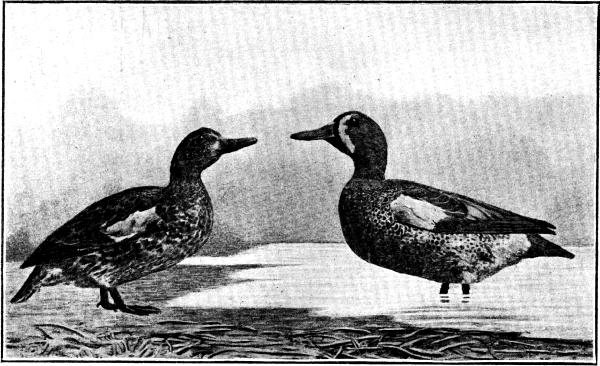 |
| BLUE-WINGED TEAL (Anas discors) |
The blue-winged teal is only a straggler north of Lower California, Arizona and Mexico. In Mexico and Lower California I know them to be quite common, and reasonably plentiful in some parts of Arizona.
The blue-winged teal is a plumper bird than either of the other species, and not near so handsomely marked. It is a rapid flyer and affords good shooting in those sections where it is plentiful.
Color—Male—Head, a glossy purplish gray, darker on top; between the eye and the bill is a white crescent-shaped mark about one-fourth wider in its center than the eye; the wing-coverts are blue like those of the cinnamon teal; back, dark gray; under parts, gray, spotted with black; speculum, rich green; bill, black, and legs and feet, yellow.
Female—The female resembles the female of the cinnamon teal; but unlike the cinnamon it has no dark markings under the chin, or any of the cinnamon color faintly seen on the cinnamon female. The bill also is much shorter, and the legs are of a yellowish tinge.
Nest and Eggs—The nests are much the same as the other members of the teal family. The eggs about a dozen in number are pale buff.
Measurements—Total length, 15 inches; wing, about 7, and bill, 1 1/2 inches.
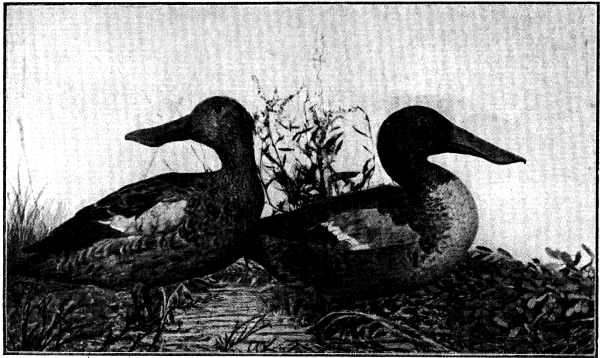 |
| SHOVELLER OR SPOON-BILL (Spatula clypeata) |
The shoveler, or spoonbill, as they are commonly called, is also an early duck upon our ponds; they, too, breed throughout the mountains of our hunting grounds. When they first arrive on our ponds they are very fat and finely flavored, but they soon become poor of flesh and lose the flavor brought with them from their mountain homes. And then they are generally let pass undisturbed by the discriminating sportsman.
Color—Male—Head and neck, green; breast, white, shading into rusty chestnut toward the abdomen; lesser wing-coverts, blue; speculum, green, with white border; legs, orange red.
Female—The female is much smaller than the male and lacks all its high coloring. The general color is buff, mottled with brown; wing-coverts and speculum, same as the male.
Nest and Eggs—The nest, which is a rude affair, generally contains from seven to ten eggs of a light buff color.
Measurements—Total length of the male, about 20 and the female, 18 inches; wing, 9 to 9 1/2; bill, about 2 1/2 to 2 3/4 inches, and very broad at the end.
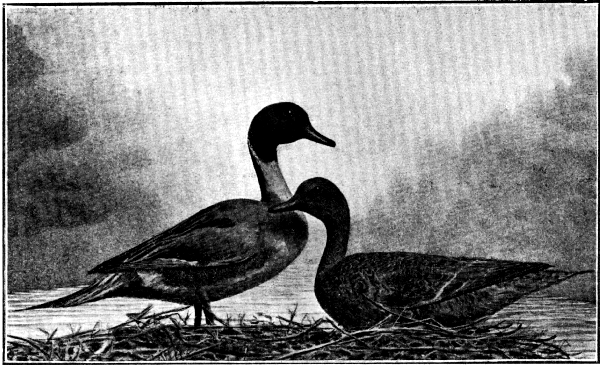 |
| PIN-TAIL OR SPRIG (Dafila acuta) |
The pin-tail, or sprig is another very common duck of the Coast. Great numbers of this species breed on our mountain lakes and, maturing early, they are about the first to appear upon our shooting grounds, great flocks reaching as far south as San Diego county, the mouth of the Colorado river and the lakes and marshes of Lower California, Arizona and northern Mexico as early as the middle of August or the first of September. They come from the mountains plump and fat, and as soon as the shooting season is open prove quite acceptable to the epicure.
The pin-tail ranges throughout the territory covered by this work and far to the north of it, and the fact that they breed around the mountain lakes for the whole distance accounts for their early appearance on the shooting grounds of the Coast.
Color—Male—Head and neck, rich brown, with a white stripe running from the ociput down the sides of the neck to the breast; bill, lead color, with a black stripe along the top; back, gray; breast, white; central tail feathers, very long and pointed; speculum, light smoky brown, edged with white.
Female—The female is much more of an ocher brown than the male, and without the stripe on the neck or the lead color of the bill. The top of the head and the sides of the neck are streaked with brown; breast, spotted with dark brown; under parts, white. While it somewhat resembles the female mallard, the much narrower bill and difference of the speculum should prevent any error in identification. Besides the tail is pointed and the axillars are white, barred with dark brown.
Nest and Eggs—The nest is usually back a little distance from the water's edge and contains from eight to twelve bluish-white eggs.
Measurements—Total length, male, 28 and female, 22 inches; wing, 9 1/2; bill, 2 inches.
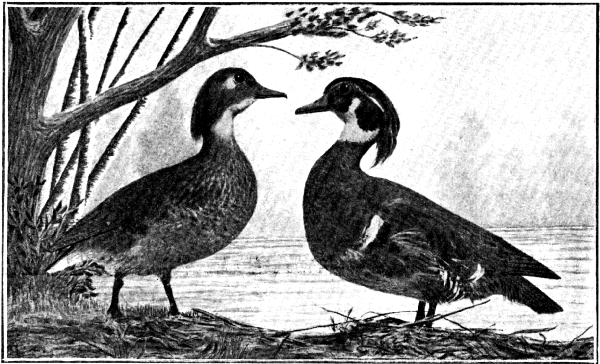 |
| WOOD DUCK (Aix sponsa) |
The wood duck, the handsomest of all the American ducks, is not plentiful anywhere, and seems to be growing fewer in numbers. Ornithologists class them as resident ducks, breeding throughout their range. From my personal experience I believe that they are migratory, at least to a considerable extent, for while many flocks of from half a dozen to twenty birds can be seen along the timbered portions of the Sacramento river during the summer months and the early fall, as well as along other wooded streams of the Coast, few are to be seen during the shooting season. From this fact I can draw but one conclusion; they migrate south in the winter. A few are killed each winter but they can only be considered a rare duck whose beauty lends an occasional charm to the game bag.
Color—Male—The male has a long crest falling down the back of the neck and showing a green and purple luster; the bill is red with a dark stripe on top; a broad stripe of white commences under the bill and passes down the neck, meeting another stripe of white that nearly encompasses the neck; sides and front of lower neck, brownish purple, dotted with white; back, [Pg 72] a bronze green; speculum, bluish purple, bordered with black and white.
Female—The general plan of the markings of the female is the same as that of the male, but the colors are not so bright, nor the crest so long. The crest is more of a brown, and the breast a pale brown, mottled with dark spots.
Nest and Eggs—The nest is built in the hollow of a tree or stump, and occasionally a considerable distance above the ground. The eggs, which average about eight, are of a pale brownish white. The young are taken from the nest in the bill of the mother, and are often seen perched on her back while she is swimming around in search of food.
Measurements—Total length of the male, about 18 inches, with the female about an inch less; wing, 9 1/4 to 9 1/2; bill 1 3/8 inches.
The fulvous tree-duck, commonly called the Mexican tree-duck, and cavalier, as well as the black-bellied tree-duck (Dendrosygna autumnalis), according to the classification of the ornithologist, belong to the subfamily, Anserinæ, the same family as the geese. The fact that they have a bill more like that of the goose than any other duck, a goose neck also, and that there is no difference in the sexes will show the reason for such classification. Their generic name, however, signifies tree-swan. The fulvous tree-duck ranges on our hunting grounds as far north as Sacramento, where occasionally one is killed. They come here only to breed and, therefore, late in the season. Quite a few are killed in southern California, and from Arizona and Lower California south they are very plentiful. The black-bellied tree-duck is only met with as a straggler north of Chihuahua, Mexico. Another species of the same genus (Dendrosygna elegans) is a still more southern bird, seldom seen north of the state of Guerrero.
Color—Sides of head and neck and lower parts, buff; top of head, back of neck and back, dark brown; wings, dark brown; neck, long and slim; bill, resembles that of a goose very much. Both sexes alike.
Nest and Eggs—The nests are generally built in a hollow tree or stump. The eggs number from ten to fifteen and are of an ochreous white.
Measurements—Wing, about 9 1/2; bill, 1 3/4 inches.
Family, ANATIDAE Subfamily, ANATINAE
(Fresh water ducks)
| Genus | Species | Common Names | Range and Breeding Grounds | |||
| Anas | boschas | Mallard | Throughout the scope of this work. Breeds wherever found. | |||
| strepera | Gadwall | From Central California south. Breeds wherever found. | ||||
| americana | Widgeon Baldpate | From British America south. Breeds on the mountain lakes from California south. | ||||
| carolinensis | Green-winged teal | From British America south. Breeds throughout its range. | ||||
| cyanoptera | Cinnamon teal | From Central California south. Breeds from Central California to Central Mexico. | ||||
| discors | Blue-winged teal | From Arizona south into Mexico. Breeds throughout lakes from Mexico north. | ||||
| Spatula | clypeata | Shoveller or Spoon-bill |
From British America south. Breeds on the mountain lakes from Mexico north. | |||
| Dafila | acuta | Pin-tail or Sprig | From British America south. Breeds from Central California north. | |||
| Aix | sponsa | Wood duck | Along the wooded streams from Central California north. Breeds wherever found. | |||
As I have already stated the ducks are divided into two subfamilies, the one the Anatinæ, commonly called fresh-water ducks, the other the Fuligulinæ, commonly known as the salt-water ducks. A distinguishing feature of the salt-water ducks is the little flap or web on the hind toe, which is not seen in the fresh-water varieties.
On our shooting grounds, however, whether the blind is on the salt-water marsh or the fresh-water pond, both kinds are sure to fall to the gun in almost equal numbers. Of the more common of the fresh-water varieties the gadwall and the mallard are seen the least on the salt marshes and the tide overflows, yet even these are quite often met with in these places. So it is with the salt-water species. All except the scoters are frequenters of the mountain lakes, fresh-water ponds and overflows. The red-head, both species of the scaups, the canvasback and the ruddy are commonly found on the fresh-waters. The ring-neck, and, in fact, the red-head are much more common on these waters than on the salt or brackish marshes.
With the exception, therefore, that certain species always predominate at a given place at certain times of the season, the sportsman's aim brings down a well-assorted bag, let him shoot where he may, on marsh, pond or overflow, from Washington to Mexico.
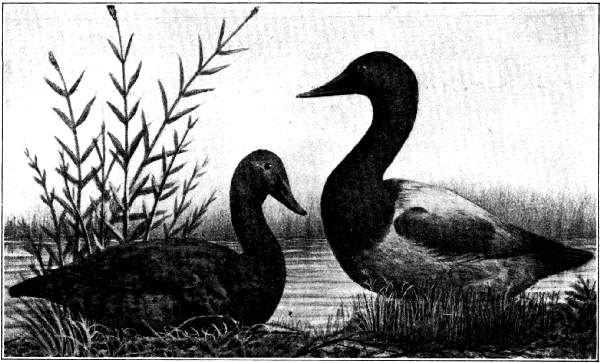 |
| CANVASBACK (Aythya vallisnaria) |
The canvasback, the duck par excellence of the Eastern states, is very plentiful in the more northern portions of the territorial scope of these articles, though I have seen them in good numbers on the lakes of Mexico. It is the general supposition that the canvasback breeds in the far north, but from the fact that they are found on the lakes of Mexico as early as October, they must also breed on the higher lakes of our mountains. On our lower marshes they are a late duck, but they appear on our mountain lakes quite early in the season. Canvasback shooting on our waters affords the finest of sport, as it does not partake so much of flock shooting as it does on the Chesapeake and the Delaware rivers. While I certainly prefer our shooting, by no means do I prefer our ducks. When killed on the mountain lakes, our canvasback possesses nearly if not quite as fine flavor as do those of the Eastern states, but when killed on the bays and salt marshes of California they are fishy and barely palatable. This is caused by the absence of the so-called wild celery, properly tape grass (Vallisneria spiralis), the common food of the Eastern canvasback. Our birds have the habit of feeding largely on the shallow waters of the tide lands and marshes and of consuming large quantities of crustaceans, such as clams, crabs, mussels and the like, and it takes but a few days' diet of this kind to make the canvasback about the poorest of ducks. I have killed these ducks on the high lakes and ponds of Mexico, when, on account of something they fed upon, they were really unfit to eat.
Color—Male—Head and neck, nearly black; back, light gray; bill, black, and forming nearly a straight line from the tip to the crown of the head; belly and flanks, nearly white.
Female—Head and neck, cinnamon brown, paler on the throat; back, dark gray.
Nest and Eggs—The nest of the canvasback is generally found on some little knoll in the marsh, and is lined with dead grass and feathers, and often with considerable down. The eggs, which are about ten in number, are of a dark creamy white.
Measurements—Total length, from 18 to 22 inches; the more northern birds within the territory here covered will always be found considerably larger than those of the more southern latitudes. Wing, 8 to 9 1/2 inches, and bill about 2 1/2 inches.
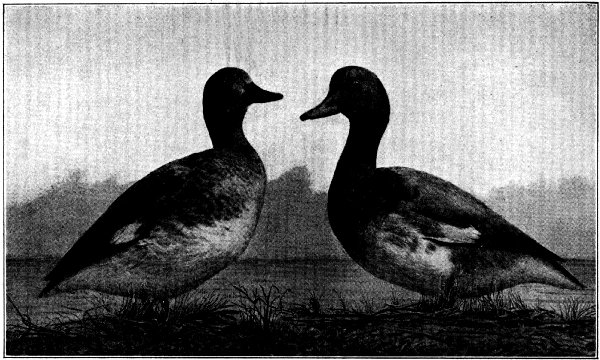 |
| RED-HEAD (Aythya americana) |
The red-head is quite a common duck in the southern sections of the Coast hunting grounds. Though purely a bay or salt-water duck, that is, belonging to the subfamily Fuligulinæ, it is not found to any great extent on the salt-water marshes, preferring the higher lakes, ponds and reservoirs of the mountain valleys and foothills. I found them one season in great numbers on the San Rafael marshes, high up in the mountains of Lower California, and all the shooting two friends and myself wished to do had no effect in driving them away, although the ponds of the marsh were few and small.
Color—Male—Head and neck, reddish chestnut; lower neck and upper breast, sooty brown, a mixture of finely penciled lines of gray and brown; speculum, gray; back, gray; feathers on the top of the head almost form a crest; bill, lead color.
Female—Head and neck, light cinnamon brown, very pale on the sides of the head near the bill, and throat nearly white; breast and shoulders, dirty light brown, and back a darker dirty brown.
Nest and Eggs—The nest, like that of the canvasback, is generally built in the marsh or on the low banks of a lake, usually lined with down and contains about ten eggs of a brownish buff color.
Measurements—Total length, about 20 inches; wing, 8 1/4 to 8 1/2; bill barely 2 1/4 inches.
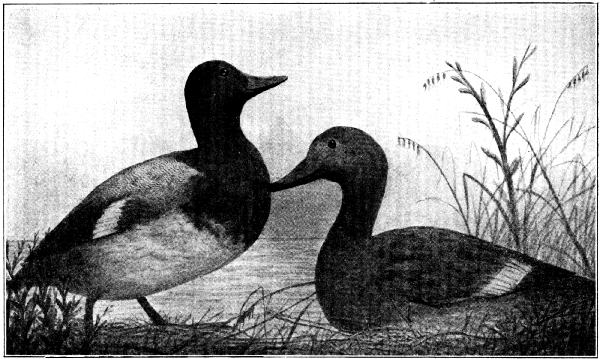 |
| AMERICAN SCAUP DUCK OR BLUE-BILL (Aythya marila neartica) |
The American scaup, or blue-bill, the lesser scaup (Aythya affinis) and the ring-neck (Aythya collaris) are very plentiful from Washington to Mexico. These three species are generally grouped together by the sportsmen of the Coast under the name of black jacks, black ducks, black-heads or blue-bills; all three species being considered as belonging to the one variety, and the lesser scaup (Aythya affinis) as the younger birds. With the males, at least, there should be no excuse for this error, for they can be easily distinguished by the color of the speculum, or bright band on the wings, and by the color of the metallic sheen of the head and neck. The speculum of the American scaup, or larger blue-bill, is white, the head and neck showing a greenish sheen, quite pronounced in the sunlight. The lesser scaup, or little blue-bill (Aythya affinis) has a white speculum also, but the sheen of the head and neck is purple. The ring-neck (Aythya collaris), has a gray speculum, which, though quite light in color, can easily be distinguished from the pure white of the other two. The metallic sheen of the head of the ring-neck is a dark indigo blue. The bill of the ring-neck is quite different from that of the scaups, being much darker in color and more of a sooty tinge and with a faint bluish band across it about half an inch from the end. The females of all three species resemble each other very closely, but the difference in size will generally determine to which species they belong. The two blue-bills can be told from the female ring-neck by their white speculums. The female ring-neck has the gray of the male, but this does not distinguish it from the female red-head. The smaller size of the ring-neck and darker appearance of the head and neck will always indicate to which species the female belongs. The bill of the female red-head meets the skull in quite an abrupt manner, while hat of the ring-neck has more of the sloping character of the canvasback.
Color—Male—Head and neck, black, showing a green luster in the sun; back, gray, finely lined with black; under parts, white; speculum, white.
Female—Head, dead brown, with a light gray patch at the base of the bill blending into the brown of the head; breast and back, dirty brown; under parts, white; speculum, white; bill, bluish.
Nest and Eggs—The nest is a crude affair near the water's edge, containing about ten pale olive-buff eggs.
Measurements—Total length, about 18 inches; wing, 8 1/2, and bill, 1 7/8 inches. The females are but a trifle smaller.
The little blue-bill, or lesser scaup, like its larger relative, is a cosmopolitan species, and commonly met with in flocks of the other, which has led to the common error of classing the two together, the one as the elder and the other as the younger birds.
While in general color and markings they are very similar, there is so much difference in their size that they should be easily distinguished. With the males this is very easy for the head of the larger species has a green sheen, the head of the lesser has a purple sheen as shown in the sun. The bill of this species is more of a blue and much smaller, being not over 1 1/2 inches in length.
Color—The color and markings are the same as the American scaup, with the exception that the metallic sheen of the head, as already mentioned, is purple.
Nest and Eggs—The same as the American scaup.
Measurements—Total length, about 16 1/2 inches; wing, 7 1/2, and bill 1 1/2 inches.
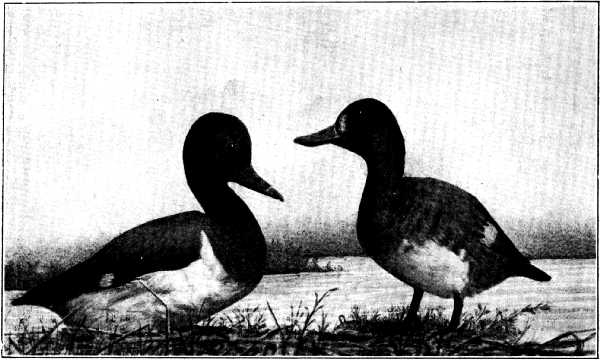 |
| RING-NECK (Aythya collaris) |
In the breeding season the ring-neck male has a dirty orange ring around the neck which disappears wholly, or nearly so, before the beginning of the hunting season. The ring-neck is generally more plentiful on the fresh waters. I have seen great numbers of them at the mouth of the Colorado river. In fact, both the ring-neck and the lesser scaup range much farther south than do the larger species, for while few of the larger scaup are seen in Mexico, great quantities of the little blue-bills are found throughout the republic, especially on the salt marshes of the two coasts. All of these three species breed along the mountain lakes from California north.
[Pg 83] Color—Male—Head and neck, black, with an indigo sheen when turned in the sun. This will always distinguish it from the larger blue-bill whose sheen is green and the lesser blue-bill whose sheen is purple. The speculum is gray; bill, bluish with a pale blue band across it about a half inch from the end.
Female—The female of this species resembles the female of the red-head very closely. It is considerable darker, however, and the bill joins the head without the marked indentation seen in the red-head.
Nest and Eggs—The nest and eggs are the same as the scaups.
Measurements—Total length, 17 1/2 inches; wing, 8, and bill, 2 inches.
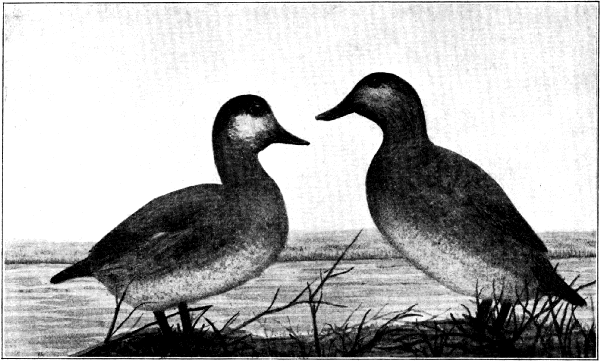 |
| RUDDY DUCK (Erismatura rubida) |
The ruddy duck is a very common duck on our shooting grounds, from one end to the other, though as a rule it is not much sought after by our sportsmen. When feeding on the salt marshes they are not very palatable, it is true, but when killed on fresh waters they are one of our finest flavored ducks, if properly cooked. After refusing many shots at these little ducks and even many times failing to carry home those I did kill, it remained for Mr. Babcock, then of the Coronado Hotel, of San Diego, California, to demonstrate to me the real value of the ruddy duck. I was one of the party shooting with him on his preserve at Otay dam. When we came into the house after our morning's shoot, a most enjoyable one, he asked each member of the party what kind of duck he wished for his dinner. Mallards, canvasbacks, sprigs and widgeons had been named, so when he came to me I answered that any kind would do me. To this he replied: "Then you shall have one of my favorites." When dinner was ready, before each plate was a beautifully roasted duck of the species chosen by the member of the party for whom that plate was laid, but the plates in front of Mr. Babcock and myself each contained two plump little birds that I did not recognize in their undress uniform. After I had tasted of one, Mr. Babcock asked: "How do you like my selection?" "Very much," I answered, "but what are they? I never ate anything better." "The much despised ruddy," was his reply, "the superior of the canvasback when properly handled." The best evidence that I fully endorsed all that he claimed for the ruddy duck is the fact that there was nothing left of my two birds but well-picked bones. The ruddy duck may well be called a resident species over the whole of the Pacific Coast shooting grounds, for they breed not only on the lakes and streams, but on the lower marshes as well, throughout the whole territory.
The ruddy duck is known by a number of names such as "wire tail," "dipper," "bullet-head," "buffle-head," etc.
Color—Male—Top of head, dark brown; sides of head below the eye, dirty white; upper parts, brown; no speculum on the wing; axillars, very light gray with light brown shafts; tail, broad and stiff with the feathers pointed; under parts, dirty white.
Female—Much the color of the male, but more of a dirty brown. Side of the head and throat, dirty gray.
Nest and Eggs—The nests are usually built on little hillocks in the marshes, and contain from six to eight dirty white eggs.
Measurements—The ruddy is a small duck with a very rounded body. Total length, about 15 inches; wing, 6, and bill, 1 1/2 inches, strongly depressed in the center.
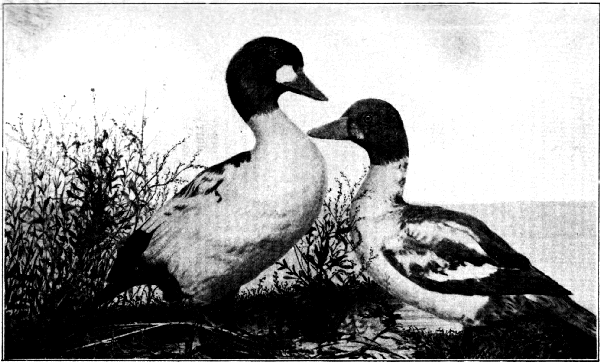 |
| AMERICAN GOLDEN-EYE (Glaucionetta clangula americana) |
The American golden-eye is a visitor from the far north to the northern portions of the territory covered by this work. An occasional straggler is killed as far south as San Francisco, but they are a cold country bird. They are more common in the interior of Washington and Oregon than along the coast.
Color—Male—Head and upper half of neck, dark green with a metallic sheen; a nearly round patch of white between the eye and the base of the bill; lower part of neck, most of the back and the under parts, white; upper part of the back, rump and tail, black; wings, mostly white.
Female—Head and upper neck, brown; gray spot at the base of the bill; breast and under parts, gray; back and most of the wings, brownish black.
Nest and Eggs—The nest is usually built in a hollow tree or stump and contains about ten eggs of a bluish white color.
Measurements—Total length, about 19 inches; wing, 9, and bill, 1 7/8. Female about one-tenth smaller.
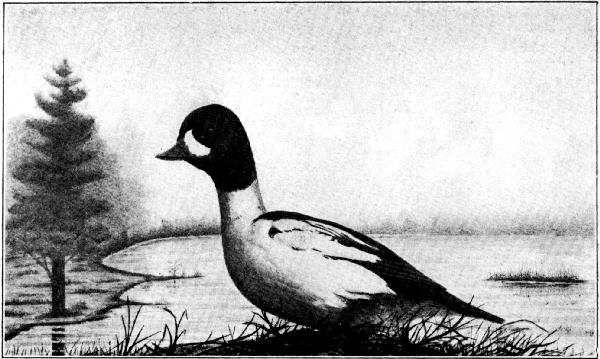 |
| BARROW'S GOLDEN-EYE (Glaucionetta ilandica) |
Barrow's golden-eye is another duck that is seen, but little within the Pacific Coast hunting grounds, and only then near the coast sections of the northern part. They are found more plentiful on the islands along the north Pacific coast.
Color—The male resembles the American golden-eye very closely, except that the head of the Barrow's is more of a purple, or greenish purple. The white at the base of the bill is also different, it being a crescent shape instead of round.
The female differs in the head being more of a cinnamon brown, and the back more of a gray and slightly mottled with brown.
Nest, Eggs and Measurements—The same as the American golden-eye.
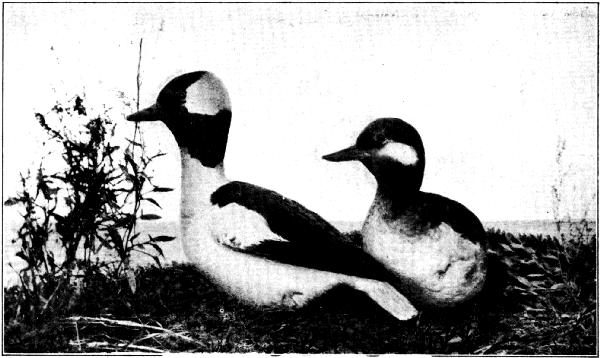 |
| BUTTER-BALL (Charitonetta albeola) |
The butter-ball, or buffle-head, is another common duck all over the country. But where we have so many larger and better ducks they are little sought for, and are generally considered poor shooting. Yet I recall one occasion when with a friend I was shooting on a couple of foothill ponds where many of these little ducks had congregated, they furnished us with fine sport. The larger ducks were soon scared away, but the little butter-balls would not leave. One of us was stationed at each pond and we soon had them all in the air.
Color—Male—Head, greenish purple, with a strong metallic luster; white patch running from the eye to the back of the head; feathers of the head long, forming a crest; back, black; under parts white and a broad white patch on the wing.
Female—The female is a very modestly colored bird to have so gaudy a mate. Head and upper parts, a dark, dead brown; under parts, white; speculum, white; a small, elongated white spot on the side of the head.
Nest and Eggs—The nest is usually built on some elevation such as a stump or log; some times in a tree. The eggs, numbering eight to ten, are of a pale buff color.
Measurements—Total length, 11 to 12 1/2 inches; wing, about 6, and bill, 1 inch.
The old squaw, or long-tailed duck, comes but little into California, though a few are killed each year in Washington and Oregon. I killed one several years ago as far south as Los Angeles county, California, the only one I have ever known to get that far away from his northern home.
Color—Male—As the winter plumage is the only garb that one of this species will be seen in on these hunting grounds, I will only mention it. Head, white, with a patch of brownish black on the side of the head and side of the neck; breast, black, continuing over the back; belly, white; wings, white; a band of yellow across the bill; central tail feathers, black and very long.
Female—Head, white, with a dark patch on the top and on the side; breast and back, smoky black; under parts, white; no long feathers in the tail.
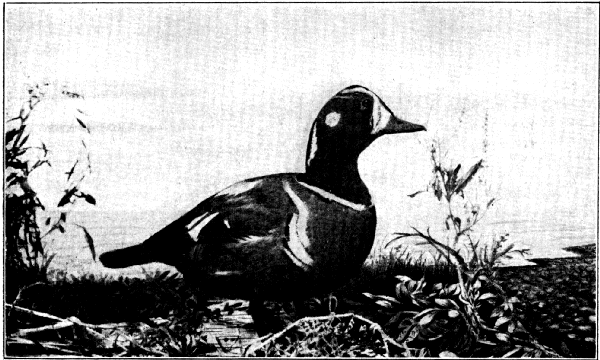 |
| HARLEQUIN DUCK (Histrionicus histrionicus) |
The harlequin duck is a northern bird that comes but little into the United States on either coast. A few stragglers are met with in Oregon and Washington, and an occasional one is killed in California. These and the old squaw add a pleasing variety to our mounted collections, but nothing to our sport.
Color—The accompanying illustration is the best description of this duck that can be given, as the colors are white and a brownish black. It is about the size of the widgeon.
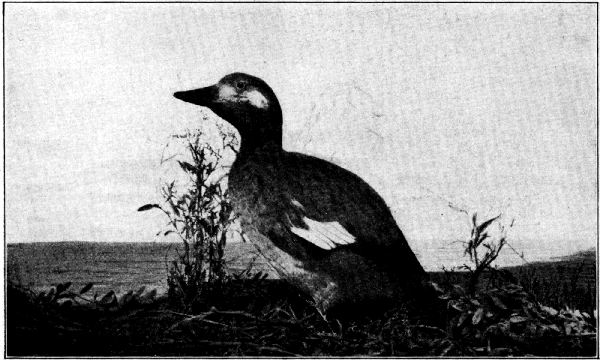 |
| WHITE-WINGED SCOTER (Oidemia deglandi) |
The scoters, or coots, as they are called on the Atlantic coast, are all found on this coast southward to Mexico. Of these the white-winged scoter (Oidemia deglandi) is the most common, being found in large numbers on all the bays and inlets of the coast as far south as the Magdalena bay, Lower California.
Family, ANATIDAE Subfamily, FULIGULINAE.
(Bay and sea ducks)
| Genus | Species | Common Names | Range and Breeding Grounds | |||
| Aythya | vallisneria | Canvasback | From Northern Mexico north. Breeds on the higher lakes from Eastern Oregon to the Arctic. | |||
| americana | Red-head | From Central Mexico north. Breeds on the interior lakes from Eastern Oregon north. | ||||
| neartica | American scaup Blue-bill Black-jack |
From Central California north. Breeds on the interior lakes from Washington north. | ||||
| affinis | Lesser scaup Blue-bill Black-jack |
From northern Mexico north. Breeds on the interior lakes from Washington north to the Arctic. | ||||
| collaris | Ring-neck Black-jack |
From Central California north. More common on fresh waters. Breeds on the interior lakes from Oregon to the Arctic. | ||||
| Glaucionetta | americana | American golden-eye | Rare south of Oregon. Breeds from northern Washington north. | |||
| islandica | Barrows golden-eye | Very rare south of Puget Sound. Found only along the coast. Breed on the Aleutian Islands and Alaska north. | ||||
| Charitonetta | albeola | Buffle-head Butter-ball |
From Central Mexican coast north. Breeds along the coast from Washington north. | |||
| Erismatura | rubida | Ruddy duck Wire-tail |
From Central Mexico north. Breeds on the mountain lakes throughout its range. | |||
| Oidemia | americana | Americas scoter Black coot |
From the Lower California coast north. Breeds on the Aleutian Islands and the Alaska coast. | |||
| deglandi | White-winged scoter White-winged coot |
From the Lower California coast north. Breeds on the Aleutian Islands and the Alaska coast. |
The hunting grounds of the Pacific Coast have a greater variety of geese than any other section of America. Here are to be found every species known to the Eastern states, except the barnacle brant of the Atlantic. But in return for the absence of this species of sea brant we have the black sea brant, the white-cheeked goose, the ross goose, the emperor goose (none of which are found east of the Rocky Mountains) and the hutchins goose, the lesser snow goose, the white-fronted goose and the little brown brant, which are only stragglers east of the Mississippi valley, and only sparingly seen that far east. Thus it will be seen that within the Pacific Coast hunting grounds there are four genera and nine species of the goose family. All of these are found in the northern parts of these hunting grounds, but only about one-half of them visit the southern parts. Increased areas of cultivation, the drainage of vast sections of marshy lands and the absence of laws for their protection have greatly reduced the once wonderful supply.
Acres of geese sounds fabulous, yet miles of geese is the only expression which conveys an adequate idea of the wonderful numbers in which these birds were seen on the Coast half a century ago. The great majority of the geese of the Coast at that time were of the white varieties, and it is a veritable fact that in California, and especially in the Sacramento, San Joaquin and Los Angeles valleys, these geese congregated during the winter months in such numbers as to whiten the plains for miles. Many flocks of honkers were mixed with them, as well as some of the other darker varieties. These darker species of the family, however, were far more plentiful in the northern parts of the State than in the southern. That part of the Sacramento valley known as the Maine Prairies has always been a favorite feeding place for the Canada goose and its subspecies.
[Pg 94]
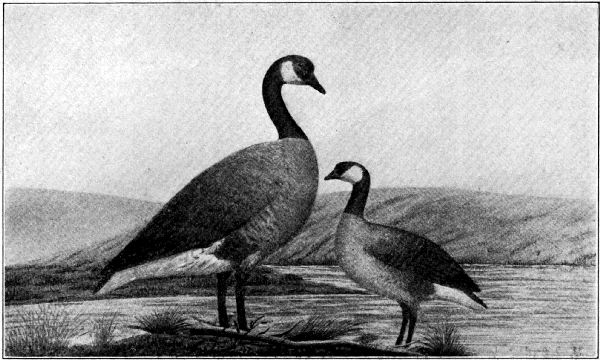 |
||
|
The Canada goose, or honker as it is commonly called, was and is quite common on the Coast. This goose, the largest of the Americans, has a wide distribution, ranging from the Atlantic to the Pacific and from the Arctic to Central America. They breed as far south as southern Oregon, at any rate, and possibly on the higher mountain lakes as far south as Mexico, for they seem to make their appearance on the Coast shooting grounds of Mexico nearly, if not quite, as early as they do here.
The flesh of the Canada goose is the equal if not the superior of the tame goose. Its flight, except when migrating long distances, is generally low, and in such cases it can be called by the hunter to within shooting distance.
Color—Head and neck, black, with a white stripe running from the chin back of the eye to near the top of the head; upper parts, dark brownish gray; breast, dull, light gray, grading into white at the abdomen; tail and wings, black. Both sexes alike.
Eggs and Nest—The nest is generally built of sticks and grass, lined with feathers, and either in the marshes or on the banks of a stream, and rarely if ever contain more than six or seven, and often not more than four, eggs of a very light brownish white.
Measurements—Wing, about 19 inches; bill, about 1 3/4 inches.
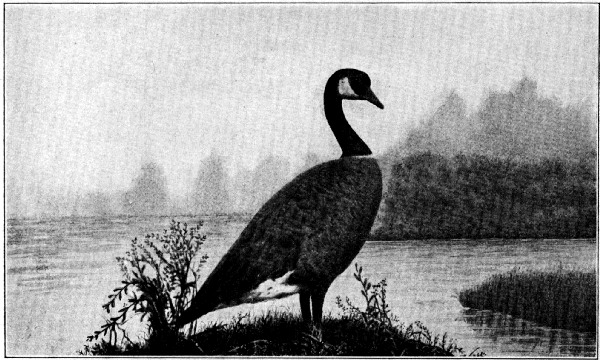 |
| WHITE-CHEEKED GOOSE (Branta canadensis occidentalis) |
The white-cheeked goose, known also as Mexican goose, is found only on the Pacific Coast and never east of the Cascades in Washington and Oregon, or the Sierra Nevadas in California. In fact, they are generally confined to localities not far from the ocean. While both the honker and the Hutchins goose have a white cheek, the white of the honker meets under the chin or blends into a gray, but the white of the white-cheeked variety is separated either with a distinct black stripe under the chin or a mottled black and white one. Also the black of the neck of the white-cheeked goose and the brownish gray of the breast is very generally separated by a white collar, though sometimes this is so faint as to be almost indistinguishable.
The white-cheeked goose is rarely seen south of Monterey Bay, California.
[Pg 97] Color—Same as the Canada goose, except that the white on the cheeks is either separated under the chin by a black stripe or by only a very few white feathers in the black. Between the neck and the dull gray of the breast is a narrow white stripe, or collar. This some times is very faint, and, in fact, some times, though very rarely, absent. This absence of the collar is quite likely caused by its inter-grading with the Hutchins goose.
Nest and Eggs—The same as the Canada goose.
Measurements—Wing, never more than 16 inches; bill, not more than 1 1/4 inches.
We have on the Pacific Coast four varieties of the Branta canadensis, or that species to which belongs the Canada goose, all resembling each other closely except in size. Two of these species are generally considered honkers by most of our sportsmen, while others have two or three local names for them, among which are Mexican goose and Lower California goose. The fact is that while the Canada goose is quite common on the coasts of Mexico, neither the Hutchins goose nor the white-cheeked goose migrate that far south.
The Hutchins goose so closely resembles the Canada goose, or honker as it is popularly called, that it is principally distinguished by its smaller size and a considerable difference in the call. The Hutchins goose ranges as far east as the Mississippi valley, and on the Pacific Coast south only to about Santa Barbara county, California. This is one of the two varieties that is given the local names of Mexican and Lower California goose.
Color—Same as the Canada goose, from which it is only distinguished by its smaller size and a considerable difference in its call.
Nest and Eggs—Same as the Canada goose.
Measurements—Wing, not more than 17 inches; bill, 1 1/2 inches.
The cackling goose, known also as brown brant and gray brant, is the most common of the four varieties and much the smallest. (See illustration.) Its markings are the same as the Canada goose, but its under parts are somewhat darker. While in total length it is fully half that of the honker, in weight it is not more than one-third. The cackling geese are commonly found in flocks of the white geese, both in their feeding and their migrations. This species ranges east as far as the Mississippi valley and south on the Coast as far as the mouth of the Colorado river and to some extent into Lower California. It is more numerous than any other of the dark colored geese of the Pacific Coast.
[Pg 99] Color—The same as the Canada goose, with the exception that it is a little darker on the under parts.
Nest and Eggs—The same as the Canada goose, but the eggs number as high as ten.
Measurements—Wing, 13 to 14 1/2 inches; bill, from one to one and one-eighth.
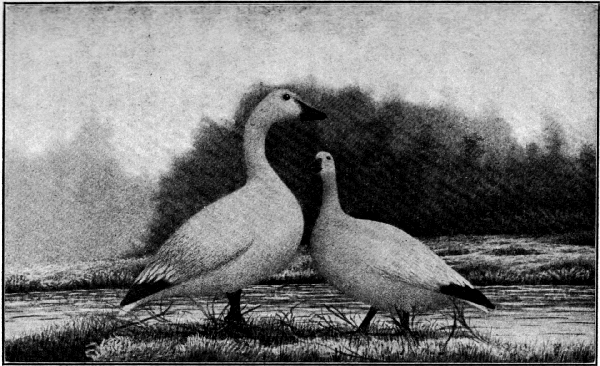 |
||
|
The lesser snow geese, commonly called white geese, are the larger of the two species of white geese so numerous on the Coast. They not only feed, but migrate in great flocks, and these migrations often take place at night when their sharp cries will be heard high in the air. The lesser snow goose is found as far east as the Mississippi valley and south on the Pacific Coast to San Diego. Occasionally a few are seen at Ensenada and the valley of the Palms in Lower California. The meat is tough and poor in flavor and, therefore, they are hunted but little except by the market hunters, who, somehow, succeed in selling a good number of them to the uninitiated.
Color—Pure white, with black bill and legs; the primaries, or long feathers of the wings, are black.
Nest and Eggs—The nests are made close to the water's edge and contain about ten dirty white eggs.
Measurements—Wing, about 16 inches; bill, 2 1/4 inches.
The Ross goose has been given the name of China goose by many who wanted some distinguishing nomenclature for them, when in fact the Ross goose is purely an American Pacific Coast bird. Like the snow goose it is pure white with black primary plumes. Young birds of both species are occasionally seen in the early part of the season more or less mottled on the breast with yellowish gray feathers. The Ross goose is only about half the size of the snow goose. Aside from this it can always be known by the warty appearance of the upper half of the bill. They are commonly seen, both in feeding and in their migrations, mixed in the flocks of the snow geese. Occasionally they are seen as far east as Utah and Montana, but only in small numbers.
[Pg 101] The Ross goose migrates as far south as Central Mexico, great numbers of them congregating on Lake Chapala, in the state of Jalisco.
Color—Same as the snow goose.
Measurements—Wing, about 14 inches; bill, 2 1/4, with warty excresences on the upper part.
[Pg 100]
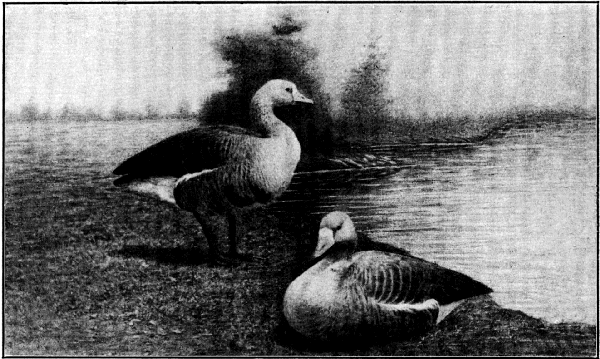 |
| WHITE-FRONTED GOOSE, OR SPECKLE-BREAST (Anser albifrons gambeli) |
The white-fronted goose, or speckle-breast as it is commonly called, is quite common on the Coast south to Mexico, where great numbers congregate on Lake Chapala, Jalisco. This is another western species, though ranging to some extent as far east as the Mississippi valley and an occasional flock wanders even to the Atlantic coast. The breasts of the old birds are commonly profusely speckled with black feathers. The white-fronted goose is a little more exclusive in its habits than any of the others named, being generally found in flocks by themselves. As a table bird the meat is quite palatable, and large numbers are sold in the markets.
Color—Head, grayish brown, with a white spot at the junction of the bill, but this is absent from the young birds; neck, lighter, shading into white or dull white on the breast, mottled with black; back, ashy gray, edged with brown; shafts of the quills, white; bill and legs, light pink.
Nest and Eggs—The nest is usually well made and lined with feathers and down. The eggs number about seven or eight, and are of a pale greenish white.
Measurements—Wing, 16 inches; bill, 2 inches.
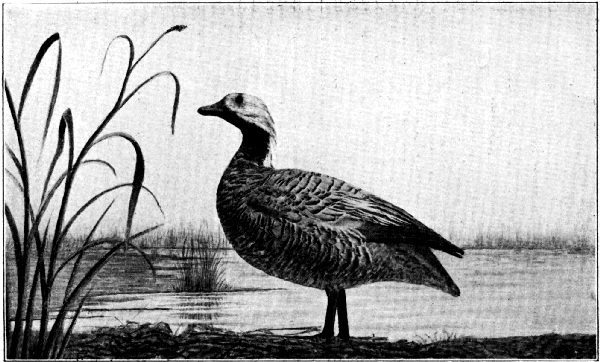 |
| EMPEROR GOOSE (Philacte canagica) |
The Emperor goose is a north Pacific species, breeding principally on the islands of the Alaska coast. The great majority of these birds winter well to the north of us, though a number venture southward into California to Humboldt bay and even south of that. A small flock or two is seen almost every winter on the marshes near San Francisco. A close watch of the markets will reveal one or two offered for sale almost every winter.
[Pg 103] Color—Head and back of neck, white; throat, brownish gray, shading into light gray on the breast and abdomen; back, a little darker; the feathers being gray, tipped with lighter gray, with a sub-terminal band of brownish gray; legs, flesh color.
Nest and Eggs—The nests are usually found on the small islands of the salt marshes, and contain eight to ten eggs of a dull white color.
Measurements—Wing, about 15 1/2 inches; bill, 1 1/2 inches.
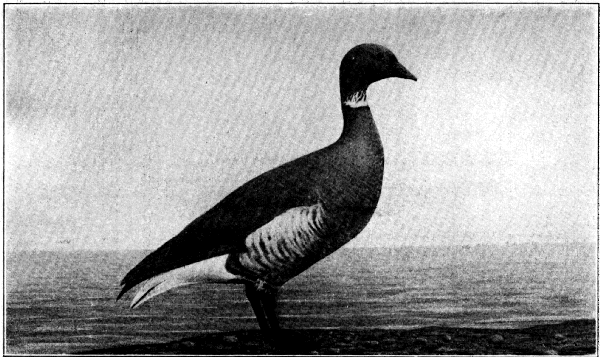 |
| BLACK SEA BRANT (Branta nigricans) |
The black sea brant is another purely Pacific Coast species, found nowhere else except as a straggler. They resemble the barnacle brant of the Atlantic (Branta barnicla) except in the shape of the head and bill. A differing characteristic, however, is that the white speckling on the sides of the neck of the barnacle brant extends all around the front of the neck in the case of the black sea brant. As their name implies, these are purely seabirds, rarely flying over the land even, and only found in such bays as produce the eel grass on which they feed almost exclusively. I only know of the following places within the Pacific Coast shooting grounds where the black sea brant is found. These are: Puget sound, Washington; Coos bay, Oregon; Humboldt, Tomales, Moro and San Diego bays, California, and Magdalena bay, Lower California. In most of these places they ate plentiful during the winter season. Of all birds that fall to the aim of the sportsman, the black sea brant is the most difficult to get within range of. This is only accomplished by great caution and a good deal of strategy, but when they are brought to bag the reward is a full compensation, for of all the waterfowl their flesh is the most delicious. The sea brant is rarely found away from the haunts mentioned, yet the bird from which the accompanying illustration was made was killed from a small flock that had strayed into the lower end of San Francisco bay, near Redwood City, and was mounted by that accomplished sportsman and taxidermist, Chase Littlejohn, of that place.
Color—General color, black; throat, with a white or speckled ring all around the neck, except a small portion of the back; flanks, mottled white and black; under tail feathers, white.
Nest and Eggs—The nest is only a depression on the ground, but nicely lined with down. The eggs, numbering six to eight, are of a dull white.
Measurements—Wing, 13 inches; bill, 1 1/2 inches.
Both the whistling swan (Olor columbianus) and the trumpeter swan (Olor buccinator) were once very plentiful on the Pacific Coast hunting grounds, as far south as central California, and especially so on the Columbia river and the lakes of Oregon and Washington. A few were met with also as far south as San Diego county, California.
I shall never forget the first two swans I ever killed and my experience with them. It was the first winter after I came to California and I was living in Los Angeles, then a little Mexican village, and three of us were doing our own housekeeping. Whatever the reason—most likely from some hallucination of boyhood—I entertained the belief that swans must be exceedingly fine eating. As I prided myself then, just after crossing the plains, upon being a good cook, great preparations were made for an extra fine feast on what I fancied would be a delicious bird. We had a good stove and the first of the two swans was carefully "stuffed" with the choicest dressing, consisting of the combined suggestions of the three of us. It was placed in the oven, the fire carefully tended and the magnificent bird repeatedly "basted." When it was ready and placed on the table it fell to my lot to do the carving. Having drawn my knife across the hunger-producing carcass without making any perceptible impression, I decided that it must be the fault of a dull knife. Among our table furnishings we had no sharpening steel, a scythe stone doing service in its stead. I hunted this up and began on the knife with the "mower's challenge" stroke and soon had an edge that would have cut through anything less than an eighty-pound rail. With no little effort I amputated the legs and the wings, and cutting a generous piece from one side of the breast passed it to one of my companions, who at once began on it with his knife. A few attempts to sever it and he reached for the scythe stone. Then when he began chewing on the segregated piece he declared that it was not cooked enough. A dispute followed as to whether it is over-cooking or under-cooking that makes a bird tough. With this momentous question still unsettled we decided that some of the many ingredients that we had put into the "stuffing" must have given the meat its sole-leather consistency. We had a couple of hounds, whose teeth had been well tested in many a coyote kill, and we passed this first swan up to them.
The next day the other bird was worked into a fine stew and well cooked. When served the stew was fine. The dumplings were light and fairly melted in our mouths; the red peppers were hot; the aroma of onions was just of that degree to suggest the ambrosia of the gods; but the swan! Well, the hounds ate it through the compulsion of hunger.
A half-grown swan, however, is very good eating.
There is very little difference in the two varieties. The whistling swan being more of a northern bird, rarely migrating as far south as central California. About the only noticeable difference is that the whistling swan has a small yellow spot at the V-shaped point of the bill where it meets the eye.
The Pacific Coast is especially rich in waders and shore birds, there being upwards of forty species that are more or less common, with some ten or more that are occasional visitors. Of these few can be considered game birds, while others are so small that they are rarely shot by our sportsmen. Many of both the waders and the shore birds are constant residents. Others come from still farther south for breeding purposes, while still others breed north of us and migrate throughout the territorial scope of these articles to spend their winters.
The shore birds, while very common, are hunted but little by the sportsmen of this region, and many of the smaller species that are considered quite a delicacy by our eastern brethren are passed by entirely by our lovers of the gun. The reasons for this will be obvious to all who have read the preceding pages and noted the abundance and great variety of larger and better game. By better game I mean birds that furnish better sport by requiring more skill in approaching them and better marksmanship in bringing them to bag. The little mountain plover, of the southern part of the Coast, while not surpassed even by the jack snipe as a table delicacy, are hunted but little, even where they are very abundant, because there is little sport to be had in shooting them. And the same is true, in a great measure, of several other species. Sportsmen, therefore, are little acquainted with these birds either as to their names, gastronomic merits or means of identification.
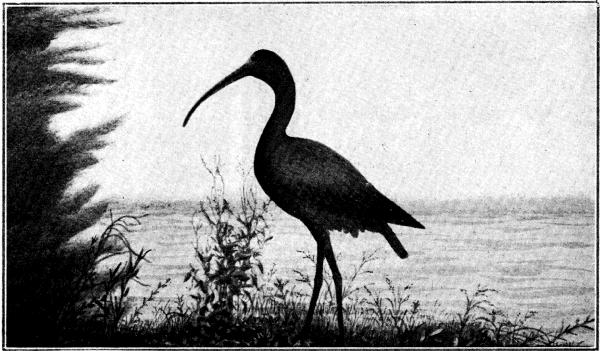 |
| WHITE-FACED GLOSSY IBIS (Plegadis gaurauna) |
While none of the order Herodiones, which includes the storks, herons, ibises and bitterns, can be considered game birds, they are so common about our waters, and some of them add such a charm to the scene by their beautiful plumage and graceful movement, that mention of some of them here will not be out of place.
The great blue heron (Ardea herodias) is the most common of these waders. With his long, gracefully curved neck and slender legs he wades with stately mien along the shallow waters of the lakes, marshes and streams, both summer and winter, for he is to the manner born and has no desire to seek other lands or other climes. The herons are said to be destructive to fish. This can be to a limited extent only, for they subsist very largely on the enemies of the fish, destroying hundreds of snakes, water lizards and other fish destroyers.
The snowy heron, or white crane as it is commonly called (Ardea candidissima), is another handsome wader that lends a charm to the lakes, ponds and streams from Oregon south through Mexico. Built on the same graceful lines as its blue relative, and with a plumage as white as the purest snow, it never fails to attract attention.
Three representatives of the family Ibididæ are found here and present a pleasing and interesting group.
The white-faced glossy ibis (Plegadis guarauna) ranges over the larger portion of the Coast, but from Lower California north only for breeding purposes. Its long curved bill, slim, gracefully bent neck, shapely body, tall legs and irridescent reflections of its plumage in the sunlight, place it among the most attractive of North American birds. Unlike the herons they are gregarious and are, therefore, seen in flocks of varying size. The glossy ibis is often called bronze curlew, but this is a bad misnomer, as they are in no way related to the curlew.
Another of the family is the white ibis (Guara alba). These are quite common in Lower California and Mexico. They rarely migrate into California, though they venture much to the north of us in a northeastern direction, reaching the shores of the Great Salt Lake, during the breeding season. The scarlet ibis (Guara rubra), the other member of the family, is confined to Mexico, so far as these articles are concerned.
The American egret (Ardea egretta) ranges from Oregon [Pg 109] south to South America. It was at one time quite plentiful in California, but its handsome plumes attracted the eye of the milliner, which in turn aroused the cupidity of the market hunter, and these beautiful birds are now rare north of Lower California and Mexico, and are rapidly decreasing even there. The reddish egret (Ardea rufescens) is an inhabitant of Lower California and Mexico, not coming north of these places. Though not as handsome as the white egret, it is also being exterminated for the same purposes.
The birds that I have so far mentioned, while not game birds, are so constantly before the eyes of the sportsmen who engage in waterfowl shooting that they can not help but be interested in them. They add a variety and a beauty to the scene, and many an hour's wait, that otherwise would have been tedious, has passed away pleasantly in watching the graceful movements of some one or more of these stately waders.
To the order, Paludicolae, belong the cranes, rails, gallinules and coots, or mudhens, as they are commonly called. Of the members of this order we are concerned only with the cranes, rails and coots. The sandhill crane (Grus canadensis) is a common visitor to all parts of the Coast, but more plentiful in the interior valleys than near the seashore. They are generally hard to approach and for that reason they are but little hunted by our sportsmen. The whooping crane (Grus americana) once common throughout the middle states, is still met with to considerable extent in Mexico, but it is by no means a common visitor.
The California clapper rail, known also as the San Mateo rail (Rallus obsoletus), is the largest as well as the most important of the rail family in this section. At one time the clapper rail was very plentiful in certain localities in California and furnished abundant sport, though rather of a tame nature, to those who hunted them. Being an easy bird to kill and unsuspicious, they have been rapidly reduced in numbers until now they are in danger of extinction unless laws are enacted giving them better protection. The clapper is only a straggler south of San Francisco bay.
The Virginia rail (Rallus virginianus), a species not more than half the size of the clapper rail, is found sparingly over the Coast, but principally on the fresh water marshes.
The little yellow rail (Porzana noveboracensis) is [Pg 110] found on the fresh waters from central California south, but it is nowhere abundant.
The black rail (Porzana jamaicensis) is another of the smaller rails that are found on the fresh waters to a limited extent. Both this and the last preceding one are so small that they are seldom shot, though as an article of food they are very delicate.
The order Limicolae, which is composed of the shore birds proper, is abundantly represented. They are seen wading in the shallow waters, carefully watching for worms, insects and other species of food upon which they live, boring in the soft mud, scurrying in flocks from place to place, or running along the beach as the surf recedes, picking up the jetsam of the sea, then taking wing or running back like a playful child to the higher ground as the foaming crest of the next breaker rushes up the sandy shingle. Or, as is the case of the phalaropes and some others, they may be seen riding lightly upon the restless billows far out at sea. Modest in coloring and plain in plumage, the shore birds seem to belong to the plebeians of the avafauna, for they are constant workers, always busy, always plying their slender legs rapidly as they hurry from one spot to another, never idle, never resting for a moment.
Of the shore birds there are six families and twenty genera represented on the Coast. Most of them are quite abundant from Washington to Mexico on their respective feeding grounds.
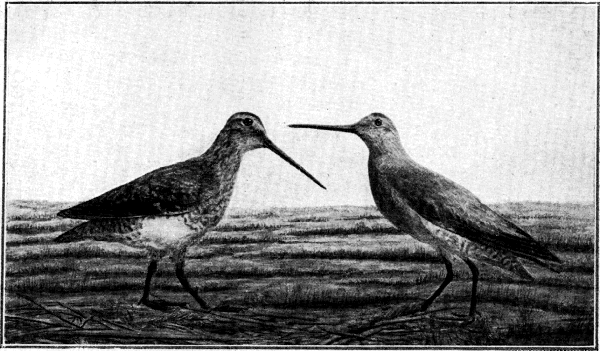 |
||
|
Of all the shore birds the jack snipe, English snipe or Wilson snipe as it is variously called, is the most highly prized as a table delicacy and furnishes the best sport with the dog and gun. Usually lying well for the dog, erratic in its flight and quick on the wing, the Wilson snipe is one of the most difficult birds to bring to bag. It is not only erratic in its flight, but it is erratic in its nature as well. One day it will be found on a given feeding ground in abundance and on the next not one is to be seen, while possibly the day following they are there again in great numbers. To this uncertainty and the corkscrew flight, peculiar to it [Pg 112] alone, is due much of the charm that jack snipe shooting affords. While these birds are commonly called jack snipe or English snipe, their proper name is Wilson snipe, but like the rose, no matter what the name, they are just as gamy and just as delicious. The Wilson snipe migrates here to but little extent, and these migrations are altitudinal rather than latitudinal. They breed commonly in all the mountain valleys and even as low down as on the Sacramento marshes south of the city of the same name. I found a pair breeding a few years ago in the low hills of San Luis Obispo county not half a mile from the ocean beach.
Color—Head, black, with a central stripe of brown; back, a mixture of dark brown, pale brown, yellow and dull white; greater wing-coverts, dark brown, tipped with white; throat, dull white, barred with brown; a dark stripe running from the base of the bill across the eye to the occiput; under parts of the wings, dull white, barred with black; tail feathers, dark brown, tipped with white, and with a sub-terminal bar of black. No web between the toes.
Nest and Eggs—The nest is a very crude affair made on the ground and with but little lining of any kind. It contains from three to four grayish eggs, blotched with brown.
Measurements—Total length, 11 inches; wing, 5 1/2; bill, 3 inches.
Though not of the same genus, the closet relative to the Wilson snipe is the dowitcher or red-breasted snipe. By many who are not accustomed to the Wilson snipe and its many vagaries, the red-breasted snipe is often mistaken for the former. The red-breasted snipe may easily be distinguished by the small web between the outer and middle toes. This species of the dowitcher is a western bird, breeding well to the north and migrating south to Mexico.
Color—Head and back, more of a gray than the Wilson snipe, with the feathers edged with a pale buff; light gray stripe running from the base of the bill over the eye to the occiput; chin, dull white; breast, gray, with a tinge of cinnamon red; tail, banded with dark brown; a small web between the outer and middle toes, extending about one-fourth down the outer toe.
Eggs and Nest—Nest made on the ground and containing from three to four dull white eggs.
Measurements—Total length, 10 1/2 inches; wing, 5 3/4; bill, about 2 1/2 inches, and with a considerable swelling at the end.
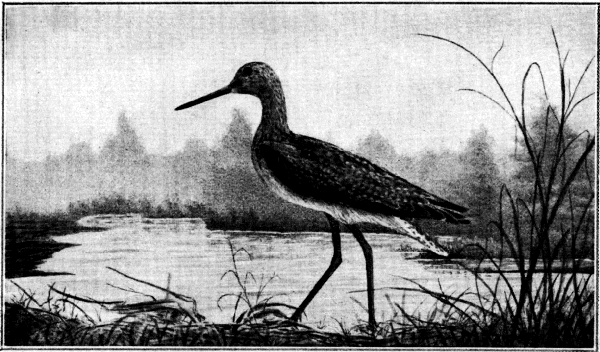 |
| GREATER YELLOW-LEGS (Totanus melanoleucus) |
The greater yellow-legs migrates throughout the entire region, being common on the beaches of Washington, Oregon and California during the fall and early winter as it works its way to Lower California and Mexico. It somewhat resembles the godwit in coloring, but it is more of a grayish tinge. Its shorter bill—not over two and a half inches in length—will always distinguish it from the godwit. So, also, will its sharp whistling note. It is nearly as delicate a table bird as the Wilson snipe.
Color—Top of head and neck, brown, with whitish streaks; back, brown, with the feathers edged with white; chin, white; breast, white, lined with narrow streaks of brown; bill, black, and legs, yellow.
Nest and Eggs—The nests are built close to the water's edge, containing four light buff eggs, spotted with brown.
Measurements—Total length, 14 inches; wing, 7 3/4; bill, 2 1/4, to 2 1/2 inches.
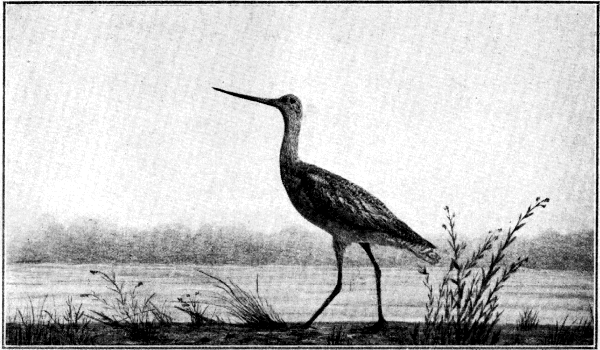 |
| MARLIN OR GODWIT (Limosa fedoa) |
The marbled godwit, or marlin as it is also called, is one of the largest birds of the Scolopacidæ family. It ranges from Alaska to Central America. This species is seen in large numbers in the early fall along the sea beaches of California as they are working their way south. They spend the winter in great quantities in Lower California and Mexico. There should be no difficulty in distinguishing the godwit from any of the other shore birds, its long upward curved bill and brownish-barred back being features by which it may always be known.
Color—Top of head and back of neck, brown, streaked with paler brown; feathers of the back, brown, with ochreous edges; throat and forehead, pale buff, with faint markings of brown; bill slightly turned upward.
Nest and Eggs—Nest a crude affair on the ground, containing four eggs of an ash color, mottled with a dead brown.
Measurements—Total length, 19 inches; wing, 8 3/4; bill, about 4 inches.
The red-backed sandpiper, or American dunlin, is one of the larger members of the genus and quite plentiful on the Coast marshes, but it is seldom seen in the interior valleys except during its migrations. In its winter plumage, in which our sportsmen see it, it is of a dull light gray color. A diagnostic feature of this species is the slightly downward curved bill.
Color—Head and upper parts, light gray, with a white stripe over the eye; shafts of the feathers are dark brown, producing a streaky appearance. In its summer plumage the head and back are reddish brown, wings brownish and abdomen black.
Nest and Eggs—Nests on the ground without lining. Eggs, bluish white, with brown spots.
Measurements—Total length, about 8 1/2 inches; wing, 4 3/4; bill, 1 5/8.
The willet, or stone curlew as it is sometimes called, is a resident species, breeding from Washington to Mexico. It is a western bird, ranging eastward to the Mississippi valley, where it is but a straggler. In size it is nearly as large as the marlin. Its black wings, with broad, white patches, and feet webbed for about half the length of the toes, are distinguishing features, easily recognized. It is generally found on the salt marshes.
Color—The general color of the plumage is ashy white or light gray, usually with some light buff markings on the breast. When flying it shows a broad, white patch on the wings, caused by the upper part of the primaries and part of the secondaries being white. Its smoky black axillars will always distinguish it.
Nest and Eggs—The nest is any place on the ground where it can deposit three or four pale buff eggs, spotted with dark brown.
Measurements—Total length, 15 1/2 inches; wing, 8 1/2; bill, 2 1/2 to 2 3/4 inches.
| Genus | Species | Common Names | Range and Breeding Grounds | |||
| Gallinago | delicata | Wilson snipe Jack snipe |
Throughout the marshes of the coast. Breeds in the mountain valleys. |
|||
| Macrorhamphus | scolopaceus | Dowitcher Red-breasted snipe |
Along the fresh waters of the interior valleys. Breeds in British Columbia and Alaska. |
|||
| Tringa | pacifica | Red-backed sandpiper | From the Central Mexican coast north. Breeds from Washington north. |
|||
| Limosa | fedoa | Marble godwit Marlin |
Early and late migrant along the coast from Mexico north. Breeds in the far north. |
|||
| Totanus | melanoleucus | Yellow-legs | Early and late migrant along the coast, passing the winter in Southern California and Mexico. Breeds in the mountain valleys. |
|||
| Symphemia | semipalmata inornata |
Western Willet | From Mexico north. Breeds throughout its range. |
|||
| Numenius | longirostris | Jack curlew | Early and late migrant. Winters in Southern California and Mexico. Breeds throughout its range. |
|||
| hudsonicus | Long-billed curlew Hudsonian curlew |
Same habits as the long-billed and usually found with it. But breeds farther north. |
||||
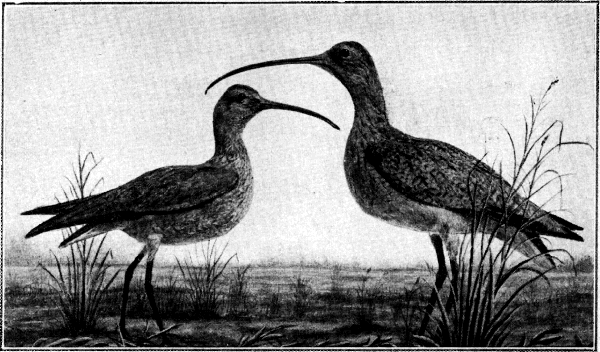 |
||
|
The long-billed curlew, or sickle bill as it is often called, is a plentiful resident in all suitable localities. The young birds mature early and find their way to the marshes during August, when the season for their killing should begin. At this time and even during the month of September they are quite palatable, but later they become strong in flavor. In these months they feed largely upon the seeds and insects to be found on the plains, but later they confine themselves principally to the marshes. They breed near the mountain lakes and streams and even to considerable extent on the lower grounds. A glance at the accompanying illustration will be sufficient to enable the uninitiated to always know a curlew.
Color—Head, back of neck and back, dark brown, mottled with buff; throat and under parts, pale buff, the feathers on the breast being streaked with brown; axillars, reddish brown.
Nest and Eggs—The nest is usually made on the ground in tall grass and back some distance from the marsh. The eggs are about four and of an olive gray, spotted with brown.
Measurements—Total length, without the bill, which varies very much, about 20 inches; wing, 9 to 11; bill, from four to eight inches, and bent downwards, with nearly as much curve as a sickle; in most specimens the bill will be about six inches in length.
The Hudsonian curlew, or jack curlew, by which name it is also known, is also a common visitor to our hunting grounds. It is often seen mixed with flocks of the preceding species, which leads many to suppose that they are the younger birds of that species. Unlike the long-billed, the Hudsonian curlew is not a resident species, or, at least, not to so great an extent, although it makes its appearance on our marshes quite early in the season, even as far south as central California. In markings the two species are almost identical, with the exception that the Hudsonian is somewhat paler in shade. Any doubt arising as to which species a specimen may belong can easily be settled by an examination of the axillar plumes. If a long-bill, these feathers will be a solid reddish-brown, but if a Hudsonian, they [Pg 121] will be of a pale buff color barred with a dull-brown, the buff and brown being nearly of the same width. Both species become less common north of southern California during the late winter months.
Color—Same as the long-billed curlew, except that it is a little paler on the under parts, and the mottling shows more distinctly on the back. The axillars are pale buff, distinctly barred with light brown.
Nest and Eggs—The same as the long-billed curlew.
Measurements—Total length, including bill, which varies but little in this species, about 17 inches; wing, 9, and bill about 3 1/2 inches.
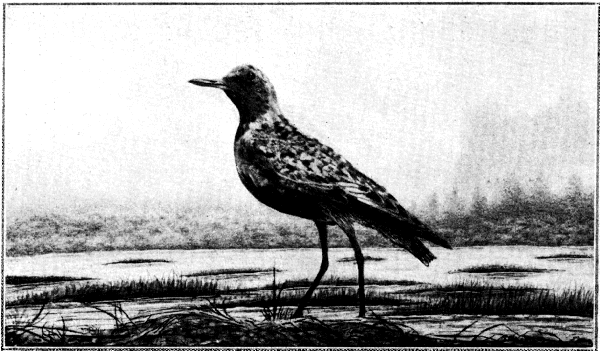 |
| BLACK-BELLIED PLOVER (Charadrius squatarola) |
The largest of the family Charadridæ is the black-bellied plover. In its plumage, both summer and winter, it closely resembles the golden plover, as the black on the sides of the head, front of neck, breast and abdomen disappear from both species in their winter plumage. But, notwithstanding this, they can easily be distinguished by the small rudimentary hind toe of the black-bellied species, the other having but three toes. A few specimens of the golden plover have been taken on the Coast, but it is of rare occurrence. The black-bellied plover is reasonably common along the coast line, but it is not seen to any great extent in the interior valleys.
Color—Upper plumage, dull brown, mottled with gray, the top of the head being somewhat darker; under parts, nearly white and the sides and breast streaked with brown. In the summer the throat and belly are black.
Nest and Eggs—The nest is usually made on the uplands, where four eggs are deposited of a pale olive, spotted with brown.
Measurements—Total length, 11 inches; wing, 7 1/2, and bill, 1 1/4 inches.
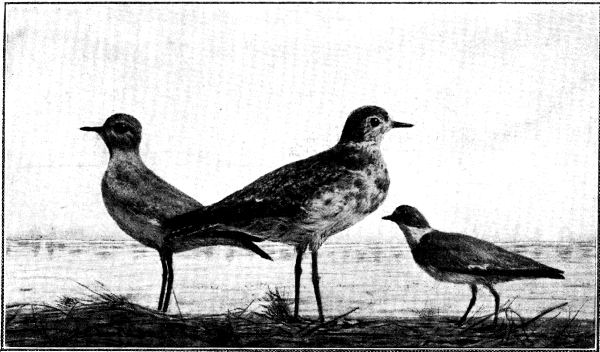 |
|||
|
The mountain plover is very plentiful on the plains of southern California during the winter months. This little bird as a table delicacy is not surpassed by any of the long list of shore birds. In fact it is preferred by many to the far-famed jack snipe. It is an upland [Pg 123] bird, feeding largely on insects, and rarely found near the marshes whether salt or fresh-water. In its winter plumage, as seen here, its underparts are white with the breast and upper parts of a brownish gray.
Color—Throat, breast and under parts, white; the rest of the plumage, light buffish gray; sometimes the breast will show a slight tinge of buff; axillars, white; bill, black. Three toes without web.
Nest and Eggs—The nests are placed on the uplands and contain three grayish eggs, spotted with brown.
Measurements—Total length, 8 3/4 inches; wing, 6, and bill, 9/10 of an inch.
The snowy plover is quite common from northern California to Mexico. It is a small bird and, while it is hunted but little, its flesh is quite delicate. In its winter plumage it is much lighter in color than any of the others named.
Color—Top of head, back of neck and back, buffish gray; forehead and under parts, white; a patch of dull brown just above the white of the forehead, and another of the same color on each side of the throat. Three toes without web.
Nest and Eggs—The nests are found throughout its range; they are nothing more than a depression in the sand and contain four grayish buff eggs, spotted with black.
Measurements—Total length, about 6 3/4 inches; wing, 4 1/4, and bill 5/8 of an inch.
The ring-neck plover is a fairly common visitor during the winter months. It is usually seen on the coast or on other sandy shores. It may be known by its partially webbed feet.
Color—Forehead, chin and neck, white, with a faint streak of dull brown from the bill under the eye to the back of the neck; a band of dull, brownish gray on the breast; back and wings, ashy gray; under parts, white; bill, black with a spot of orange at the base. Three toes which are webbed for about half their length.
Nest and Eggs—Nests are made in the sand and contain from three to four dirty white eggs, spotted with brown.
Measurements—Total length, 6 3/4 inches; wing, 4 3/4, and bill, 3/2 inch.
While the Wilson plover is found to some extent on the southern Atlantic Coast, it may properly be said to be a Pacific species. Here it is seen on the beaches in large numbers, just beyond the reach of the surf, picking the insects and minute shellfish as they are washed on the sand, or flying in flocks just above the breakers.
Color—Forehead and stripe over the eye, white; black stripe in front of crown; top of head and stripe from the eye to the bill, black; black band just below the throat; back, gray; under parts, white; bill black, and legs and feet, light pink.
Nest and Eggs—The nest is a mere depression in the ground, with three to four eggs of a pale olive, spotted with dark brown.
Measurements—Total length, 7 to 8 inches; wing, 4 to 5; bill, about 3/4 of an inch. Three toes with a small
There are a number of other plovers on the hunting grounds of the Pacific Coast, but they are either too small or the flesh too poor to interest the sportsman. Of these the killdeer plover is the most common and the best known. A description of these would be of no interest to the sportsman and therefore add nothing to the purposes of this work.
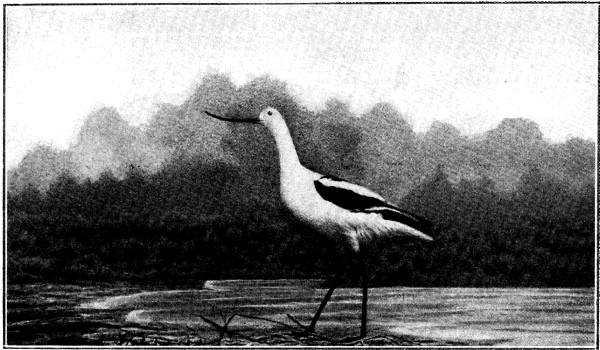 |
| AMERICAN AVOCET (Recurvirostra americana) |
The family Recurvirostridæ has but two representatives on the Coast. The American avocet breeds from Washington southward and spends its winters from central California south. They are quite plentiful in southern California during the winter months, increasing in numbers in Lower California and Mexico. Its webbed feet and long upward turned bill are features by which it may always be known. It is generally found in flocks and frequents both fresh and salt-waters.
Color—Head and neck, ashy gray; back and under parts, white; the primaries and upper half of the secondaries, black, making the wing about half black; [Pg 127] bill, very slender and curved upward; legs, very long and of a lead color; feet, webbed.
Nest and Eggs—The nest contains three to four eggs of a pale olive, spotted with brown.
Measurements—Total length, about 19 inches; wing, 8, and bill, 3 1/2 inches.
The black-necked stilt is the other representative of the family. The stilt breeds as far north as eastern Oregon, but is little seen north of southern California in the winter. From there south it is plentiful. It may be easily known by the back of its head and neck, its back being black and the rest of the plumage nearly pure white. Its legs are a dark pink.
Color—Wings, back, back of neck and top of head, black; balance of the plumage, white; legs, dark pink and very long. Toes, three and partly webbed.
Nest and Eggs—The nest is rarely anything but bare ground on which is deposited three to four eggs of a pale brown, spotted with dark brown.
Measurements—Total length, about 15 1/2 inches; wing, 9, and bill 2 3/4 inches.
| Genus | Species | Common Names | Range and Breeding Grounds | |||
| Charadrius | squatarola | Black-bellied plover | From Mexico north. Breeds from Oregon north to Alaska. | |||
| dominicus | Golden plover | Only an occasional migrant. | ||||
| Aegialitis | semipalmata | Ring-necked plover | From Alaska south to Lower California. Breeds in its northern range. | |||
| nivosa | Snowy plover | From Central California south to Lower California and Mexico. Breeds throughout its range. | ||||
| montana | Mountain plover | Interior plains of California and Arizona. Breeds in the mountain valleys. | ||||
| wilsonia | Wilson's plover | From Oregon south to Mexico. Breeds throughout its range. | ||||
| Genus | Species | Common Names | Range and Breeding Grounds | |||
| Recurvirostra | americana | Avocet | From Mexico north to California. Breeds from Eastern Oregon south. | |||
| Himantopus | mexicanus | Black-necked stilt | From Mexico to Southern California. Breeds near the mountain lakes. | |||
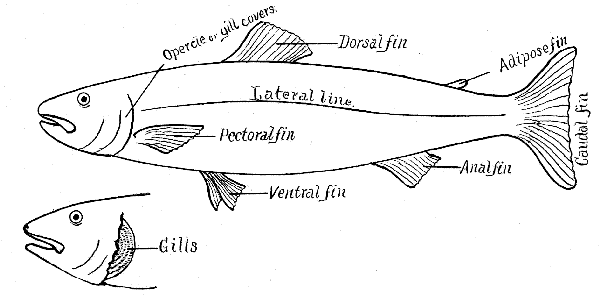 |
Like in that portion of this work devoted to the game birds, this also is written in popular language, avoiding, as far as possible, all technical words and phrases, with the intention of furnishing a plain description of the game fishes of the Coast which anyone, unlearned in the science of ichthyology, may understand, and by which be able to identify any of the fishes he may capture.
With fishes, like with birds, there are certain parts that must be referred to in order to show wherein one species differs from another. Wherever these parts have a common English name, that name has been used. But as there are a few parts that can only be referred to by their scientific names, a diagram has been added showing the location of all parts referred to in the text.
In scope it treats only of such varieties as rise to the fly or are caught by trolling with rod and reel, whether from the stream, lake, bay or ocean, and furnish sport to the angler who fishes for the exhilarating pleasure their capture affords.
The Pacific Coast is rich in game fishes, not only in the varieties found in its lakes and streams, but as well in its bays and estuaries, while the broad ocean furnishes varieties whose size and fighting qualities are not surpassed, even if equaled, in any other part of the world. To place in the hands of the young angler, and others who may not have given the subject the necessary attention, a convenient handbook by the aid of which even the novice may readily recognize the species of fish he has landed, is the object of these pages.
All of the salmon, the trout, the chars, the white-fish and the lake herring have been classed by the naturalist in one family and given the name, Salmonidæ; but it is only with three genera of the subfamily, Salmoninæ that we are concerned. These are the Pacific salmon (Oncorhynchus), the true trout (Salmo) and the Eastern trout and the dolly varden trout (Salvelinus). The Atlantic salmon belong to the genus Salmo, the same as the true trout, and have but one species (Salmo salar), which partake more of the habits of the trout than do their Pacific cousins.
Notwithstanding the fact that the salmon is one of the most valuable of all the food fishes, but little is known of its habits after it leaves the stream in which it is hatched until it returns to spawn, supposed to be from three to four years afterward. Whether they remain near the mouths of the streams, or whether they migrate to distant feeding grounds are questions that have never been solved. All of the five species are caught with seins in Puget Sound in greater or less numbers all the year round. From the action of those that spawn in the Sacramento river it would seem that they migrate southward and far out to sea, for on their return to spawn they enter Monterey Bay only on its southern side, and following around it at no great distance from the shore, leave it at the northern headlands and skirt the shore northward until they reach the entrance to San Francisco Bay on their way up the Sacramento river. Where the young fish make their habitat from the time they drift down the stream in which they were spawned until they return again to spawn has never been determined. They spawn but once and die soon afterward. As I know that this last statement will be disputed by some, for reasons best known to themselves, I will quote from that excellent work by Evermann and Jordan, "American Food and Game Fishes." "We have carefully," say these gentlemen, "examined the spawning habits of both forms of the red fish and chinook salmon in the head waters of Salmon river, Idaho, during two entire seasons, from the time the fish arrived in July until the end of September, by which time all the fish had disappeared. A number of important questions were settled by these investigations. In the first place it was found that all of the fish arrived upon the spawning grounds in perfect physical condition, so far as external appearances indicated; no sores, bruises or other mutilations showing on any of more than 4000 fish examined. During the spawning, however, the majority became more or less injured by rubbing against the gravel of the spawning-beds, or by fighting with one another. Soon after done spawning every one of them died, not only both forms of the red fish but the chinook salmon as well. The dying is not due to the injuries the fish received on the spawning-grounds; many were seen dying or dead which showed no external or other injuries whatever. The dying of the West Coast salmon is in no manner determined by distance from the sea. Observations [Pg 132] made by us and others elsewhere show that the individuals of all species of the Oncorhynchus die after one spawning, whether the spawning-beds are remote from the sea or only a short distance from salt-water."
The angler's concern, however, is not so much with the procreative habits of the salmon as it is with their behavior while feeding and after being hooked.
Salmon are rarely caught by still fishing, but they will take the spoon or a sardine or other small fish impaled upon the hook. They take the bait generally with some hesitation, though at times they strike it with all the impetuosity of the trout. Then the singing reel calls for careful and immediate action on the part of the angler, for the ten to forty pound fish on his light tackle is going to put up a fight worthy of his skill. In his mad rush for liberty the gamy fish gradually rises to the surface, and when at last checked by the skill of the angler, he will often leap out of the water to a height of from four to eight feet, his beautiful sides scintillating in the rays of the sun, forming a picture to gladden the heart of the angler, for if he be a true sportsman he will fish with such tackle only as will give his adversary a fair chance in the fight and require the fullest exercise of his own knowledge and skill to bring his fish to gaff. The salmon is a strong fighter but his rushes do not last long for a fish of its size. For this reason much of the sport of salmon fishing is lost through the use of too heavy tackle. The writer landed one without difficulty weighing 33 1/2 pounds on a nine thread, Cuttyhunk line and a 5 1/2 foot steel rod weighing less than six ounces, and I believe that a fifty pound fish can be landed with the same tackle. Trolling with hand lines for salmon is practiced by some, but such is not angling. Hauling in an impaled fish hand over hand with a small cable is neither sport nor sportsmanlike.
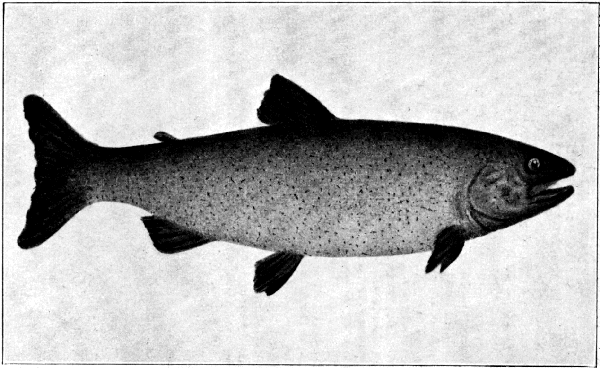 |
| CHINOOK SALMON (Oncorhynchus tschawytscha) |
This species has a multiplicity of names, being known in different localities as chinook, quinnat, king, Sacramento river and Columbia river salmon, besides half a dozen or more Indian names. Its distribution is the widest of any of the Pacific salmon, ranging on both sides of the ocean from the latitude of Monterey Bay to Behring Straits. The run begins on the Columbia river as early as the latter part of February, many of the fish going up its tributaries 1000 miles or more to spawn. Farther south the run becomes gradually later. [Pg 133] The spawning season also varies with the locality, and ranges from the latter part of July to the middle of November. The date of spawning seems to be determined by the temperature of the water, for it is said that the salmon will not spawn, even if on the spawning grounds, until the water has fallen to a temperature of 54 degrees Fahrenheit.
The chinook salmon is the largest of the family, specimens having been taken in Alaska waters that have weighed 100 pounds, while 50 to 60 pound fish are common. Those taken in the Columbia river are said to average 22 pounds, while the average of the Sacramento river catch is 16.
Head, rather pointed; eye, small and situated a little in front of the back of the mouth; body, rounded and full, the deepest part being about midway of its length; pectoral fins, short and situated low and just behind the gills; dorsal fin, nearly midway of the back; ventral fins, a little behind the center of the dorsal; anal fin about half way between the ventral and the tail; adipose fin, a little in front of the rear of the ventrals; caudal fin, or tail, slightly forked.
The back, dorsal fin and tail are generally well covered with dark brownish black spots. There are few spots as a rule on the head, and those are of a slaty color.
There is always some variation in color, but usually the back is quite dark, turning to bluish on the sides and light silver below. As the spawning season approaches, the jaws of the males become lengthened and badly distorted and the color changes to more of a pinkish hue and blotched in appearance. The gills are never alike on both sides, varying from 15 to 19 in number. (See plate giving names of all parts mentioned.)
This species is next in commercial value to the chinook. It has been taken occasionally in the Sacramento river but it is not common south of the Columbia river. The run of this species begins about the first of April and the fish go as far as Salmon river, Idaho, fully 1000 miles from the sea to spawn. By a peculiar instinct this species only run up such rivers as have lakes at their heads, and spawn in the lakes or at the mouths of little streams emptying into them, in many [Pg 134] of the lakes of Oregon and Washington are found the young of the blue-back salmon which are commonly called redfish. These fish never leave these lakes and therefore never attain a size of more than five to seven pounds.
Head, short and pointed and light olive in color; under jaw, white; body, long, slim and rather flattened; back, blue; sides, silver; belly, dull white; dorsal fin, dark; others flesh color; tail, rather narrow and well forked; gills, 13 to 15. As the spawning season approaches the whole fish takes on a decided reddish cast, which sometimes becomes as dark as a brick-red. The jaw becomes very much hooked, and a few spots appear.
In line of importance the silver salmon occupies the next place. It is also known by a number of names, among which are koho, skowitz and kisutch. It is a small fish, rarely exceeding 16 inches in length and never reaching more than ten pounds in weight. Its range is from Alaska south to Monterey Bay, where it has recently been planted and seems to flourish. It spawns in the smaller coast streams, never going far from the salt water. Its run begins about the first of September, spawning in October and November.
Head, short with blunt snout; opercles or gill covers, very convex; body, shaped very much like the chinook; back, bluish green; sides, silver white. It has but few spots and these are confined pretty much to the head, upper fins and tail. Gills, 13 or 14.
This is another small species, rarely exceeding six pounds in weight but more commonly from three to four. Its range is from the Sacramento river, where it appears in limited numbers, north to Alaska.
Body, slim, scales very small; back, blue and sides silvery white. Profusely spotted on the after part of the back, with large oval spots on the tail. Gills, 11 to 13.
The dog salmon rarely exceeds ten pounds in weight [Pg 136] Its range is from the Sacramento river north, and its spawning-grounds the small streams up which it never extends any great distance from the salt water.
Head, quite pike-like in shape and therefore much longer and slimmer than the chinook. Back, dirty brown, with the sides of much the same color, but of a lighter tint; fins, very dark; very few distinct spots, with those showing very small; gills, 13 or 14.
Tackle and Lure—The Pacific salmon are only caught by trolling. They will take a spoon, or any live bait. The most successful lure, however, is a sardine, or other small fish of six to eight inches in length. Pass the hook through both eyes, take a half hitch around the head, insert the point of the hook in the gill and by bending the fish in the shape of the hook bring the point out about an inch and a half or two inches from the tail. This allows the fish to remain curved, and gives it a revolving motion while trolling, resembling a live, though disabled fish.
A salmon rod should consist of a butt 14 to 16 inches in length, with a hand piece in front of the reel; tip, 6 feet long and not to weigh more than 7 ounces; line not to exceed standard 12-thread. With fishes weighing from 40 pounds and upward, 300 feet of line can be used to advantage.
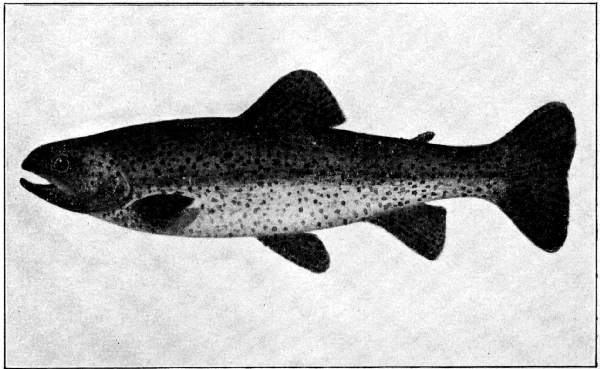 |
| RAINBOW TROUT (Salmo irideus |
There are at least four distinct species of trout; that is, trout proper and chars, now common to the coast. One of these, the Eastern brook trout, is the result of artificial hatching and distribution. These, as well as the rainbow, and to lesser extent the cutthroat, have been so widely distributed by the state fish commission and private hatcheries that to attempt to give the present habitat of the several species would be sure to result in many errors which might be confounding. The Eastern brook trout has taken kindly to our waters and seem to be doing well in all suitable streams. Several other foreign species of trout have been introduced into our waters as well as these, among which are the Loch Leven, the German brown trout and the Mackinaw, but the success of their acclimatization has yet to be fully determined, though the Loch Leven and German brown seem to be doing well in the higher streams.
The Eastern brook trout and the native species, known as dolly varden, are chars and belong to the [Pg 137] genus Salvelinus, but the rainbow and the cutthroat are true trout belonging to the genus Salmo. The rainbow and the cutthroat present a variety of forms in different localities and these have been given separate specific names by the naturalist. With many of these species(?) the only difference seems to be too slight to entitle them to specific or even sub-specific separation; the variation being no more than that found in the color and markings of the same fishes in the same stream, caused by the depth of the water, the food, or other local conditions.
The rainbow trout is now a resident, either through natural or artificial distribution, of nearly all the streams of the Coast from Washington to Lower California. They vary in size, color and number of scales in different localities and have been given distinct specific names in the various sections, those of the Coast streams of California being used as the typical form. These several varieties, even in their natural condition, showed very little, if any positive line of demarkation, but since the establishment of the many hatcheries on the Coast and the wide distribution of the fry hatched from the spawn of the rainbow of the Sacramento and its tributaries, of the steelhead of the Eel river, and of the typical form of the Coast streams, there seems but one course now left, and that is to group them all as one species under the original name of rainbow.
The rainbow is a very handsome trout, varying in size from adults of but a few inches in the smaller Coast streams, to 25 and 30 inches long in the larger rivers and lakes. Its dark spotted back and silvery sides with the rich metallic colors of the rainbow streak gives it a coloration that is at once brilliant and pleasing. As a game fish it has no superior, if indeed an equal. It takes the fly with a rush, often leaping out of the water to seize it as it is descending. Then it fights with a determination, often breaking three or four feet into the air, shaking its head to free the hook like a terrier shakes a rat. It seldom sounds and never sulks. The rainbow trout goes to the sea at varying ages, the same as all other trout that can get there without passing through long stretches of warm and sluggish water. In the salt water it attains a greater size, changes its color in accordance with the length of time it has been there, but on returning again to the stream it soon assumes its original plan of coloring.
Head, about one-fourth of the whole length from the [Pg 138] snout to the base of the caudal fin, varying much with age and size. Generally the greatest depth is about one fourth of the length of the fish, but this also varies very much with the character of the waters it inhabits. In rapid running streams the fish are always slimmer than in more sluggish ones. I have known them 20 inches or more in length, when confined in large reservoirs, to become so heavy that they would weigh one pound to every two inches in length. The lateral line, or rainbow varies, in intensity of color, but always showing in varying shades of red, pink, and sometimes blue of a metallic luster. The vertical black blotches seen on the sides are the marks of immature fish.
The snout of the rainbow is considerably more rounding than that of the salmon, and the head larger in proportion. The eye also is much larger and fuller. The shape and position of the fins are almost identical with those of the salmon, but a little larger in proportion to the size of the fish. The tail, however, varies considerably, being more rounded, and showing only a slight indentation in the center.
If there is any variety of the rainbow trout found on the Coast that is entitled to a sub-specific name it is the golden trout of Mt. Whitney. They were originally found in only a short portion of two little streams fed by the snows of Mt. Whitney, and vary but little from each other. In one stream they have been given the name of Salmo irideus agua bonita, and in the other that of Salmo irideus rooseveltii, after ex-president Roosevelt. They are of a beautiful color with scarlet markings at the base of the fins and with a lateral stripe of bright scarlet blending into a rich orange. One peculiarity of these fish is that the par marks or vertical blotches on the sides of other young fish still show on the adults of these. This form of the rainbow has changed its color through the process of natural selection, caused no doubt, by the color of the rocks in the shallow streams it inhabits. Below on these same streams where the rocks are of a darker color the fish assume the natural color of the rainbow.
The writer is possibly the first white man to ever catch one of the golden trout. They were taken in 1865 with a small piece of the flank of a deer skin slipped over the hook, with the hair clipped to about half an inch in length. No sooner was this improvised [Pg 139] fly cast upon the water than it was eagerly seized by one of these beautiful fish. When it was landed the color astonished me, and knowing that it was a trout, I thought it must be a diseased one and threw it back. Making another cast I secured another one as promptly as the first, and it being the same objectionable color and of the same size—about eight inches—I concluded that it was the same fish and this time threw it on the bank. As fast as my deer skin fly would strike the water it would be eagerly seized by one of these game little fellows and all of the same size and color. I was puzzled and called to my companion, who was cooking our supper but a few yards away, to "come and see what was the matter with these fish." Professing some scientific knowledge, he cut one of them open, examined the meat and the intestines and finally pronounced it in a healthy condition, finishing with:
"The coffee is boiling and the bacon is fried; hurry up, and as soon as you get a mess I'll fry them and take all chances."
I soon had a mess for supper and while he was frying them I caught enough for breakfast, for the game little fellows would race for the fly as fast as it struck the water. We ate them with a relish, for we had had nothing but bacon, venison and frying-pan bread for a month. As we found ourselves alive in the morning we increased the prescription to a good alapathic dose for breakfast.
The golden trout are small, rarely reaching a length of more than fifteen inches. The back is olive, sides and belly light orange or golden yellow with a scarlet stripe along the center of the belly and at the base of the pectoral, ventral and anal fins, which are of themselves more or less of a golden color. Tail, olive, grading into orange on the lower part. Few spots in front of the dorsal fin but abundant behind it.
While the rainbow trout of the Coast have been given several sub-specific names, such as masoni for the Coast streams of Oregon and Washington, shasta and stonei for those of the upper Sacramento basin, and gilberti for those of Kern river, there seems to be so very little reason for this distinction beyond the usual variations of color in all trout, spots and size with the changing conditions of water and feed, that I shall make no mention of the very slight variations upon which the ichthyologist has based the claim to a sub-specific nomenclature.
The history of the so-called steelhead trout and the efforts to class these sea-run fishes as a species separate from the rainbow and the cutthroat, is interesting, if not amusing. No one questioned that they were other than the sea-run of the rainbow or the cutthroat, according to the locality, until Dr. Richardson, mistaking a young blue-back salmon for a so-called steelhead gave it the scientific name of Salmo gairdneri, and the description of this young salmon was recognized as that of the steelhead for years, and under this name it appears in the statutes of California, with a separate season for its protection. In other words the Salmo gairdneri of the laws of California is a young blue-back salmon and not a sea-run trout of any kind. Recently Dr. Ayers to correct the mistake, examined a fish taken from the Sacramento river and said to be a steelhead, gave it the name of Salmo rivularis, and this now stands as the scientific name of the so-called steelhead. Dr. Jordan, in an article recently published in the Pacific Monthly, says: "There has been much discussion as to whether the steelhead is a species really distinct from the rainbow trout, and on this subject the writer (Jordan) has at different times held different opinions."
If one authority bases his reasons for a belief in a specific difference between the rainbow and the steelhead on the fact that he did find a difference between a blue-back salmon and a rainbow, and another authority finds so little difference that he holds different opinions at different times, can there be any wonder that the practical angler, who catches these sea-run fish at the mouths of our rivers in every stage of transition, or gradation, if you please, from the typical rainbow to the Simon pure steelhead, refuses to believe that there is a specific difference?
Then again, Messrs. Jordan and Evermann in bulletin 47 of the United States National Museum, "The Fishes of North and Middle America," say: "In the lower course of the Columbia they (the steelhead) are entirely distinct from the cutthroat or clarki series, and no one would question the validity of the two species. In the lower Snake river and other waters east of the Cascade range, the two forms or species are indistinguishable, being either undifferentiated or else inextricably mixed."
From this it would seem clear that the steelhead of the Columbia, where the cutthroat abounds, are cutthroats [Pg 141] that have gone to the sea, grown larger in the larger body of water—a natural condition of all fishes—and changed in color and appearance. That while they are yet in the lower Columbia and only recently from the salt water, they still maintain a sufficient difference to be easily distinguished from the cutthroat; but by the time that they have reached the "Snake river and other waters east of the Cascade range," their long residence in the fresh water has again restored them to their former appearance. The same changes are found with the rainbow and the steelhead of farther south. All trout are anadromous to greater or less extent, unless actually landlocked or living in streams so distant from the sea that they would be compelled to pass through long stretches of warm and sluggish water to reach it. The small trout of the coast streams are compelled to go to the ocean quite early in the season by the falling of the water to such an extent that in many cases the streams go dry before the beginning of the winter rains, and in the larger body of water they rapidly increase in size. The steelhead of the Columbia river always retains the cutthroat sing-manual, to greater or less extent, while the steelhead of the lower coast has no red on the jaw. The claim that the smaller head of the steelhead is a distinguishing mark, fails in effect, for it is an undisputable fact that the older and larger the trout the smaller becomes the relative size of the head. The other claim that the larger scales of the rainbow is a distinguishing feature from the steelhead is not founded on facts. For while the scales of the rainbow counted along the lateral line vary from as low as 120 in the coast streams, they run as high as 150 in the same streams, as high as 160 in the McCloud and 185 in the Kern. The average being 135 in the smaller coast streams, 150 in the Sacramento basin, and 170 in the Kern. The steelhead's scales run from 130 to 155. An average of 145; or exactly an average of those of the coast streams and the Sacramento. Were it possible for the Kern river trout to enter the ocean no doubt we would find steelhead running as high as 185 to the section.
Whatever may be the origin of the large sea-running trout called steelheads, the fact remains that it is a grand fish both in size and fighting qualities. In the ocean it eagerly takes the spoon and fights with a vigor not even surpassed by the rainbow of the streams. After a short sojourn in the fresh waters it rises to a fly just as readily.
Since the above was written Dr. Jordan has made the [Pg 142] statement publicly, that he is thoroughly convinced that the rainbow trout and the so-called steelhead are one and the same fish; the only difference being that the latter has grown larger and changed its color during its life in the salt water, this variation of color returning again after a short sojourn in the fresh water streams, giving it all the original appearance of the rainbow, or of the cutthroat, as the case may be.
The cutthroat trout very largely take the place of the rainbow in the waters of northern California and in Washington and Oregon, and its various forms are more common to the lakes. Like the rainbow they have been artificially distributed to such an extent that they are now found in many of the streams of California and nearly all of Washington and Oregon. As a general rule they are not as keen fighters as the rainbow, but in the cold streams of Oregon and Washington they put up a fight worthy of the most gamy fish. In the lakes of Washington and Oregon, and such as Tahoe, Donner and other large bodies of water in California, they reach a large size; fishes of ten and twelve pounds being not uncommon. When not landlocked they go to the sea the same as the rainbow and return as the steelhead of the Columbia and other northern streams. Like the rainbow the cutthroat has been divided into several subspecies.
General appearance like that of the rainbow. The color on the back is a lighter olive or dark steel color. The upper parts are generally thickly covered with dark spots, varying in color and shape, and the lower fins are also spotted with smaller spots. The inner edge of the lower jaw is strongly marked with deep red and it is from this red mark on the throat that the species takes its name. The sides are generally of a marked pinkish hue or coppery brown. The red mark of the throat will always prove a distinguishing feature.
In Lake Tahoe there are two varieties of trout that have been given separate specific names. They both belong to the cutthroat series, but vary considerable from the typical form. The one commonly called silver trout is a resident of the deep waters of the lake and [Pg 143] grows to a large size, specimens having been taken fully 30 inches long.
Back, dark green; side and sides of head, coppery; lower jaw, yellow. The spots are so profuse that many of them run into each other and form long blotches in many instances. All of the fins are spotted, those on the dorsal and the tail being oblong in shape. The belly also is covered with many small spots.
The other variety of trout found in Lake Tahoe, and the most common one, is a very handsome fish. Its native habitat is the lakes of Tahoe, Donner, Independence, Webber, Pyramid and others of the high mountains, and the Truckee, Carson and Humboldt rivers. Specimens of this trout have been taken that weighed fully six pounds.
Back, green, varying in depth of color with the water; sides, light, with a strong coppery tinge. The spots on this variety are generally quite large above, but growing smaller below and reaching well onto the belly. Its coppery sides and larger spots should prove a distinguishing feature. Like all the cutthroats it has the red markings below the jaws.
Another peculiar variety of the cutthroat trout is found in Lake Southerland of Eastern Washington. Its distinguishing features are its orange-red fins and intensely black spots which are very profuse. It is a gamy fish and full of fight to the finish.
In several of the lakes of Washington there are varieties of trout differing in coloration and location of their spots that have been given specific names by the naturalist, such as crescent trout, beardslee trout and bathaecetor trout, all residents of Crescent lake. But as they all belong to the cutthroats and vary each from the other but little, further mention is unnecessary.
The Rio Grande trout, which is also a cutthroat, has a very limited distribution within the territorial scope of this work. It is found in the streams of the eastern slope of the Sierra Madre Mountains of Chihuahua, [Pg 144] Mexico. Its head is shorter and more rounded than the other species of the cutthroat, with a mouth also very large. The spots are principally confined to the latter half of the body and most profuse on the tail.
The Colorado river trout, also a cutthroat, is the common trout of Arizona, where it is found in nearly all the mountain streams of the territory which flow to the Colorado river. It differs only from the typical cutthroat by having its spots mostly on that part of the body behind the dorsal fin; and the lower fins strongly marked with red.
The dolly varden is the only char native to the Pacific Coast, and like the Eastern brook trout is not properly a trout. They both are chars and belong to the genus Salvelinus—not to the Salmo. The dolly varden often reaches a length of thirty to thirty-six inches, and a weight of twelve pounds. It is a more slender fish than the rainbow and not so rounded on the back. It is very largely a bottom feeder and, therefore, rather of a sluggish nature. It rises but little to the fly and makes a poor fight.
Back, olive green but without the marble markings of the Eastern brook trout. Spots on the back and sides are red, not very close together and about the size of three-fourths of the diameter of the eye. The lower fins have a reddish tinge, of varying hue in different waters. It is a native of the McCloud river and has been little distributed.
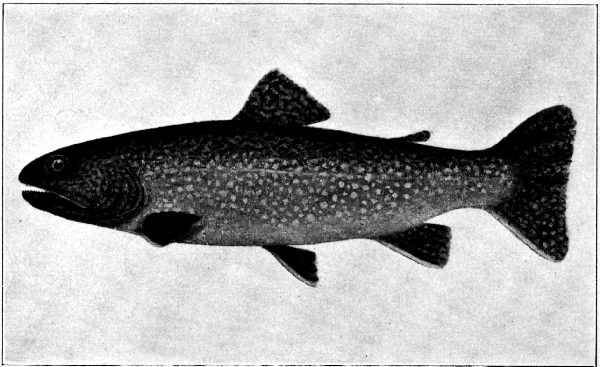 |
| EASTERN BROOK TROUT (Salvalinus fontinalis) |
The Eastern brook trout—properly a char—was introduced into the coast waters several years ago and found our waters so congenial that it must now be considered a resident species, for it is to be met with in many of our streams, and thrives well in any of the higher localities. The brook trout is a handsome fish with its brown and olive marbled back, scarlet spots and salmon-colored sides. Its beauty has challenged the cunning of the painter, and been immortalized by the genius of the poet. Its gamy qualities stood for [Pg 146] centuries as beyond comparison until the bended rod and singing reel announced the impalement of the native of the Golden West, with its mad rushes and terrier-like fights; then the rosy beauty of the East had to yield the palm to the rainbow-colored, fighting pirate of the Pacific.
The brook trout may easily be distinguished from any of the other trout of the coast by its marbled back and red spotted sides. Besides this the whole fish is more of a pinkish color. It varies in size like the others of the family, according to the waters it inhabits, attaining about the same size as the rainbow in the same waters.
Tackle and Lure—On account of over fishing the streams, and the very bad habit of killing so many small fish, the majority of the trout caught on the Pacific Coast are small. If there were more sportsmen and less fishermen on our streams this condition would not exist. For the sportsman will throw back all the little babies that are not over six inches in length and allow them another year to grow. And in this connection I want to say to the young boys and girls: be true sportsmen and sportswomen and never fish for trout with anything but artificial flies. You may not catch as many fish while you are learning, but you will soon find that you are having ten times more sport. As to the rod and line, you will never get it too light. The longer you have been a flycaster, the lighter you will want them; and the lighter they are the more sport you will have.
| Genus | Species | Common Names | Range and Breeding Grounds | |||
| Oncorhynchus | tschawytscha | Quinant Chinook |
From Monterey Bay north. | |||
| nerka | Blue-back Redfish |
Sacramento river north. | ||||
| kisutch | Silver salmon | From Monterey Bay north. Sacramento river north. | ||||
| keta gorbuscha |
Dog salmon Hump-back salmon |
From Sacramento river north. From Sacramento river north. |
||||
| Salmo | irideus | Rainbow trout | From Lower California north. | |||
| irideus auga bonito |
Golden trout | Western slope of Mt. Whitney. | ||||
| irideus roosevelti | Golden trout | Western slope of Mt. Whitney. | ||||
| rivularis | Steel-head trout | From Ventura river north. | ||||
| clarki | Cutthroat trout | Central California north. | ||||
| tahoensis | Silver trout | Lake Tahoe. | ||||
| henshawi | Tahoe trout | Lakes Tahoe, Donner, Independence, Webber; Truckee and Carson rivers. | ||||
| jordani | Lake Southerland | Lake Southerland, Oregon. | ||||
| spilurus | Rio Grande trout | Tributaries of the Rio Grande river. | ||||
| plueriticus | Colorado trout | Tributaries of the Colorado river. | ||||
| Salvelinus | parki | Dolly Varden trout | McCloud river north. | |||
| fontinalis | Eastern brook trout | Acclimatized in many streams of the coast. | ||||
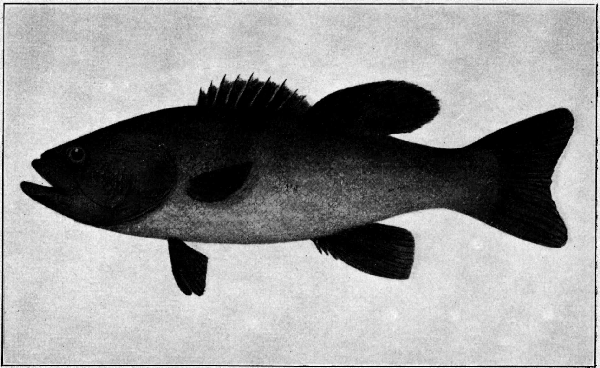 |
| SMALL-MOUTHED BLACK BASS (Micropterus dolomieu) |
The black bass is not a native of the coast, but both species are now so well established in our waters that they must now be classed as permanent residents, for whether it is the crystal lake, the flowing stream, the little pond, the artesian-fed reservoir or the brackish slough, they thrive equally well and take any lure from the artificial fly to the plebeian angleworm.
Black bass are prolific breeders and rapid growers. A case is on record where eight males and seven females were planted in a pond in May and during the November following over 37,000 young fish were taken from the same pond, each from three to four inches long.
The black bass is a short, deep fish with a double dorsal fin; the front half being stiff and spiney and the latter half soft and rayed. The color is variable, but always dark and from a dirty green to a blackish brown on the back, shading to a dirty white on the belly. The gill covers are pointed at the back, with a darker spot on the point. In the small-mouthed variety the end of the upper bone of the mouth does not quite reach to the back edge of the eye, this with the scales on the cheek numbering from 16 to 18, can always be relied upon as a distinguishing diagnosis from the large-mouthed variety.
There is but little difference in the habits of the large and small-mouthed black bass, and but little difference in their appearance, but the distinguishing features may easily be known. The end of the upper bone of the mouth of the large-mouthed variety extends behind the eye, and the rows of scales on the cheek number only 10 or 12.
While both species seem to do well any place, the large-mouthed are better adapted to muddy bottomed ponds and sloughs and brackish waters. The average weight of the adults of either species is about three pounds, though individuals are often taken weighing from six to seven. It is reported that specimens have been taken in the state of California that have weighed eight and three-quarters and nine pounds.
Tackle and Lure—The black bass will take any lure from the artificial fly to the plebeian angleworm. In [Pg 150] trolling, a medium sized, Kewell spoon is to be preferred. I have always found, however, that the best sport is to be had by casting with a large trout fly—the color varying with the season—close to the edge of lily pads or tules. The tackle for fly-fishing should be the same as for trout. For trolling the rod should be shorter and stiffer.
The Sacramento pike, known also by the names chappaul and squawfish, and as lake trout in the San Joaquin Valley, while but little sought after by the angler, can rightfully be classed as a game fish, for it rises to the fly as readily as a trout and often gets cursed for doing so. It is a very common fish in many of the lakes and streams from Washington south to the San Joaquin Valley. Like nearly all fish its size depends very much upon the waters in which it is found. In Washington it has been known to reach a length of four feet, but it is more commonly met with from eight to twenty inches. In shape it resembles a trout, but with a slimmer and more pointed head. The dorsal fin is large and located about midway between the snout and the end of the tail; ventral fins, slightly in front of the dorsal and not as large as the anal which is set about its length from the ventrals; tail, strongly forked.
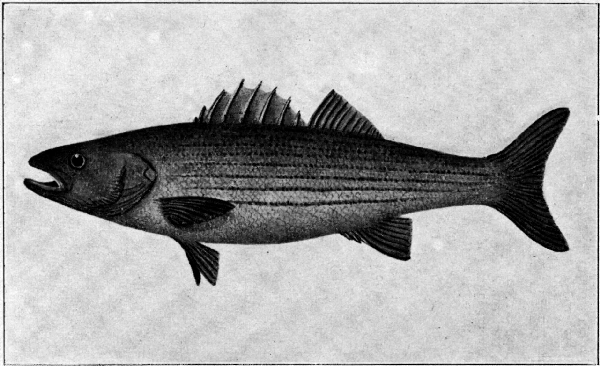 |
| STRIPED BASS (Roccus lineatus) |
The striped bass, like many people who have crossed the continent to California, readily appreciated the many advantages of a life on the Pacific Coast. From a couple of shipments brought from the East in 1879 and 1882 they have grown to be one of the most important food fishes of the state, about 3,000,000 pounds being annually marketed. They were at first liberated in the Bay of San Francisco, but later some effort has been made to distribute them, with the result that they are now found in small quantities along the coast from Los Angeles to Humboldt.
From their fine size—three to forty pounds—they stand well with the angler as a game fish and furnish good sport if the tackle is light enough. Their rushes are not equal to those of the steelhead or the salmon or the yellow-tail, nor do they fight with the same vigor or with the same persistency.
The striped bass is unlike any other coast fish. Its [Pg 152] back is light olive; sides, nearly white with seven or eight longitudinal stripes running the whole length of the body, the dorsal fin is double, but not joined like that of the black bass. The first half is spiny with the after division rayed and soft. It is a salt water fish, making its habitat in and near the mouths of rivers, and often running up them for 100 miles or more. Use the same rod and line as for salmon.
There certainly is no better sport to be had any place with the trout, salmon and bass than that furnished by the rivers, lakes and bays of the Pacific Coast. To this excellent sport must be added another of the most exciting character, and one distinctly Californian, and that is the capture with rod and reel of the large sea fishes found in the waters of the Santa Barbara Channel, and more especially of Catalina Island. The great variety, gamy qualities and massive size of these fishes furnish a sport at once exciting and exhilarating, and challenging the keenest exercise of the ability of the sportsman.
The world-wide fame of these waters, and the grand sport they furnish have resulted in the establishment on Catalina Island of one of the finest, if not the most perfect and best equipped angler's resort in the world, from its launches and boatmen to its clubhouses and hotels, and made it the Mecca of the expert anglers of the civilized nations of the earth.
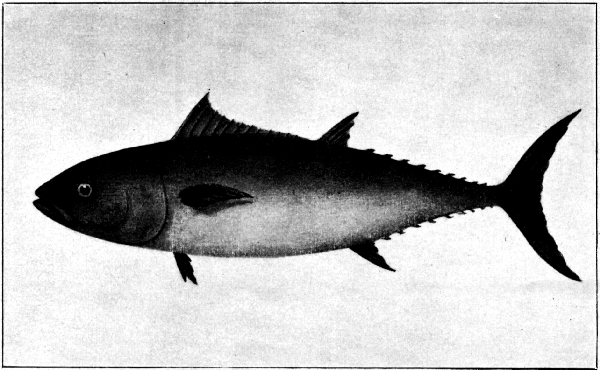 |
| LEAPING TUNA (Thunnus thynnus) |
The leaping tuna is the largest of the great game fishes of the Pacific. It ranges from Monterey Bay, where it is sparingly met with, south to Mexico. About Catalina Island they are found in great numbers and of great size. The excellent sport their capture with rod and reel furnishes, has drawn to the island the expert anglers of the world, and resulted in the formation of the now famous "Tuna Club of Catalina," with its members residing in all parts of the world; and of which no one can become a member until he has landed a tuna of 100 pounds or more with rod and reel and with a line not larger than a 24-thread Cuttyhunk.
Professor Charles F. Holder, an expert angler with a national reputation, and who has angled for all fishes and in all waters, says, "The most sensational fish of these waters is the leaping tuna. It is the tiger of the California seas, a living meteor, which strikes like a [Pg 154] whirlwind, and played with a rod that is not a billiard cue or a club in stiffness, will give the average man the contest of his life."
The record for the largest tuna caught with a rod and reel is held at this writing by Col. C. P. Morehouse of Pasadena, who brought to gaff a 251 pound tuna after a six-and-a-half-hours' fight, during which it had towed his boat over ten miles. But even a greater fight than this is recorded, but the fish was not landed. This fish fought for seventeen hours and thirty minutes before its wonderful endurance and splendid courage mastered the skill of the angler. Mr. C. B. Stockton has to his credit a fight which not only shows the great endurance of this angler but the remarkable vitality of these fish. This fight lasted for sixteen hours and fifty-five minutes before the fish was brought to gaff. It weighed 170 pounds and was taken on the regulation tackle.
Body, round and sloping rapidly from the middle to the caudal fin, and very small and round at the base of the tail; tail divided into two long forks; two dorsal fins, the first beginning just behind the gill-covers with the pectoral and ventral fins a trifle farther back; second dorsal fin smaller than the first and located nearly half way between it and the caudal; anal fin midway between the ventral and the caudal; bony, saw-like projections from the second dorsal fin, and from the anal fin to the tail; color, blue on the back and silvery white on the sides.
Tackle and Lure—The flyingfish is about the only bait with which the tuna can be caught. The hook, which must be attached to about 3 1/2 or 4 inches or light chain and with a wire snell, is passed into the mouth and down the belly of the flyingfish, the barb projecting about midway of the fish. A small string is passed through the nose and under lip and tied through a link of the chain to keep the mouth shut. The speed of the boat should be from two to four miles an hour. In the middle of the day, when the tunas are feeding in schools, the sinker should be removed, and the lure skipped along the surface of the water. This effect can be helped by the motion of the rod.
The Catalina Tuna Club has adopted the following tackle specifications:
For Tuna and Swordfish—Rod to be of wood, consisting of a butt and tip, and to be not shorter than 6 feet, 9 inches over all. Tip not less than 5 feet in length, and to weigh not more than 16 ounces. Line not to exceed standard 24-thread.
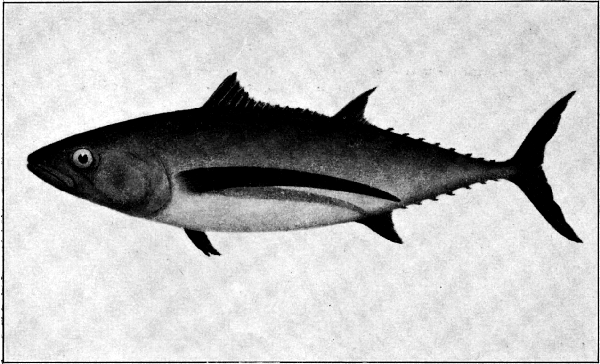 |
| ALBACORE (Germo alalunga) |
The albacore is another genus of the same family, and reaches a weight of 40 to 80 pounds; averaging 25 pounds. It is seldom seen as far north as San Francisco, but is abundant from Santa Barbara south to Central America. Like all of the family it is a gamy fish, and affords good sport to the angler. In general shape and appearance it resembles the tuna, but will always be distinguished by its long, sword-like pectoral fins that start from near the gills, and a trifle lower than the eye, and reach beyond the second dorsal fin.
Tackle and Lure—The albacore will take almost any lure from a sardine to a white rag. The speed of the boat can also be varied very much. I have known them to be caught on a hand line trolled behind a coast steamer. About three miles an hour, however, will give the best results. The following light tackle specifications of the Tuna Club will be found quite satisfactory for the average albacore:
Rod to be of wood, consisting of a butt and tip, and to be not shorter than 6 feet, over all. Butt to be not over 14 inches in length. Tip not less than 5 feet in length, and to weigh not more than 6 ounces. Line not to exceed standard 9-thread.
Another of the Scrombridæ family, and very closely allied to the albacore, is the yellow-fin albacore. This fish has erroneously been called "yellow-fin tuna." It does not belong to the genus Thunnus any more than does the albacore or the bonito. It is only a visitor to the California waters, and often does not make its appearance for one or two seasons at a time. They are common to the coasts of Japan and the Hawaiian Islands, and are supposed to migrate with the Japanese current. This species fights altogether on the surface, but lacks the sterling gamy qualities of the tuna.
In shape it is built very much on the lines of the albacore, but with its pectoral fins only extending back to about half way between the anal and ventral, the other fins are placed the same as the albacore, and all except the pectoral strongly tinged with bright lemon; pectoral fin is more of a bright brown; eye, large and prominent.
A few have been taken weighing as much as 40 [Pg 158] pounds and one even 65 pounds. The average, however, is about 30 pounds.
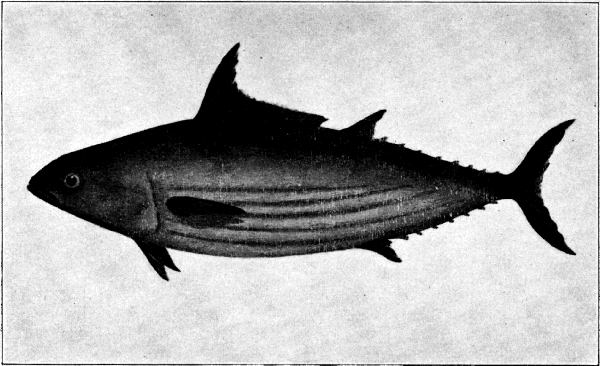 |
| BONITO (Sarda chilensis) |
To the angler who is not looking for the largest of game, the bonito—known as skipjack to the Catalina anglers—is possibly the most interesting of the ocean game fishes. Its beautiful metallic colors, its rapid movements, and pleasing habit of always fighting on the surface, and rarely, if ever sulking, makes it a most attractive game to the discriminating angler.
The bonito also belongs to the Scrombidæ family, and ranges from Point Conception to Mexico and south through the tropics.
Body, rounded, tapering rapidly to the tail, which is strongly forked, but not so much as the albacore; pectoral fins, short and placed opposite the eye; dorsal fin, double, with saw-like ridges from the second dorsal and the anal fins to the tail, the same as in all of this family. Color, dark blue on the back, with a metallic luster; sides, silvery white, with dark longitudinal lines. Weight, from six to twelve pounds.
Tackle and Lure—The light tackle specifications of the Tuna Club, given for albacore cannot be improved upon for these fish.
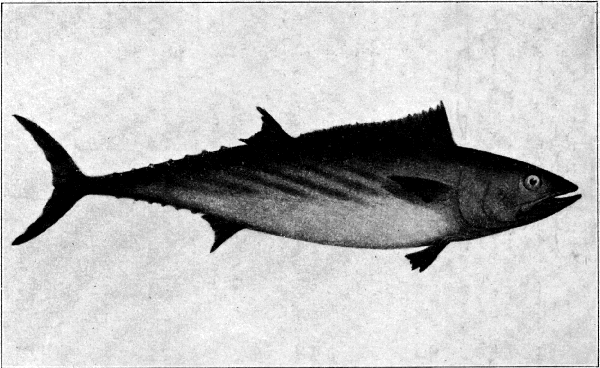 |
| SPANISH MACKEREL (Scomberomorus concolor) |
This is another of the Scrombidæ family. It ranges north to Monterey Bay, where it makes its appearance in September, remaining until November, when it goes south to the Santa Barbara channel; remaining in these waters and about Catalina Island during most of the winter. This fish is called bonito by many of the Catalina anglers, which is a misnomer, as it is a much slimmer fish than the bonito.
The pectoral fins are small and located a little above the center of the body and close to the gill covers; front dorsal starts just above the base of the pectorals and extend along the back for a distance a little more than the length of the head, and nearly meeting the second dorsal, which is about the same width as its heighth; ventral fins, a little in front of the pectorals and rather small; front of the anal fin under the back of the second dorsal. Back, steel blue; sides, silvery. Oblique lines, of the darker color of the back, running [Pg 160] forward and downward to a little below the lateral line.
Weight, usually from nine to twelve pounds, though they occasionally attain a weight of eighteen pounds.
Tackle and Lure—The same as for the bonito.
[Pg 161]
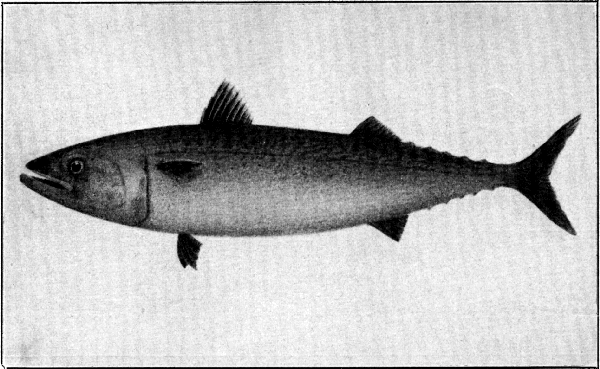 |
| CHUB MACKEREL OR GREEN-BACK (Scomber japonicus) |
The chub mackerel, the smallest of the Scombridæ family, approaches very closely the true mackerel of the East. It is hard to find a fish of any variety more delicious than a chub mackerel, caught from the yacht and placed on the broiler as soon as it quits flapping. They are occasionally found as far north as Monterey bay, but their real range is from the Santa Barbara channel south. With reasonably light trout tackle they put up a gamy and interesting fight.
Back, bluish green, mottled with irregular darker streaks, some of which pass below the lateral line; first dorsal fin quite high, and about the distance of its height in front of the second dorsal; second dorsal and anal about the same size and nearly opposite each other; tail forked, but not so broadly as the bonito. Weight, from one-half to three pounds.
Tackle and Lure—Trout tackle and spoon will furnish interesting sport. But they will take any lure.
[Pg 163]
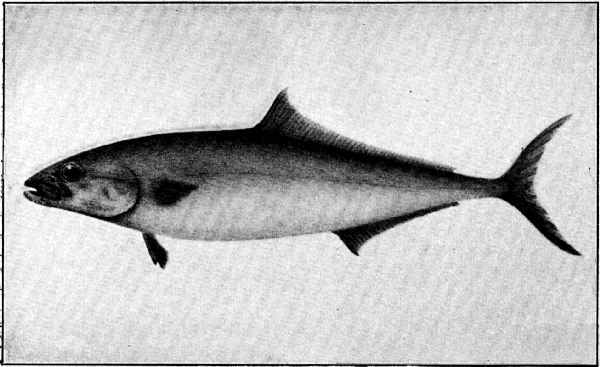 |
| YELLOW-TAIL (Seriola dorsalis) |
The yellow-tail belongs to the family Carangidæ, the same to which belong the pompanos, and is one of the gamiest of sea fishes. In fact, it is generally said by experts who have fished for all varieties and in all waters, both salt and fresh, that the yellow-tail of Catalina is the gamiest fish, pound for pound, that swims. Whether this be true or not, it is certainly one of the hardest and most persistent fighters found anywhere and furnishes the angler with rod and reel from an hour to two hours of lively sport before he can bring it to gaff. One well-known writer on angling subjects says: "It never knows when it is dead." While the average catch will run from ten to thirty pounds, specimens have been taken weighing sixty-five pounds. It is occasionally met with in Monterey bay, but its range is from the Santa Barbara channel south, where it is caught the larger portion of the year.
| Genus | Species | Common Names | Range | |||
| Thunnus | thynnus | Leaping tuna | From Coronado Islands to Monterey Bay. | |||
| Germo | microptera | Yellow-fin albacore | Irregular visitors to the waters of Catalina Island and adjacent mainland. | |||
| alalunga | Albacore | From Point Conception south. | ||||
| Sarda | chilensis | Bonito | From Santa Barbara south. | |||
| Scomberomorus | concolor | Spanish mackerel | From Monterey Bay south. | |||
| Scomber | japonicus | Chub mackerel | From Point Conception south. | |||
Grayish blue on the back; sides, a dull silver, with a yellowish buff stripe along the lateral line; fins, green, [Pg 164] with a strong yellowish tinge; tail, yellowish buff. Scales small, with the head bare, except a small patch on the cheeks. Pectoral fin on a level with the eye and small; ventral under the center of the pectoral; caudal, slim and forked. The dorsal fin is double, the front being very small with spines and the second half more than twice as high; dorsal and anal fins continue in a low membrane to very near the tail. Body, elliptical and very small at the base of the caudal fin.
Tackle and Lure—Same as for salmon or albacore.
[Pg 165]
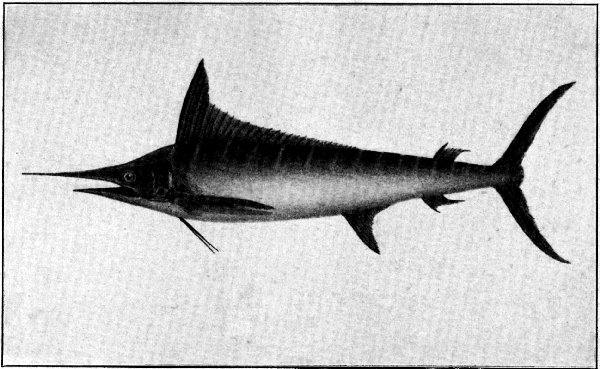 |
| CALIFORNIA SWORDFISH (Tetrapturus mitsukuri) |
By many anglers for large and exciting game, the California swordfish is pronounced the king of all game fishes. Certainly they put up a very determined and exciting fight. In size they average about 180 pounds, though one has been taken at Catalina by W. C. Boschen that weighed 355 pounds. When a swordfish is hooked its rushes are desperate, even reckless, and at times dangerous to the angler. In its determined efforts to free itself from the impaling hook, it threshes the waters into foam, repeatedly leaping into the air, where the sunlight scintillating upon the purple of its back and silvery sides adds the charm of color to the excitement of the contest. It is safe to say that there is no fish, either in the salt or fresh waters, that is so constantly on the surface and in the air during its struggles for freedom as is the California swordfish. Thirty, forty and even fifty clean leaps into the sunlight by the one fish have been recorded in its desperate struggle to baffle the skill of the angler.
The snout of the swordfish is continued into a long, sharp bone, which measured from the back of the mouth is about one-fourth of the length of the fish from the mouth to the base of the tail. The under jaw is also a sharp projecting bone about half the length of the sword. The dorsal fin rises sharply from the top of the head to a height nearly equaling the depth of the body, the latter part curving downward and continuing along the back to nearly the center of the body; tail divided into two long, slim forks; second dorsal and anal near the tail and nearly opposite each other; ventral fin below the terminal of the first dorsal; pectoral fins rather long and located close to the gill-covers; two long, slender feelers projecting from the center of the throat just below the base of the pectorals; eye very large and bright dark blue.
Purplish green on the back, with blue perpendicular stripes fading into the silvery sides; fins, dark purple.
Tackle and Lure—Same as for tuna.
This monster of the ocean, commonly called jew-fish, seems to be in all respects a gigantic black bass, closely resembling the small-mouthed of the fresh waters, and no further description will be necessary for anyone who may be fortunate enough to land one to know to what species it belongs. In fact, he will know just what he has hooked long before the monster shows himself on the top of the water. This huge black sea bass seems to have a very restricted range, for it is only known from the Coronado Islands to the Farallones. They are very plentiful around Catalina Island, where they are usually taken with hand lines. They can not be called a game fish, though they are now being taken with rod and reel at Catalina and furnish a kind of "heavy-weight" sport for those who like it. One weighing over 436 pounds has been taken on a tuna rod and twenty-one thread line. The writer saw one several years ago that was taken on a hand line that weighed 720 pounds and was over seven feet in length. They are fish of great strength and will tow a boat with ease at a considerable speed.
Tackle—The same as for tuna, with fish bait.
The baracuda is a common fish from San Francisco south to Mexico. In the Santa Barbara channel and about Catalina and San Diego it is largely taken by trolling with light tackle, when it affords really good sport. It is a long, slim fish, reaching three and even three and a half feet in length, the usual catch being from two to two and a half feet in length.
Head long and slender; eye high up on the head and nearly half way between the snout and the back of the gill covers. Pectoral fin just below the lateral line; first dorsal spinous and nearly opposite the ventral; second dorsal about midway between the first and the tail; anal almost directly under the second dorsal.
Bluish brown on the back, grading into white on the belly.
Tackle and Lure—Same as for bonito.
There are three other species of fish which inhabit the surf of the Pacific from Point Conception, south to Mexico, that, while they can not be properly termed game fishes, furnish the angler fine sport because of the gamy fight they make on light tackle. These are the whiting (Menticirrhus undulatus), the spot-fin croaker (Roncador stearnsi) and the yellow-fin croaker (Umbrina roncador). The first of these is known locally by the names of courbina and surf-fish, which are bad misnomers. The name, surf-fish, is given by the ichthyologist to a species of perch, and the courbina belongs to the genus Pogonias and is not found as far north as the California coast. These names should be abandoned by the anglers and the proper English name of whiting used. The word courbina is Italian and means croaker, from the Latin, corvus, crow.
[Pg 167]
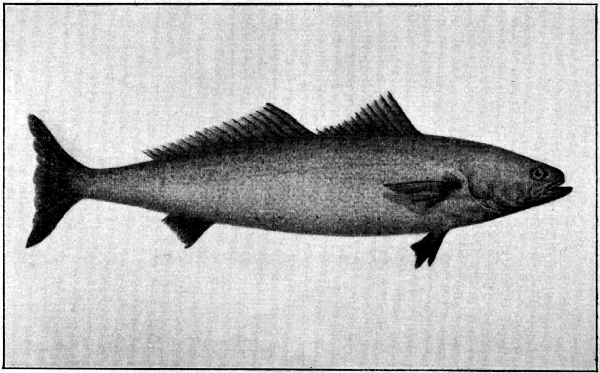 |
| WHITE SEA BASS (Cygonoscion nobilis) |
The white sea bass is purely a California species, ranging from the Coronado Islands to about the latitude of San Francisco. They are caught trolling and make a gamy fight on rod and reel. Twenty to forty pound fish are common and they have been caught weighing seventy-five pounds.
Light bluish on the back and white on the sides, with many small specks; dark spot at the base of the pectoral fins. Head, long, with pointed snout, and with the scales of the head running nearly to its end. Dorsal fin double, the first half having ten spines and the latter twenty-one or twenty-two soft rays. Anal with two spines and nine rays. Tail but little forked.
Tackle—The same as for salmon or yellow-tail.
[Pg 169]
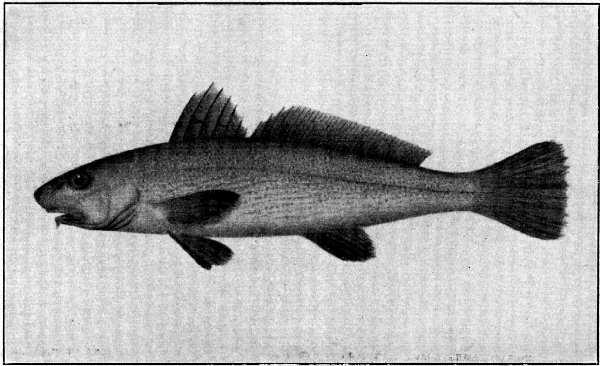 |
| CALIFORNIA WHITING OR SAND SUCKER (Menticirrhus undulatus) |
This species is common to the sand beaches of the Pacific, from Point Conception south to Guaymas, Mexico. It feeds during the larger part of the year in the surf, and is caught from the wharfs or by long casts with heavy sinkers from the beach. The whiting appears on the California coast in two varieties, the undulatus proper and a subspecies which I think has never been classified. At any rate, the difference seems sufficient to entitle it to a subspecies classification, for the [Pg 170] mouth curves strongly downward, and, therefore, does not extend so far back as the undulatus proper. The tail also differs, in having both upper and lower lobes rounded, instead of the upper being square as in the undulatus.
Head, about one-fifth of the entire length; snout, rather pointed, and projecting beyond the mouth; mouth reaching to the center of the eye; small barbel on the lower lip. Dorsal fin, double, the first with from seven to nine spines, the second soft and reaching from the first to within about the length of the head from the tail; pectoral fins near the gills and about the width of the eye below the center of the body; ventral fins, a little behind the pectoral; anal fin under the center of the second dorsal; dorsal fins dark; pectoral, ventral and anal fins, light with darker tips; tail of the undulatus proper, upper lobe square and lower lobe rounded. Back, bluish brown, shading to white on the belly; scales, small. Below the lateral line are a number of small spots forming irregular lines running backward and upward. Size, rarely exceeding eight pounds.
The illustration is of the variety that I have referred to as a subspecies.
Tackle and Lure—The three-six tackle. Rod to be of wood, consisting of a butt and tip, and to be not shorter than six feet over all; weight of entire rod not to exceed six ounces; butt not to be over twelve inches in length. Line not to exceed standard 6-thread. Lure, sandflies, mussels or clams.
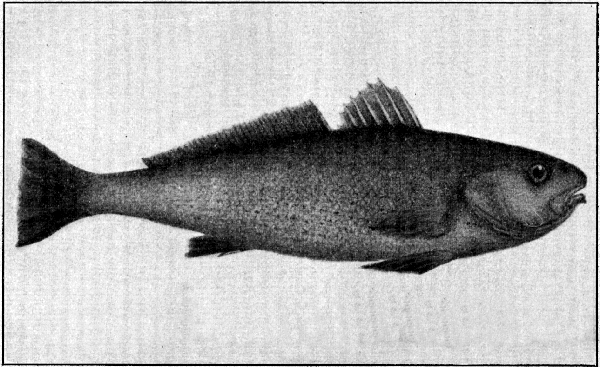 |
| YELLOW-FIN CROAKER (Umbrina roncador) |
The yellow-fin croaker is found in the surf or near it along the sandy beaches from some distance north of Point Conception south to Manzanillo, Mexico, where it is known by the name "corvina con aletas amarillas," or "croaker with yellow fins."
Head, about one-fifth the whole length; snout, very blunt, with a small barbel on the lower lip. Dorsal fin double, the first half with seven or eight spines, the longest about two-thirds the length of the head; second half rayed and about two-thirds the height of the first, and reaching to about half the length of the head from the tail; pectoral fins short, and placed close to the gills and a little below the center of the body; ventral fins just below the pectoral and a trifle longer; anal fin, below the center of the second dorsal; tail, nearly square. Back, greenish brown, with a metallic luster and giving a pinkish tinge in some lights; sides, shading [Pg 172] to white on the belly. A few irregular spots on the sides forming faint lines.
The spot-fin croaker appears in and near the surf of the Pacific Coast from Point Conception south to Mexico. Roncador is Spanish and signifies snorer. This species resembles the yellow-fin very closely, but is usually lighter in color and more metallic in appearance. It can always be distinguished from the yellow-fin by the distinct black spots at the base of the pectoral fins.
Tackle and Lure—Same as for whiting.
I cannot close these articles on fish and fishing without a few words of commendation of the Tuna Club of Catalina Island. From the very inception of this organization it has striven to encourage the use of light tackle by all anglers. To this end, it has adopted three classes of tackle specifications for the taking of the several kinds of fish found in the waters surrounding its island home, and provided a number of cups and buttons to be awarded each year to anglers who land fishes of certain weights, with such tackle as is prescribed therefore by its rules. This campaign, which it has so energetically urged in behalf of scientific angling, has worked wonders in its section of the Coast. The old methods of landing fish, even of the gamiest quality, by the employment of nothing more than brute force at the end of an unbreakable cable, has almost disappeared in its section, and scientific angling with the lightest possible tackle has taken its place. But the good work of the Tuna Club has not been confined to the boundaries of its own section. Anglers from other sections of the country visiting Catalina, and seeing the additional pleasure derived from the use of light tackle, have become enthusiastic advocates of this more scientific means, and returning to their homes have spread the propaganda there.
To the stiff pole and chalk-line fishermen of confirmed habits I have nothing to say. But to the younger generation who have not yet grown grey in the practice of bad habits, I wish to urge upon them the use of the lightest tackle possible, as a means of developing greater skill and deriving greater pleasure from their favorite sport. And this is equally true whether it be a tuna or a trout.
| Genus | Species | Common Names | Range | |||
| Menticirrhus | undulatus | California whiting or sand sucker |
From Point Conception south to Guaymas, Mexico. | |||
| Roncador | stearnsi | Spot-fin croaker | From Point Conception south to Manzanillo, Mexico. | |||
| Umbrina | roncador | Yellow-fin croaker | From Point Conception south to Manzanillo, Mexico. | |||
| Cygonoscion | nobilis | White sea bass | From San Francisco south to Coronado Islands. | |||
It is possible that the day may come when man will be so engrossed with the pursuit of the dollar that the call of the wild will no longer quicken the pulsations of his heart. But until that time does come, the wild creatures of nature, whose pursuit affords the most healthful and exhilarating pastime, will continue to lure him to their haunts.
To slowly trace the forest's shady scene,
Where things that own not man's dominion dwell,
And mortal feet hath ne'er, or rarely, been,"
will long continue to present a charm to all who love the sublimity of the mountains, the beauty of the flower-decked fields, or the awe-inspiring grandeur of the ocean.
To draw a bead on the antlered buck; to stop the flight of the gamy quail; to land the denizen of the mountain stream, or troll the ocean's depth for the tuna, the salmon or the yellow-tail, furnishes a pastime whose recollection draws one back again and again to sit on nature's lap and listen to her teachings. The recollection of these pleasures are locked in the treasure vaults of the memory, where the wearings of time can never erase them; for when the once firm step that carried him proudly up the mountain's side shall falter and become a palsied wreck of time, and the eye, dimmed by the accumulated mists of years, shall see clearly, only in retrospect, he will sit by his fire-side in slippered feet, and, gazing down the long vistas of the past, live over and over again in his reveries the pleasures furnished by the forest, the field, the stream and the ocean.
Nothing would please me better than to describe herein the many places where, during a residence on the Pacific Coast of more than half a century, I have enjoyed these sports in the fullest degree. But even the merest mention of the almost innumerable hunting grounds and trout streams, and the hundreds of mountain and sea-side resorts, from Washington to Mexico, would, of itself, make a volume of no mean size. I am, therefore, restricted to the mention of only a few of the more attractive places where good sea fishing can be found, coupled with such accommodations and surroundings as appeal to the discriminating pleasure seeker.
Almost due south of Los Angeles, and about twenty miles from the mainland, is the far-famed island of Catalina.
It is still a debatable question whether it was the leaping tuna that made Catalina famous, or whether it was its many attractions, its facilities for sea fishing and its splendid accommodations, that gave the sport of tuna fishing a world-wide reputation.
This beautiful island, with its diversified amusements; its grand scenery; its wonderful drives; its surf less sea bathing; its marine views; its perfect equipment for sea fighting, and its splendidly appointed hotel, has made it the Mecca to which the enthusiastic anglers of the world make their regular pilgrimages, for it seems to be the favored habitat of all the game fishes of the ocean, except the salmon and the striped bass.
Catalina is the home of the Tuna Club, the greatest fishing organization of the world, with its international membership pledged to the promotion of scientific angling. It is here where the world's records are made, and the greatest feats in landing the fighting monsters of the sea have been achieved.
In its variety of game fishes I know of no place to equal it. The leaping tuna, the albacore, the Spanish mackerel, the bonito, the chub mackerel, the white sea bass, the yellow-tail, and the California swordfish, the sensational fighter of the ocean, are all here and ready to give the light tackle angler the most exciting contest of his life.
When the angler waits for the tides, he wants some other divertisement to occupy his mind. At Catalina he finds a pastime suitable to every hour, to every fancy, to every mood. He can bathe in its crystal waters; he can stroll along its pebbly beaches or climb its hills in search of wild goats; he can ride through its charming valleys, over its lofty peaks and around the dizzy heights that overlook the ocean; he can increase the elasticity of his step on its tennis courts, or exercise his muscle on its golf links. He can view the ancient relics of a departed people, study the strange and curious forms of ocean life in the extensive aquariums, or comfortably seated in a glass-bottomed boat, marvel at the extravagant splendor of the marine gardens, hundreds of feet below the surface, where sirens sing and mermaids are said to dwell. And, when he has gone the rounds, and longs again for more exciting sport, well—then he can go fishing.
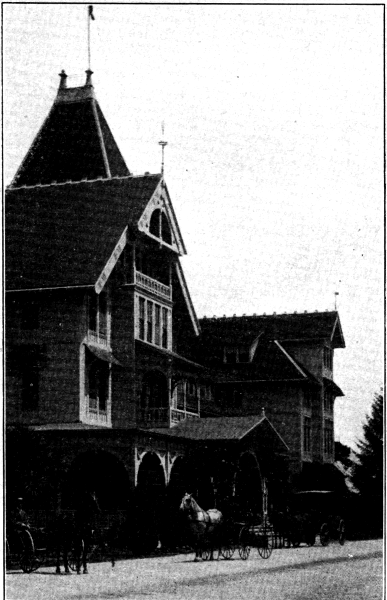 |
| HOTEL DEL MONTE |
Monterey Bay is pre-eminently the fishing ground for the Pacific salmon. As these gamy fish seek their spawning grounds, after their four-years' sojourn in unknown waters, they enter Monterey Bay at its southern headland and follow around it at varying distances from the shore. During this season the Hotel Del Monte, with its splendid appointments and scenic beauty, is the favored Mecca of the salmon anglers. Here boats with experienced boatmen, and a good supply of tackle and bait are always to be had. The contour of the peninsula, with its high mountain crest, forming the southern shore of the bay, is such that the strong winds of the open ocean is cut off from the Del Monte side, allowing the waters of this side of the bay to retain that smoothness that makes either boating or fishing a delight. This, too, may have something to do with the feeding habits of the salmon, thereby accounting for the usually large catches made by the guests of the hotel.
While the Pacific Coast furnishes fine sport for the angler, both in its fresh and salt waters, with an infinite variety of gamy fishes, salmon fishing must be classed as one of the most satisfying. An angler likes to see his adversary and know with what he is contending. The salmon is a surface fighter, leaping high into the air when he finds himself impaled; and this sight of his beautiful sides, scintillating in the sunlight, quickens the pulsations of the heart of the angler and gives zest to the sport.
Each section of the coast has its fish and fishing peculiar to itself; but I care not from what section the expert angler may come, he will enjoy the salmon fishing of Monterey Bay. He will do more; for the Hotel Del Monte is one of the delightful show places of the Pacific Coast. Space will not admit of an enumeration of the many interesting sights here to be seen. There are glimpses of California life a hundred years ago by the side of picturesque golf links and tennis courts. A modern hostelry hid away in the center of a primeval park. A seventeen-mile drive through shady mountain dells and along weirdly beautiful ocean coves and rocky crags. The marine gardens as seen at the bottom of the ocean through glass-bottomed boats. These, and many other interesting relics and inspiring scenes are the side attractions for the salmon angler who visits Del Monte.
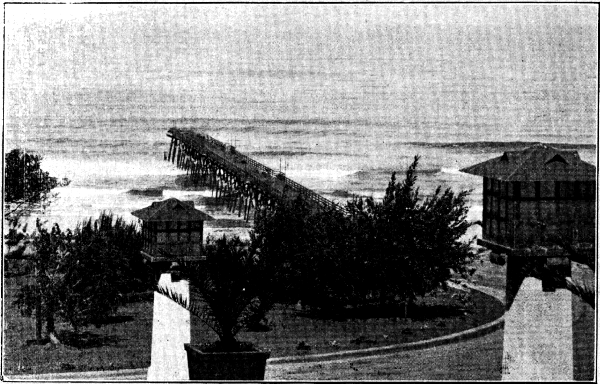 |
| FISHING PIER, DEL MAR |
Del Mar is one of the few beach resorts where the pleasure-seeker can divide his time among the whole range of out-door amusements. The long pleasure wharf and the miles of just that character of beach where the whiting, the croaker, the chub mackerel and the young sea bass love to feed, offer the finest of still fishing. If he is ambitious for a contest with the big fighting fishes of the deeper waters, he can take a boat and soon be floating over the haunts of the yellow-tail, the albacore and the bonito. If he prefers the report of the gun to the music of the reel, a short walk back from the hotel brings him into the country of the game little quail.
Again, he can, by a short ride to the ponds and lagoons, change from upland to waterfowl shooting.
But the gamut is not yet run; for within easy reach are several mountain streams where he can cast his flies on their waters with good returns. And, if he seeks to pit his cunning and his skill against the watchful deer, a pleasant and interesting ride over a good motor road, takes him into the wilds of the Cuyamaca mountains.
But the sportsman in his outings will always think of his comforts as well as his sports, and for those Del Mar has planned with a lavish hand.
It is not all of the enjoyment of a good meal to have a choice selection of viands, admirably cooked by an experienced chef, and served in the most approved manner. It is not all of a good night's rest, after the fatigue of a day's sport, to have lain on a downy bed in a richly appointed room. Agreeable service; the affability of the management; the pervading air of welcome; the society of congenial companions; the beauty of the situation; the inspiring views; the charm of the many scenes that each day photographs upon the memory, adds a relish to the menu which no chef can compound, and a restfulness to one's slumber that the ingenuity of no upholsterer can supply. For a part of these delightful adjuncts to one's enjoyment, I am willing to give credit to the excellent taste of the founders of Del Mar. But the beauty of its surroundings, the possibility of its charming individuality, must be credited to those exclusive gifts which nature first bestowed upon it.
Del Mar is twenty-two miles from San Diego and 111 from Los Angeles, and can be reached from either of these cities by the Santa Fe railroad, or by a good motor road, distinguished for its many interesting views.
 |
| AQUARIUM, VENICE |
That there is but one Venice in America is the verdict of all who have visited this charming sea-side resort. Its oriental architecture, and its numerous canals, on whose surface floats in Italian ease, real Venetian gondolas, give it an atmosphere suggestive of the Mediterranean. But it is not of its Venetian aspect, nor its endless chain of amusements, from its surf and plunge bathing to its rollicking scenic railroad and hair-raising dash through its cavernous rapids, or its hundred or more interesting pastimes for the pleasure seeker, that the attention of the reader is herein directed.
It is to those forms of sea life that contribute to his pleasure that his attention is called, for the waters of Venice furnish a wonderful variety of these, as will be seen by a visit to the large aquarium maintained on the pier by the University of Southern California. From the wharfs he can angle for smelt, mackerel and perch, as well as for halibut and other bottom fishes. From the beach, by bait-casting into the surf, he is rewarded with croaker, whiting (erroneously called corbina), and young sea bass, locally known as sea trout.
By taking a launch and going out into the open water, his ambition to bring to gaff the larger species of the deeper sea can be gratified with strikes from the tuna, the albacore, the bonito, the mackerel and the yellow-tail that will give him a contest worthy of his metal.
These launch trips upon the bosom of the open ocean, are among the chiefest pleasures of our beach resorts, for the angler not only finds keen sport in the landing of these larger fishes, but an exhilarating recreation, restful to the mind and healthful to the body.
Then, when his day's sport is over, whether his outing is only for a day, or for the several weeks of his vacation, His comforts are to be considered. In these Venice offers as wide a range as it does in its amusements. At the splendidly appointed Hotel St. Marks he can find the most luxurious accommodations; he can dine at one of its deservedly popular cafes; or, if he wants to spend his vacation in restful quietude with his family, he can take a furnished villa on the bank of one of the canals, hidden away in a wealth of flowers and forest trees, with the sea breeze tempered to a balmy zephyr. To this sequestered home he can bring his fish, fresh from the sea, and broiling them to his particular taste, enjoy the last delight of the angler's day of sport.
| DOVES— | |
| Mourning Dove, | 40 |
| White-winged Dove, | 40 |
| DUCKS— | |
| American Golden-eye, | 84 |
| American Scaup, | 78 |
| Barrow's Golden-eye, | 90 |
| Blue-bill, | 78 |
| Butter-ball, | 86 |
| Canvasback, | 74 |
| Gadwall, | 56 |
| Harlequin, | 86 |
| Mallard, | 54 |
| Pin-tail, | 66 |
| Red-head, | 76 |
| Ring-neck, | 80 |
| Ruddy, | 82 |
| Scoter, White-winged, | 91 |
| Shoveler, | 68 |
| Spoon-bill, | 68 |
| Sprig, | 66 |
| Teal, Blue-winged, | 64 |
| Teal, Cinnamon, | 62 |
| Teal, Green-winged, | 60 |
| Widgeon, | 58 |
| Wire-tail, | 82 |
| Wood Duck, | 70 |
| FISHES— | |
| Albacore, | 155 |
| Bass, Small-mouthed, Black, | 149 |
| Bass, Striped, | 151 |
| Bass, White Sea, | 167 |
| Bonito, | 157 |
| Croaker, Yellow-fin, | 171 |
| Mackerel, Chub, | 161 |
| Mackerel, Spanish, | 159 |
| Salmon, Chinook, | 130 |
| Sand-sucker, | 169 |
| Skip-jack, | 157 |
| Swordfish, | 165 |
| Trout, Eastern Brook, | 145 |
| Trout, Rainbow, | 135 |
| Tuna, Leaping, | 153 |
| Whiting, California, | 169 |
| Yellow-tail, | 163 |
| GEESE— | |
| Black Brant, | 104 |
| Brown Brant, | 94 |
| Cackling Goose, | 94 |
| Canada Goose, | 94 |
| Emperor Goose, | 102 |
| Honker, | 94 |
| Little White Goose, | 98 |
| Ross Goose, | 98 |
| Speckle-breast, | 100 |
| Snow Goose, | 98 |
| White-cheeked Goose, | 96 |
| White-fronted Goose, | 100 |
| GROUSE— | |
| Oregon Ruffed, | 46 |
| Sage Hen, | 48 |
| Sharp-tail, | 50 |
| Sooty, | 42 |
| PHEASANT, Mongolian, | 36 |
| PIGEON, Band-tailed, | 40 |
| QUAIL— | |
| Arizona, | 18 |
| Bobwhite, Virginia, | 28 |
| California Valley, | 14 |
| Elegant, | 22 |
| Gambel, | 18 |
| Massena, | 26 |
| Montezuma, | 26 |
| Mountain, | 10 |
| Plumed, | 10 |
| Scaled, | 20 |
| SHORE BIRDS— | |
| Avocet, | 124 |
| Curlew, Sickle-bill, | 117 |
| Curlew, Hudsonian, | 117 |
| Dowitcher, | 111 |
| Godwit, | 115 |
| Ibis, White-fronted, Glossy, | 107 |
| Marlin, | 115 |
| Plover, Black-bellied, | 120 |
| Plover, Mountain, | 122 |
| Plover, Ring-neck, | 122 |
| Plover, Snowy, | 122 |
| Snipe, Jack or Wilson, | 111 |
| Snipe, Red-Breasted, | 111 |
| Yellow-legs, | 113 |
| TURKEY, Mexican Wild, | 32 |
| ANATIDAE, family, | 9 |
| ANATINAE, subfamily, | 73 |
| ANSERENAE, subfamily, | 53 |
| ANSERES, order, | 9 |
| BAY AND SEA DUCKS, | 75 |
| CHARADRIDAE, family, | 11 |
| COLUMBIDAE, family, | 11 |
| CYGNINAE, subfamily, | 9 |
| DOVES— | |
| Mourning Dove, | 41 |
| White-winged Dove, | 41 |
| DUCKS— | |
| American Golden-eye, | 85 |
| American Scaup, | 79 |
| Barrow's Golden-eye, | 87 |
| Blue-bill, | 79 |
| Butter-ball, | 87 |
| Canvasback, | 75 |
| Fulvous Tree Duck, | 72 |
| Gadwall, | 61 |
| Harlequin Duck, | 89 |
| Lesser Scaup Duck, | 81 |
| Little Blue-bill, | 81 |
| Long-tailed Duck, | 59 |
| Mallard, | 59 |
| Old Squaw, | 89 |
| Pin-tail, | 69 |
| Red-head, | 77 |
| Ring-neck, | 81 |
| Ruddy Duck, | 83 |
| Scoters, | 89 |
| Shoveler, | 69 |
| Spoon-bill, | 69 |
| Sprig, | 69 |
| Subfamily, genus & species, fresh-water ducks, | 73 |
| Subfamily, genus & species, salt-water ducks, | 92 |
| Teal— | |
| Blue-wing, | 67 |
| Cinnamon, | 65 |
| Green-wing, | 63 |
| Widgeon, | 61 |
| Wire-tail, | 83 |
| Wood Duck, | 71 |
| FISHES— | |
| Albacore, | 156 |
| Yellow-fin, | 156 |
| Bass— | |
| Black, Large-mouth, | 148 |
| Black, Small-mouth, | 148 |
| Striped, | 150 |
| White Sea, | 168 |
| Baracuda, | 166 |
| Bonito, | 158 |
| Croaker—family, genus and species, | 173 |
| Spot-fin, | 172 |
| Yellow-fin, | 170 |
| Jewfish, | 166 |
| Mackerel—family, genus and species, | 162 |
| Chub, | 160 |
| Green-back, | 160 |
| Spanish, | 158 |
| Sacramento Pike, | 150 |
| Salmon, | 131 |
| Salmon—family, genus and species, | 162 |
| Blue-back, | 133 |
| Chinook, | 132 |
| Dog, | 134 |
| Hump-back, | 134 |
| King, | 132 |
| Redfish, | 133 |
| Silver, | 134 |
| Sock-eye, | 133 |
| Sand-sucker, | 168 |
| Skip-jack, | 158 |
| Swordfish, | 164 |
| Trout—family, genus and species, | 147 |
| Colorado River, | 144 |
| Cutthroat, | 142 |
| Dolly Varden, | 144 |
| Eastern Brook, | 144 |
| Golden, | 138 |
| Lake Tahoe, | 143 |
| Lake Southerland, | 143 |
| Rainbow, | 136 |
| Rio Grande, | 143 |
| Silver, | 142 |
| Steel-head, | 140 |
| Tuna, | 152 |
| Whiting, California, | 168 |
| Yellow-tail, | 160 |
| FISHING RESORTS, | 174 |
| Catalina Island, | 175 |
| Del Mar, | 179 |
| Del Monte, | 177 |
| Venice, | 181 |
| GAME BIRDS OF THE PACIFIC COAST, | 9 |
| GAME FISHES OF THE PACIFIC COAST, | 129 |
| GAME FISHES OF THE SEA, | 152 |
| GEESE OF THE PACIFIC COAST, | 93 |
| GEESE, FAMILY, GENUS AND SPECIES, | 53 |
| Black Sea Brant, | 103 |
| Brown Brant, | 97 |
| Cackling Goose, | 97 |
| Canada Goose, | 93 |
| Emperor Goose, | 101 |
| Honker, | 93 |
| Hutchins Goose, | 97 |
| Little White Goose, | 99 |
| Ross Goose, | 99 |
| Speckle-breast, | 101 |
| Snow Goose, | 99 |
| White Goose, | 99 |
| White-cheeked Goose, | 95 |
| White-fronted Goose, | 101 |
| GROUSE—Family, genus and species, | 43 |
| Canadian Ruffed, | 47 |
| Oregon Ruffed, | 45 |
| Sage Hen, | 51 |
| Sharp-tail, | 52 |
| Sooty, | 44 |
| Spruce, | 49 |
| PHEASANT, Mongolian, | 35 |
| PIGEON, Wild, | 39 |
| PIGEONS AND DOVES, | 39 |
| QUAIL—Family, genus and species, | 11, 30 |
| Arizona, | 19 |
| Bobwhite, | 27 |
| Bobwhite, Masked, | 29 |
| California Valley, | 15 |
| Elegant, | 24 |
| Gambel, | 19 |
| Massena, | 25 |
| Montezuma, | 25 |
| Mountain, | 12 |
| Lower California, | 13 |
| Plumed, | 12 |
| San Pedro Mountain, | 13 |
| Scaled, | 21 |
| Chestnut-bellied, | 23 |
| SHORE BIRDS—Family, genus and species, | 110, 118 |
| Avocet, | 125 |
| Cranes, Rails and Gallinules, | 109 |
| Curlew, Sickle-bill, | 119 |
| Hudsonian, | 119 |
| Dowitcher, | 112 |
| Godwit, | 114 |
| Herons and Ibises, | 108 |
| Marlin, | 114 |
| Plover, family, genus and species, | 126 |
| Black-bellied, | 121 |
| Mountain, | 121 |
| Ring-neck, | 123 |
| Snowy, | 123 |
| Wilson, | 125 |
| Rails, | 109 |
| Sandpiper, Red-backed, | 116 |
| Snipe, family, genus and species, | 118 |
| Jacksnipe, | 110 |
| Red-breasted, | 112 |
| Wilson, | 110 |
| Stilt, Black-necked, | 127 |
| Willet, | 116 |
| Yellow-legs, | 114 |
| SWANS, | 105 |
| TUNA CLUB, | 172 |
| TURKEYS, Wild, | 31 |
| Mexican, Wild, | 31 |
| WATERFOWL, | 55 |
| WADERS AND SHORE BIRDS, | 106 |
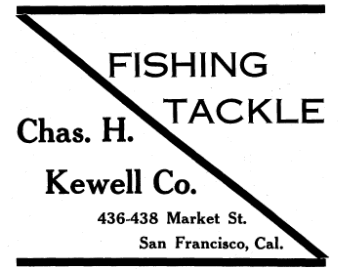
| KEWELL- STEWART SPOON |
KEWELL- LAFORGE SPINNER |
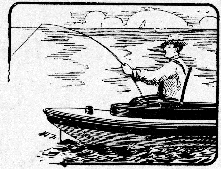
Tufts-Lyon Arms Co.
Sporting Goods
GOOD SHOOTING GOODS
Special Tuna
Los Angeles, California
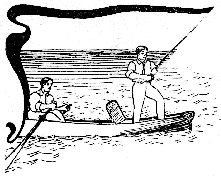
|
|
||||||||||||||||||||||||||||||||||
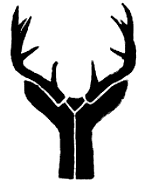 |
I Mounted The African Collection OF Stewart Edward White |
| If You want high grade taxidermy send me your trophies. |
|
| Albert E. Colburn | |
| 806 South Broadway | |
| LOS ANGELES, CALIF. | |
| A KODAK | ||
| is as necessary to your hunting outfit as your gun, and a shot with it often far more satisfactory because it is |
||
| A LASTING PLEASURE | ||
| Everything you need in the Kodak Line will be found at the |
||
| Earl V. Lewis Company | ||
|
||
| Bring your films for developing and printing |
The text presented here is that contained in the original printed version. Other than the typographical corrections listed below and a number of minor corrections, the following changes were introduced:
| 1) Paragraphs split by illustrations or tables were rejoined. | |
| 2) The illustrations were placed above the section describing the species illustrated. | |
| 3) The following errata notes displayed on the bottom of pages 112, 114 and 116 in the original publication have been applied: | |
| "In the make-up of a few pages on the shore birds, the
scientific names have become transposed. They should read: Page 112: Dowitcher (Macrohampus scolopaceus). Page 114: Yellow-legs (Totanus melanoleucus). " " : Marlin (Limosa fedora). Page 116: Red-backed sandpiper (Tringa alpina pacifica). " " : Willet (Symphemia Semipalmata inornata)." |
|
| 4) There appears to be text missing under the description of
"WILSON'S PLOVER" in the "Measurements" section on page 125. A note was inserted to that effect |
|
| 5) The Æ ligature which was used in the caption of the image on page 122 has been changed to the letters "AE" for consistancy with the way those names are displayed elsewhere in the book. | |
| Page | Correction | |
| 11 | Banapart ⇒ Bonapart | |
| 61 | "Male" added for consistancy | |
| 66 | Spatula acuta ⇒ Dafila acuta | |
| 77 | Aythya amaricana ⇒ Aythya americana | |
| 98 | Chen rossi ⇒ Chen rossii | |
| 108 | Plegadis gaurauna ⇒ Plegadis guarauna | |
| 108 | Gaura alba ⇒ Guara alba | |
| 109 | Grus mericana ⇒ Grus canadensis | |
| 109 | GALLINUL ⇒ GALLINULES | |
| 109 | Grus mericana ⇒ Grus americana | |
| 121 | Charadrous squaterola ⇒ Charadrius squatarola | |
| 125 | AVOSET => AVOCET | |
| 136 | Loch Loven ⇒ Loch Leven | |
| 167 | Cygnocian nobilis ⇒ Cygonoscion nobilis | |
| 172 | SPOT-FIN CRAOKER ⇒ SPOT-FIN CROAKER |
